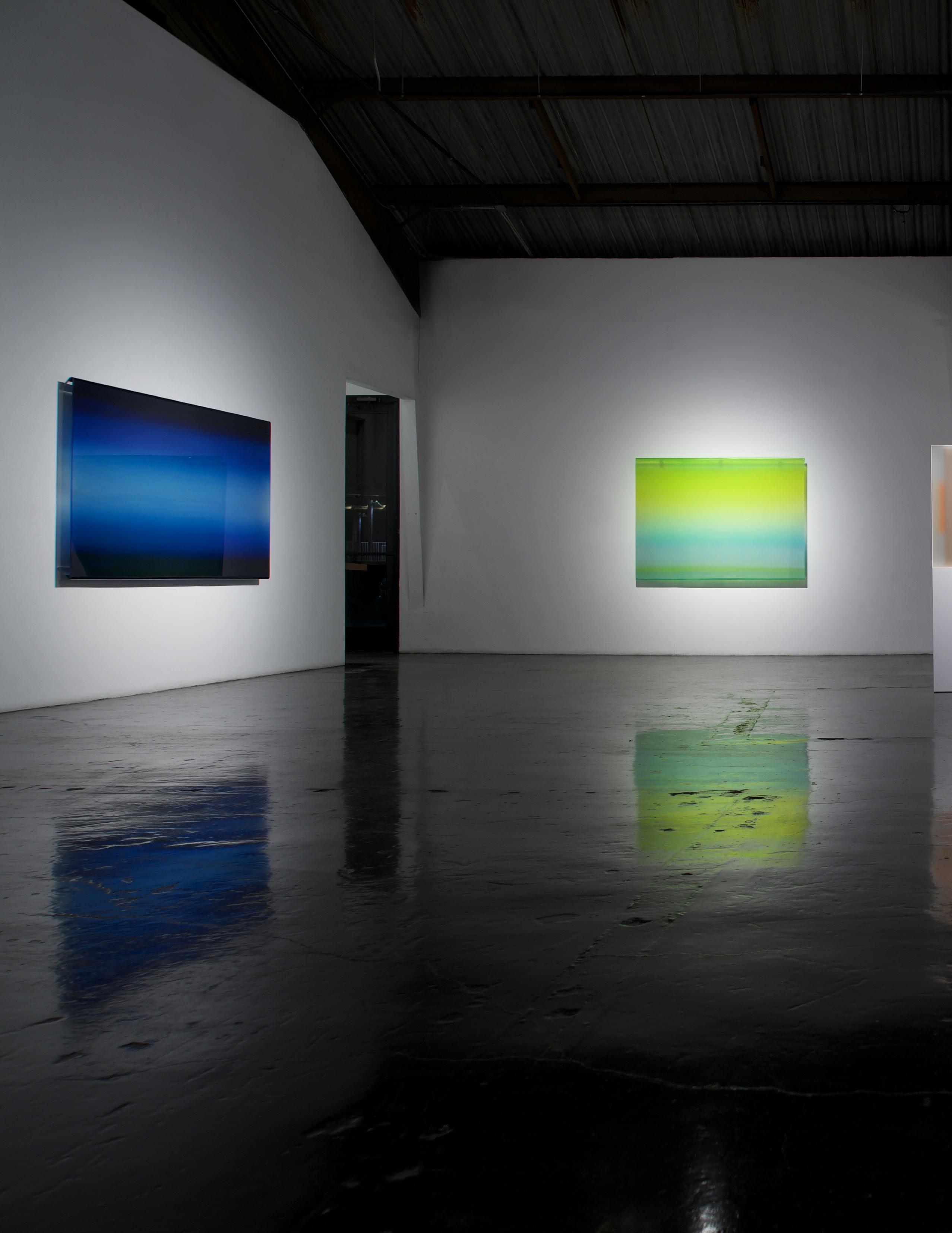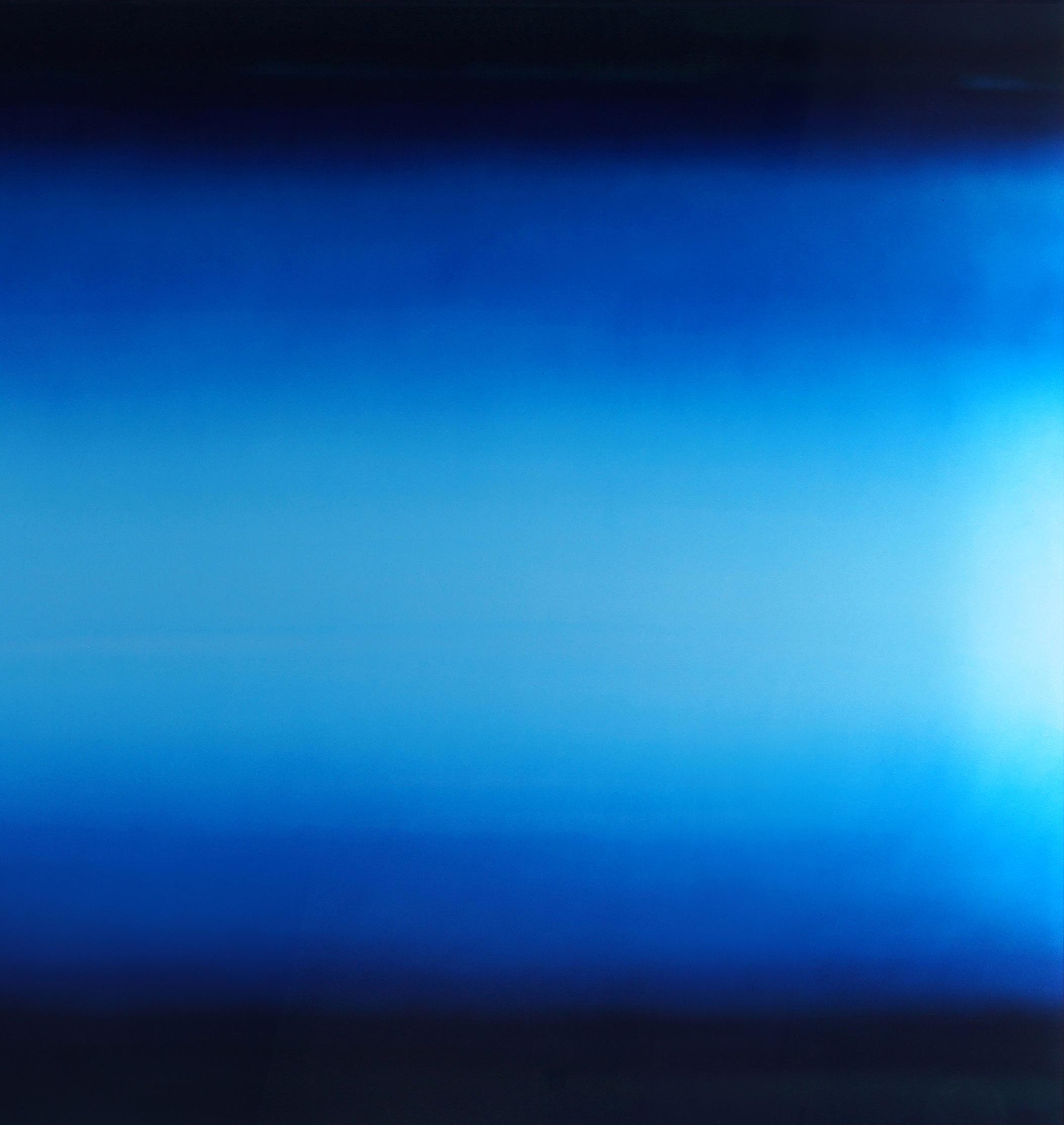CASPER BRINDLE NUMINA

WILLIAM TURNER GALLERY

WILLIAM TURNER GALLERY
Copyright: William Turner Gallery 2025




WILLIAM TURNER GALLERY

WILLIAM TURNER GALLERY
Copyright: William Turner Gallery 2025




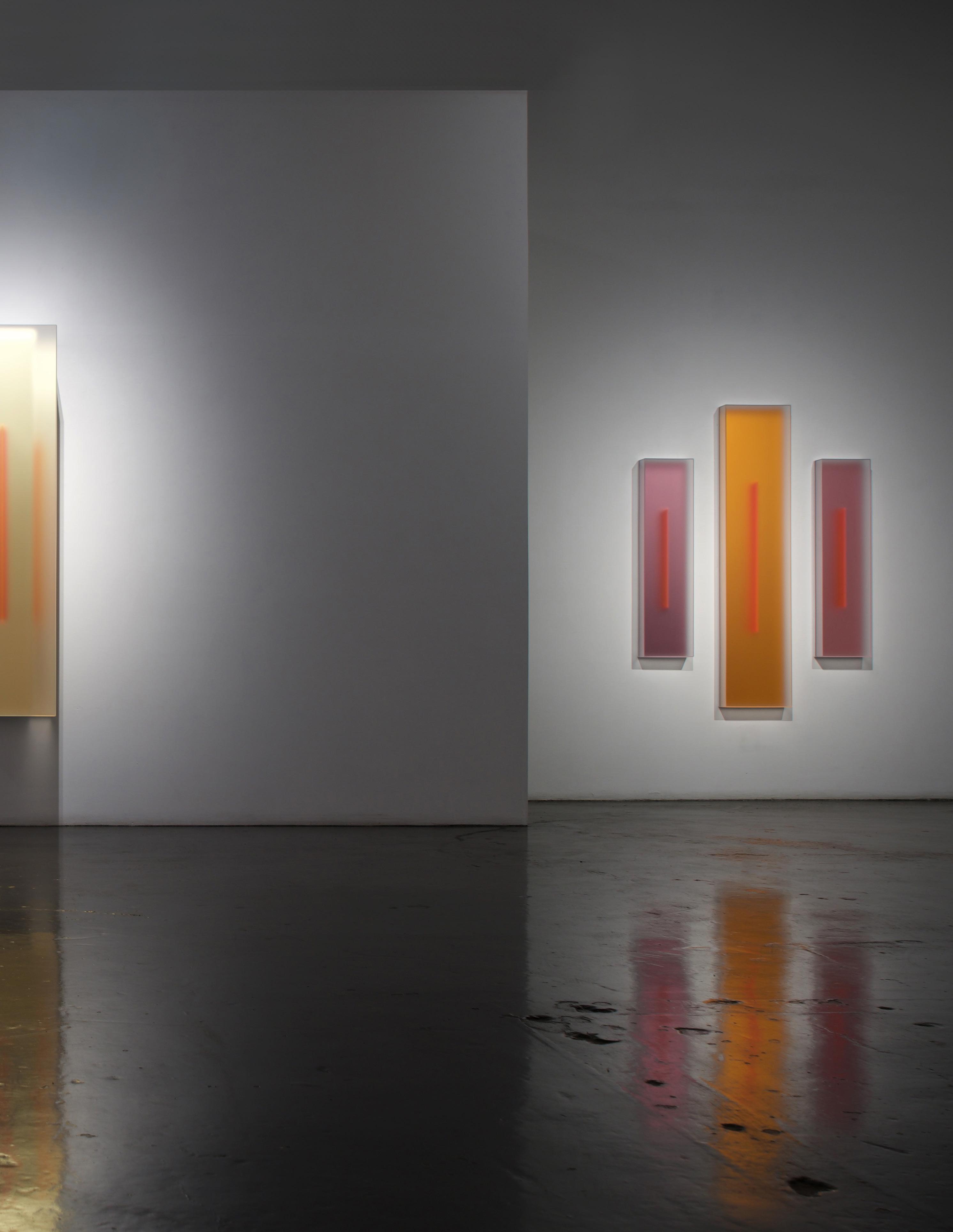

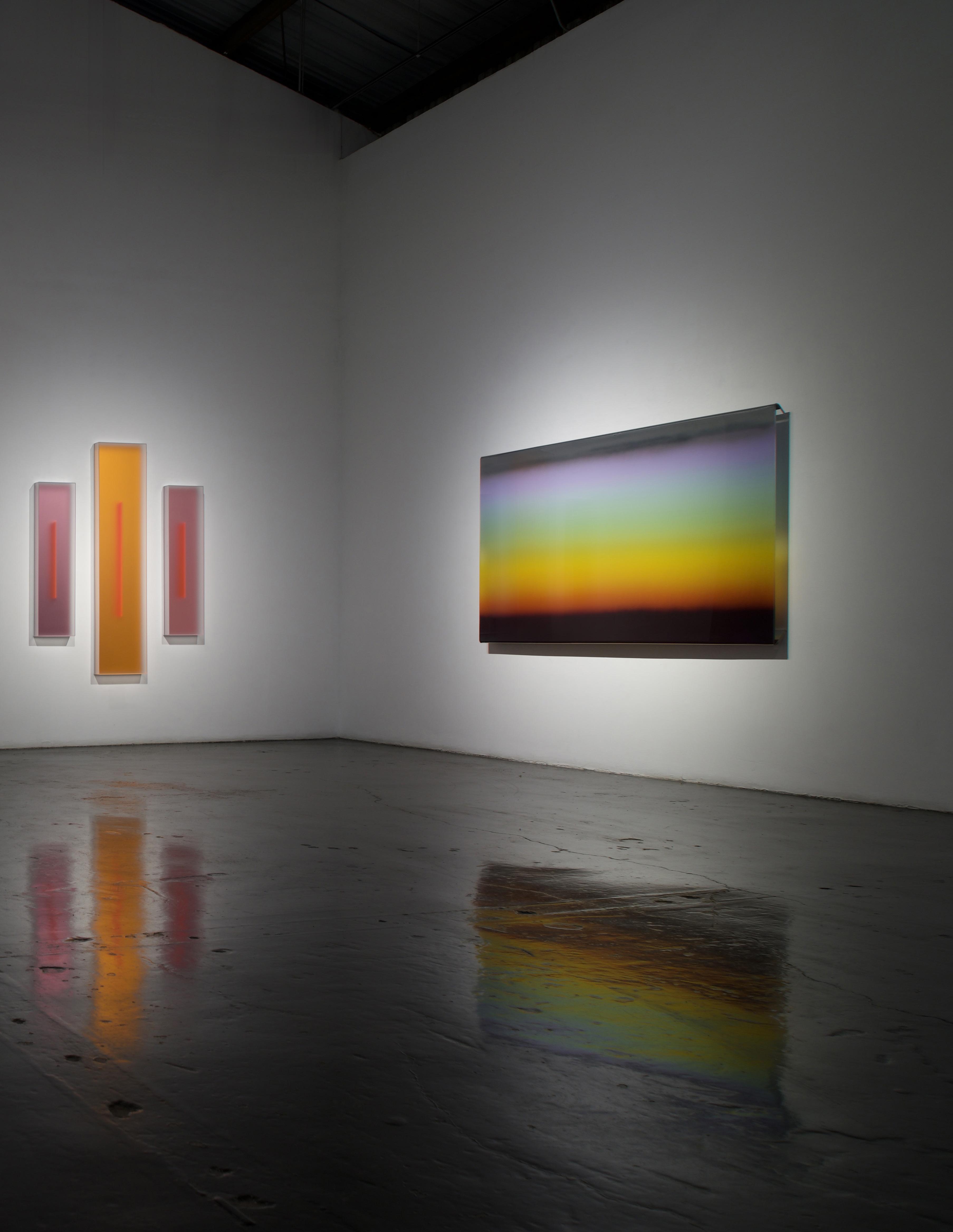
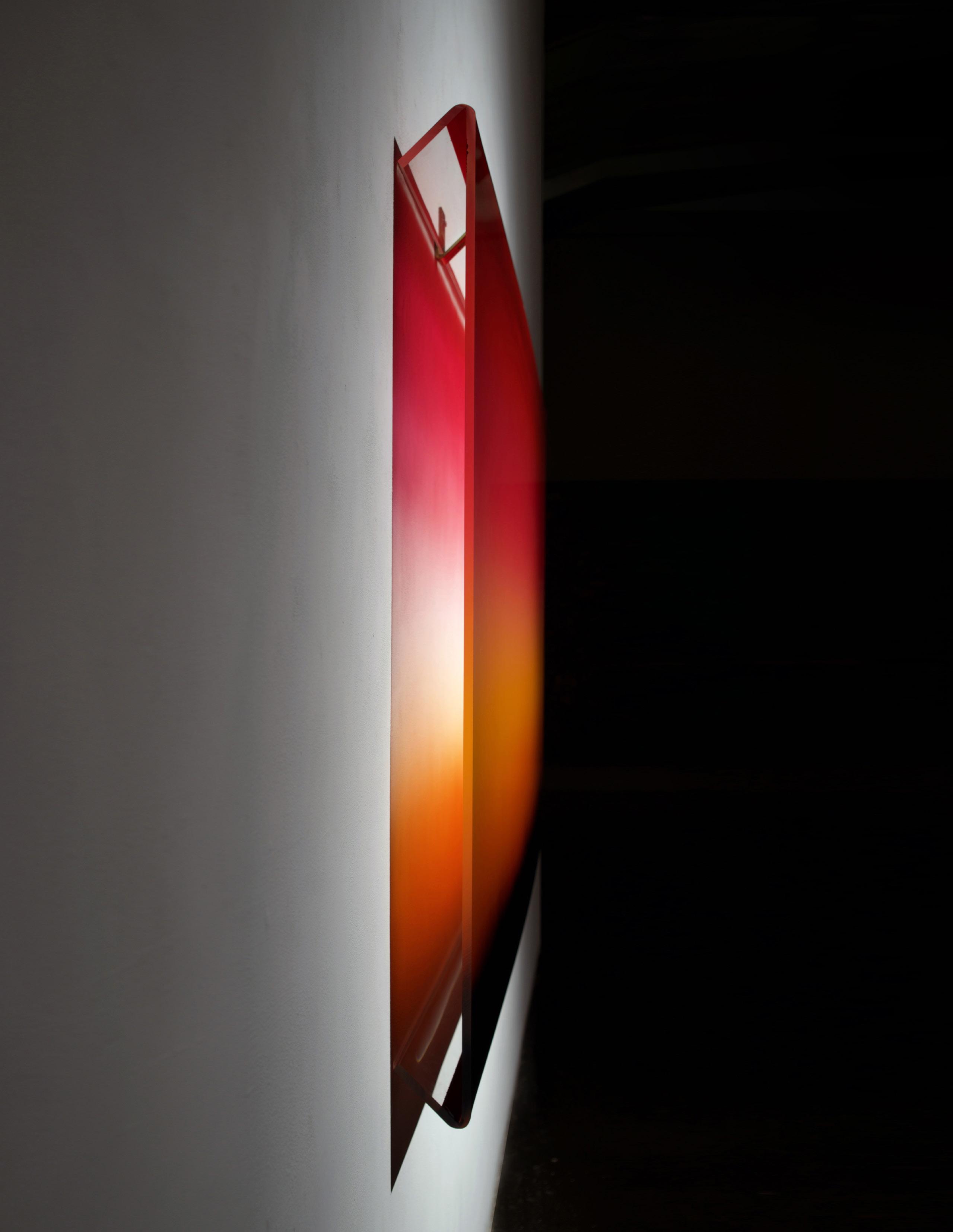
Our hearts go out to everyone affected by the recent Palisades and Altadena fires, and William Turner Gallery stands in solidarity with the Los Angeles community as it starts to heal.
In light of the devastating fires, William Turner Gallery made the decision to postpone the “Numina” opening by one week, prioritizing reflection, support, and collective resilience.
Art has always been a source of solace and strength. Gathering at the “Numina” opening a week later than initially planned, we not only celebrated art but also came together in a spirit of hope and renewal.

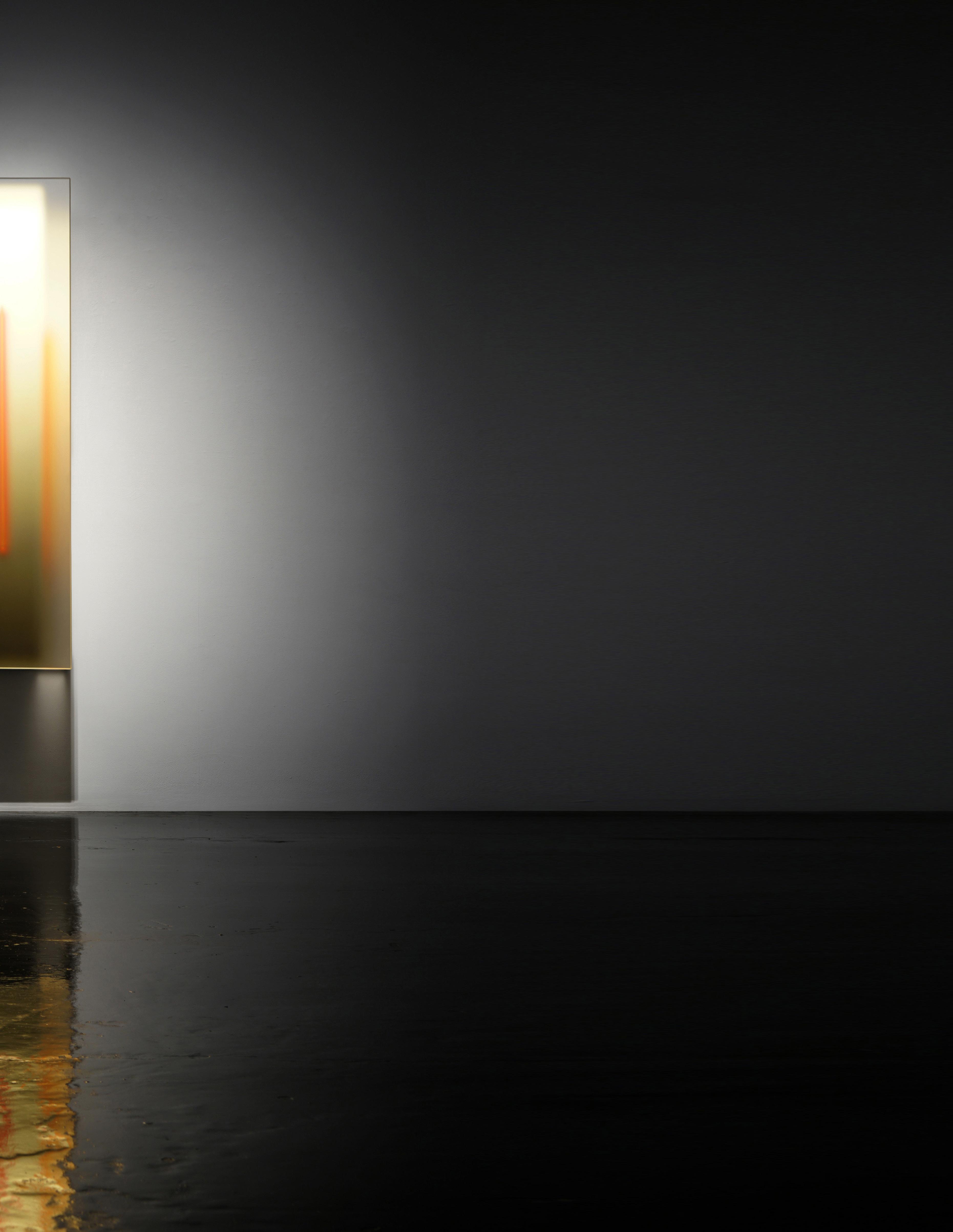

Casper Brindle is a maestro of refracted color. The affinity is both deeply intuitive and rigorously cultivated, the years spent in refinement of his craft evident in the lushly captivating effects he conjures from his materials. Entering the space of Brindle’s new exhibition, titled “Numina,” at William Turner Gallery, provides an immediate, strangely hushed immersion into his vision: his colors –applied to and filtered through various planes of clear acrylic – seem to glow, glimmer, radiate. They float like some dazzling color field mirage, gathering at dusk, or rising languidly off the Pacific as the marine layer dissipates in the warmth of sunlight. If you locked Mark Rothko, Peter Halley and Olafur Eliasson in a studio together with plenty of clear plastic, refractive paint and West Coast herbal supplements, this is what you might end up with.
Inspired by the state’s ineffable coastal light and environment (and abetted ironically by the region’s wealth of aerospace-related industries), Light and Space is truly a home-grown Southern California genre. Brindle’s journey into that ethereal terrain was
indirect, starting with a stint working as a studio assistant for artist Eric Orr in his youth, followed by captivating encounters with the works of James Turrell and Dan Flavin at MOCA in the early 1990s.
Instead of thinking of their work as an object to be observed, the new Light and Space artists began to see their work as a catalyst for the experience of observing itself. Materials such as acrylic, resin, high-end automotive paints and highly polished surfaces all aided in the creation of dynamic, colorshifting, mind bending experiences inherent to engaging with the work. Artists such as Helen Pashgian, De Wain Valentine, Fred Eversley and Larry Bell, as well as fabricator Jack Brogan, all pioneered unique uses of new materials. Brindle has similarly had to come up with his own skillsets and techniques, laboriously evolving his material lexicon through frequent failures and experimentation. The result is an unusual level of technical finesse, as befits his obvious affection for Southern California’s “Finish Fetish” legacy.
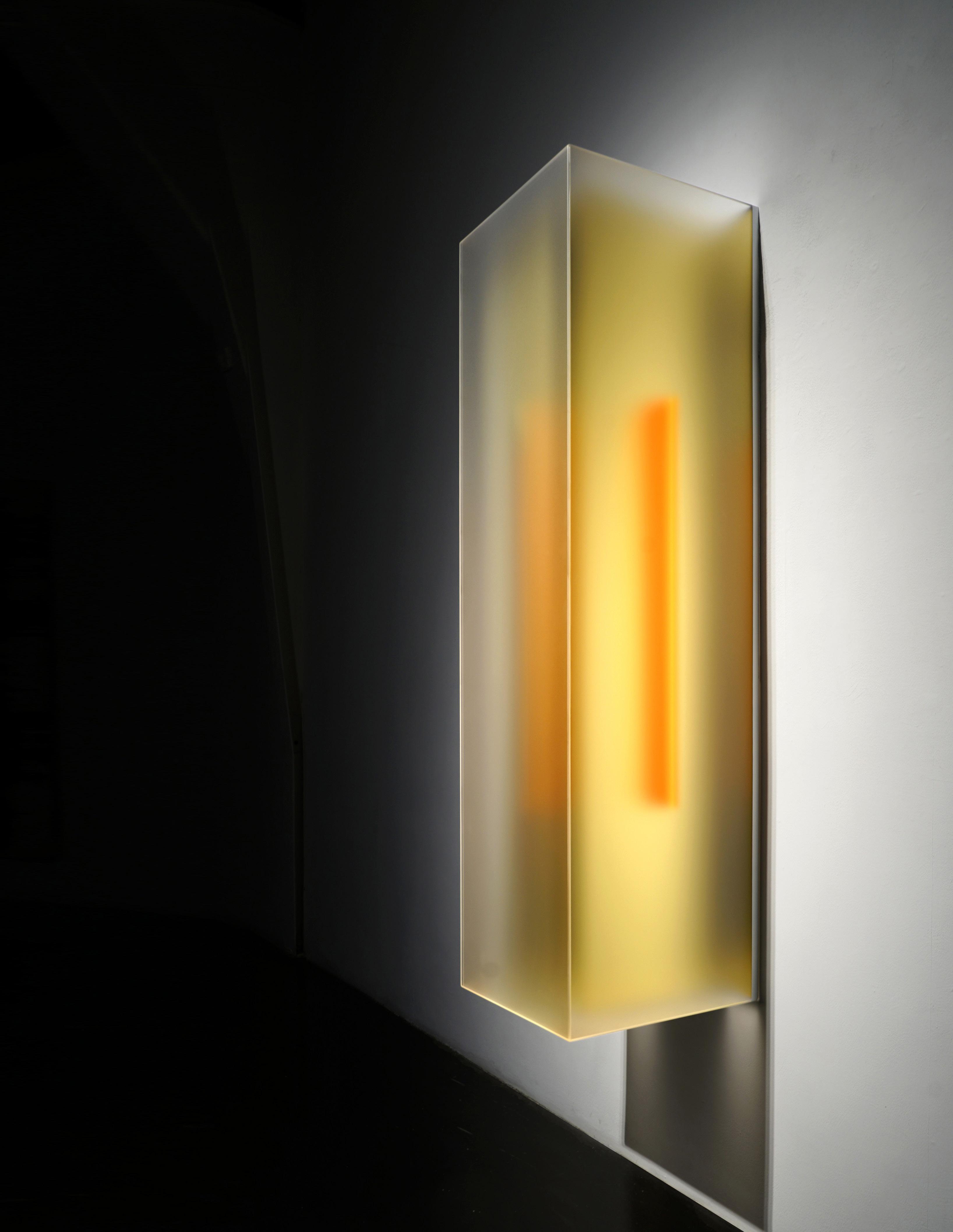
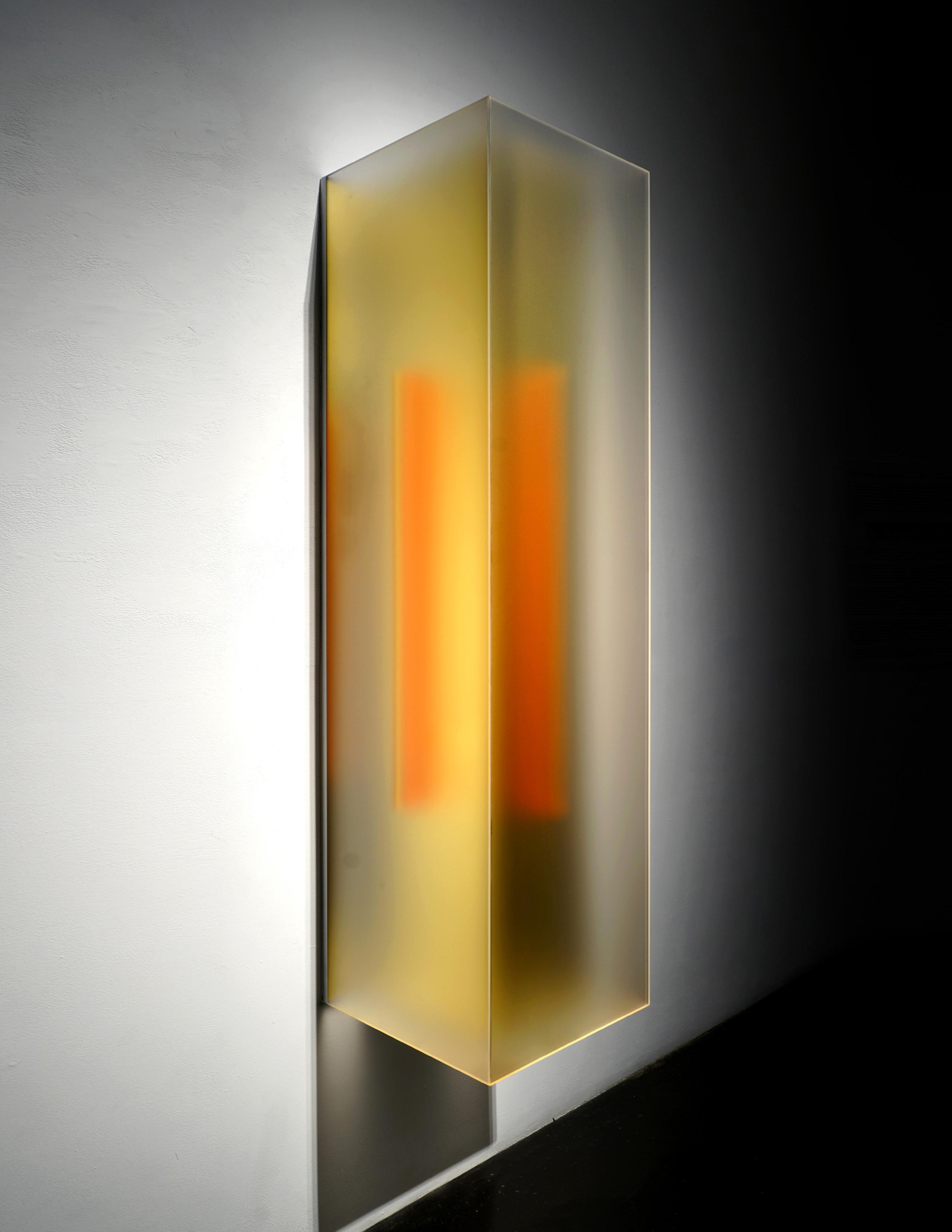
And even then Brindle continues to challenge himself: since 2000, he’s created at least ten distinct series, each with their own unique format, often blurring the boundaries between painting and sculpture. Yet they’ve all come to embrace a central tenet of the Light and Space movement, using the finished object as a catalyst to the viewers’ own perceptual experience, at once drawing them outward into the space around them and inward into their own sensory response, in that delicious paradox of the senses.

By then, Brindle’s glyph forms had already begun to outgrow the canvas, emerging into the gallery as threedimensional forms. Featuring tinted filaments set within translucent vertical rectangles, the new format allowed light to actually pass through them, via refractive paints that transmuted it into a beguiling gamut of nuanced colors that seem to shift and shimmer.
His new show offers several variations of these Light Glyph sculptures: some vacuum-formed, some with three filaments, some grouped in triptychs. Some with hard geometric corners and others with rounded edges that feel organic and seductive. Flaunting a charmingly low-tech, Minimalist sci-fi panache that would not be out of place on an episode of Star Trek (the original or TNG), they offer a glorious spectrum of unlikely metallic colors that are nothing short of sumptuous and yet seem to come out of a nature guide: pine green, tangerine, hyacinth.
While the artist’s recent works increasingly invoke allusions to pure abstraction, their roots in natural phenomena and in landscape are never far from the surface. In his Dislocated Stratum Paintings, shown in 2017 at William Turner, his flirtation with the ocean was overt, as misty blues and yellows emerged and faded into the horizon line, melding washy textures with the stark infinitude of a Sugimoto seascape. His Portal Glyph Paintings, shown at the Luckman Fine Arts Complex in 2022, bisected those planes with a vertical rectangular element, invoking the stoic gravitas of the monolith in Kubrick’s 2001. Applied in gold leaf, and obliquely recalling Barnett Newman’s fabled ‘zips’ these glyph forms suggested a source of divine energy. But they also charged the works with an almost electrical frisson, recalling a more open counterpoint to Peter Halley’s celebrated Neo-Geo paintings of the 1980s and their infamous “cells.”
The hues shift slightly as one walks around them, an effect abetted by the use of dichromatic automotive paints; dimming the gallery’s lights, they seem to glow. Set out in rows, they confront their viewers with alluring but totemic authority. Call them batteries, filaments or conduits, they transcend static geometry to channel light and energy. The result is at once bold and subtle, luxuriant yet distilled, thrilling and yet soothing, like some chromatic atomizer or sativa-based stimulant for the optic nerves.
Brindle’s ambitious new Veil Paintings, which he premieres with this exhibition, extend his vision into nearly IMAX format. Offering vaporous strata of vibrant color, they look as much to the essence of pure color, and perhaps unintentionally, postwar abstraction, as the views beyond his Venice studio. Inevitably, these new paintings invoke Rothko’s washy rectangular clouds, stretched out lengthwise into diaphanous landscape format. And the colors! Juxtaposed giddily, no longer tethered to the naturalistic, their vigorous chromatic interplay recalls the territory staked out by Josef Albers and Hans Hofmann, evoking Hofmann’s famous “push-pull” – as brilliant primary and secondary colors jostle against each other, receding and emerging and dissolving in spatial dialogue with the viewer.
A theorist as much as a painter, Hofmann saw color not merely as a source of aesthetic pleasure or scientific inquiry but as deeply enriching to the human spirit. “The reciprocal relation of color to color produces a phenomenon of a more mysterious order. This new phenomenon is psychological,” he wrote, in 1948. “Color stimulates certain moods in us. It awakens joy or fear in accordance with its figuration. In fact, the whole world, as we experience it visually, comes to us through the mystic realm of color. Our entire being is nourished by it.”
Those colors need not always be cheerful or benign. In numerous works, his heightened, super-saturated colors take on an almost alarming intensity. By chance, the installation of Brindle’s current show coincided with the terrible firestorms that swept through Altadena and the Palisades in mid-January. Amid the fires, he stepped outside to witness an extraordinary sunset, beyond the typical smog-infused sunsets common to Los Angeles, creating an almost apocalyptic atmosphere. Returning to the studio, he created the work titled Veil I, depicting layers of fearsome pink and orange hovering over a charred and blackened ground – a distinctly menacing and sadly accurate observation on the state of the natural landscape in Los Angeles in 2025.
Extending forward into three dimensions, the format of the new Veil series lends his palette extra vibrancy, featuring layers of paint applied to the backs of clear acrylic sheets which are curled in at their tops and bottoms to allow the light to flow through them and refract back out into the surrounding space. Because Brindle applies his pigments to the backs of the surfaces, he has to start with the finishing details then builds to the base, in a reversal of the usual process.
In that spirit, one can consider these works a form of meditation, celebration – a revelation of the luminous reality underlying our quotidian existence.
- George Melrod
Yet as much as Brindle’s exuberantly illusive works draw the viewer into their space, into the present moment, there remains something otherworldly about them. Portals and glyphs –totems of illumination. For all their lustrous sensuality, the works suggest a ritualistic spiritual undercurrent. In channeling light and color, they imply a joyful communion with the physical world, capturing unseen energy and refracting it back to us to reflect on. The color field equivalent of lightning in a bottle. The show could well be titled “Lumina,” but instead it’s called “Numina” – a word denoting spirits or deities. An invocation of divine energy, or perhaps more simply what Rothko called “transcendental experiences.”
George Melrod has written extensively about contemporary art for magazines such as Art in America, Art & Antiques, and Sculpture, and websites like artcritical and artillery. From 2006-17, he was the editor-in-chief of art ltd. magazine.

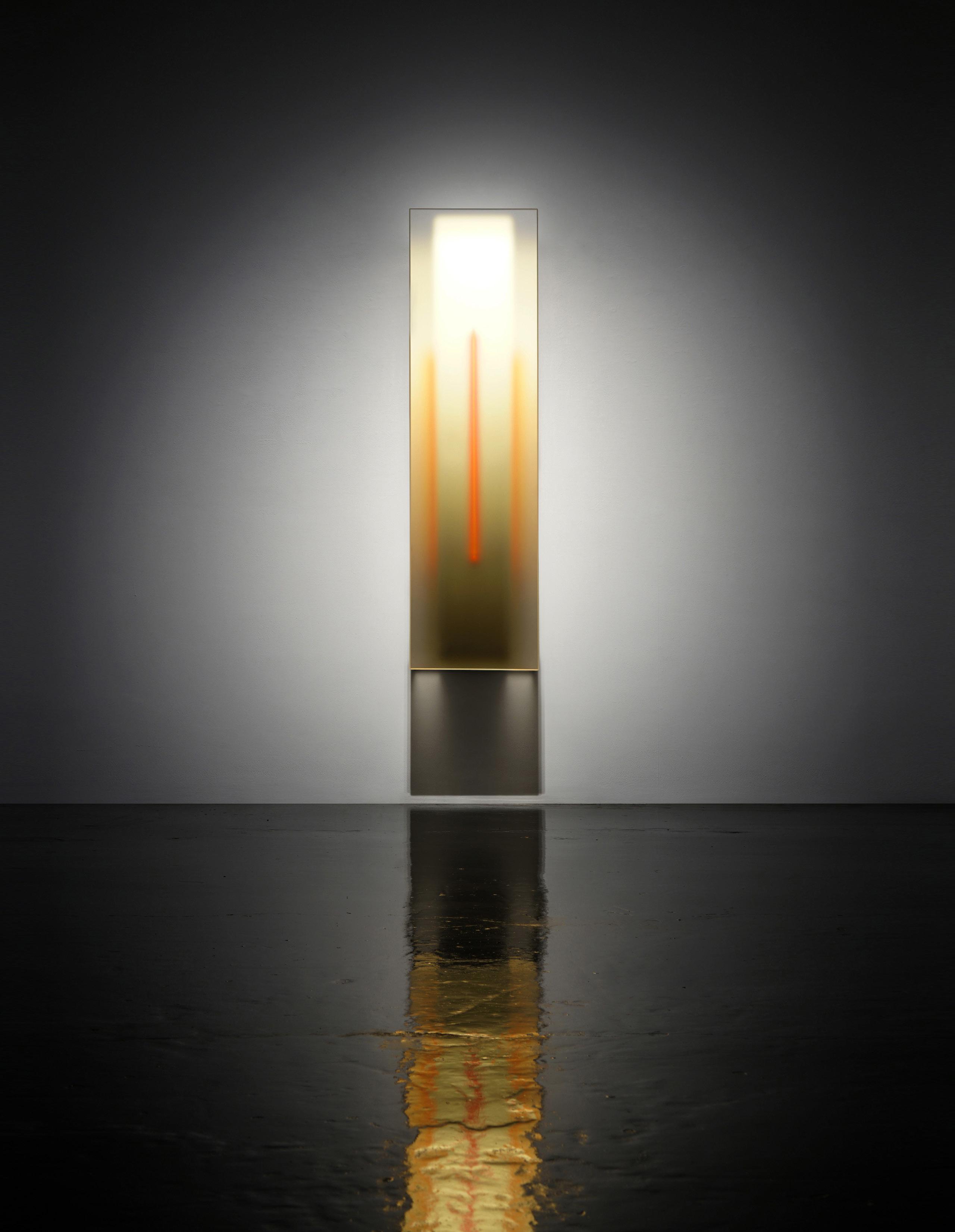
Light-Glyph (Trilateral Gold)
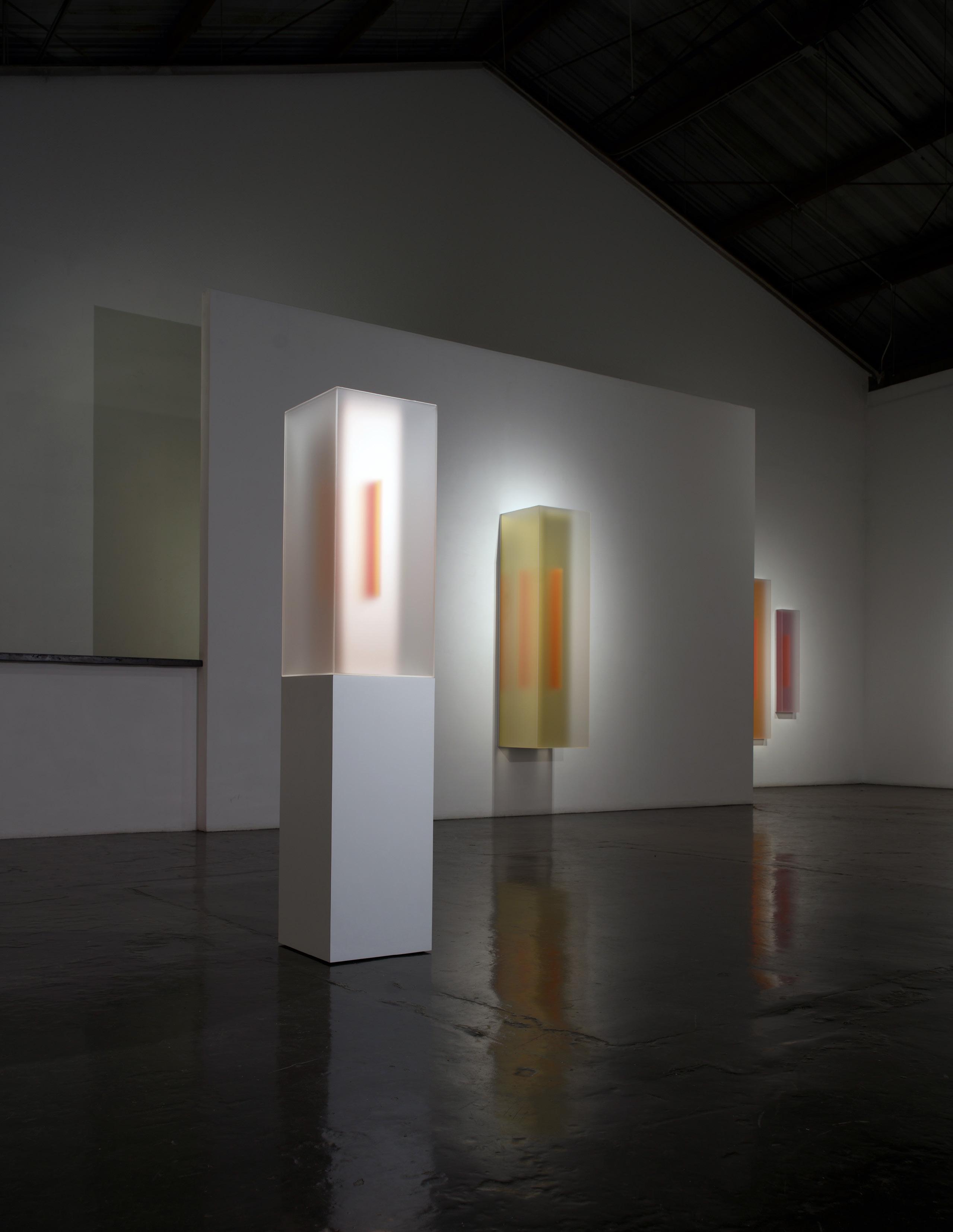
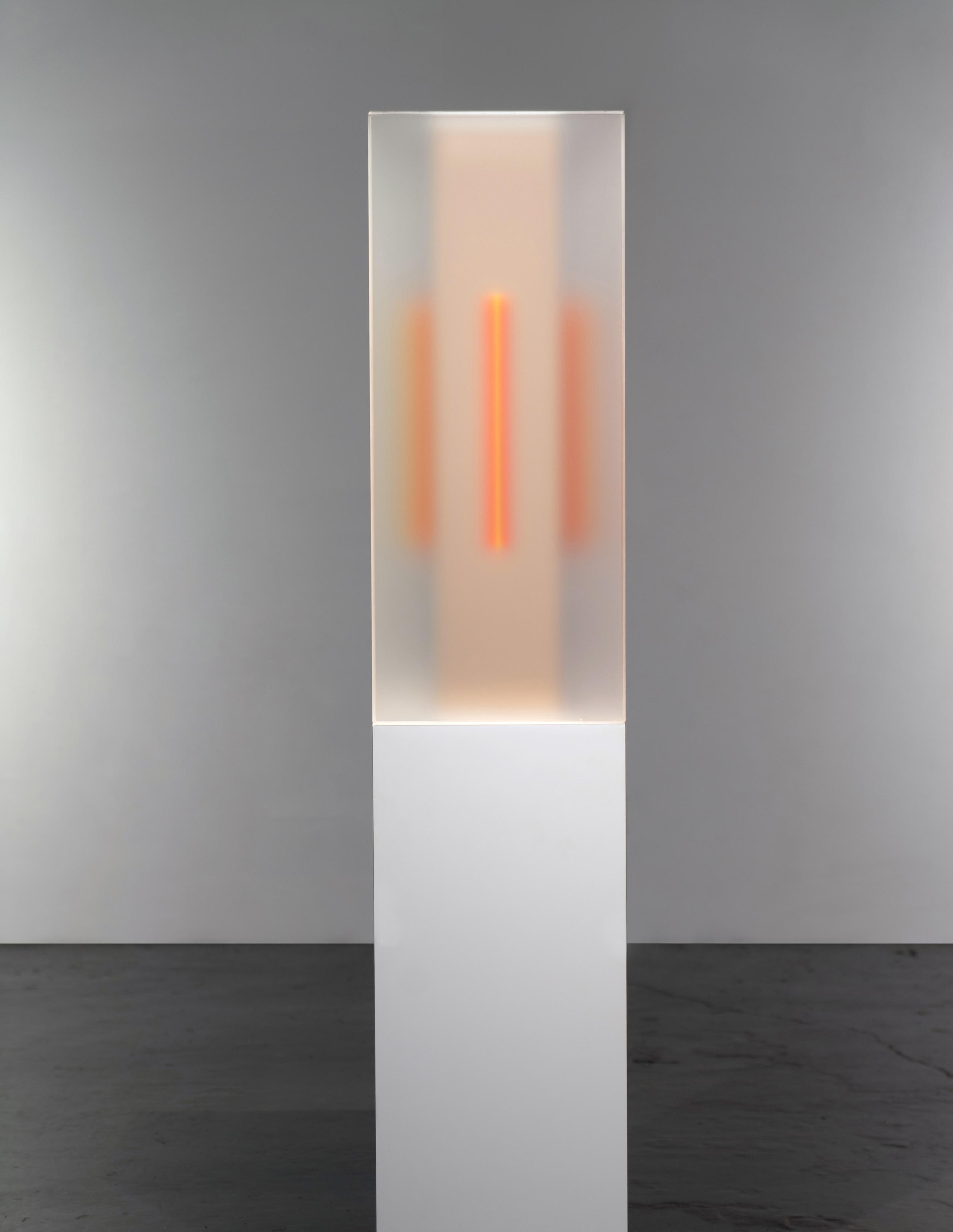

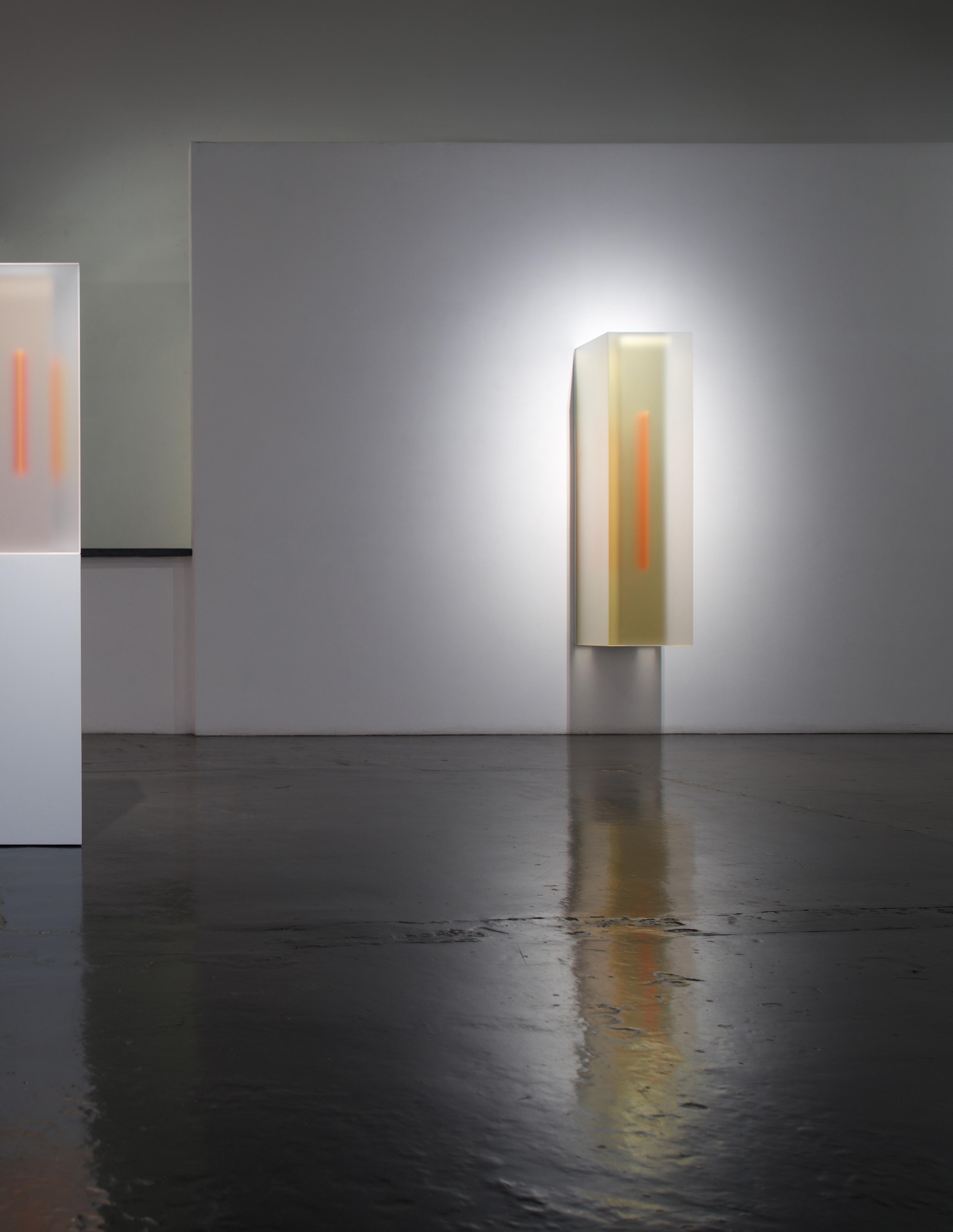
Casper Brindle refers to his latest series as Veils , a poetic nod to the interplay between concealing and revealing. Painted on the reverse side of clear sheets of pristine acrylic, the Veil paintings hover between transparency and opacity. Viewed head on, Brindle’s Veils appear as opaque washes of saturated color, their surfaces smooth and impeccably finished. Viewed from the side, one discovers their magical, multicolored shadows.
With sculptural grace, the tops and bottoms of the Veils curl backwards, lifting the painted surfaces 4-5 inches off the wall. This separation reveals their translucency, with the walls behind the Veils glowing with richly colored shadows from the light shining through. This phenomenon imbues the space surrounding the Veils with a dynamic interplay of color and light. The shadows themselves seem to possess an inner glow, a testament to Brindle’s masterful manipulation of translucency and material. At the heart of the Veils series is Brindle’s fascination with light, an element that has long informed his art practice. Drawing inspiration from the distinctive quality of light in Los Angeles, Brindle crafts works that can transform even an ambient glow into something mystical.
As with Brindle’s Light Glyphs , the Veils invite viewers to engage with them from multiple perspectives. It is in this delicate balance—between what is hidden and what is revealed—that Brindle’s work finds its most profound resonance, transforming the act of viewing into an exploration of light, color, and perception.
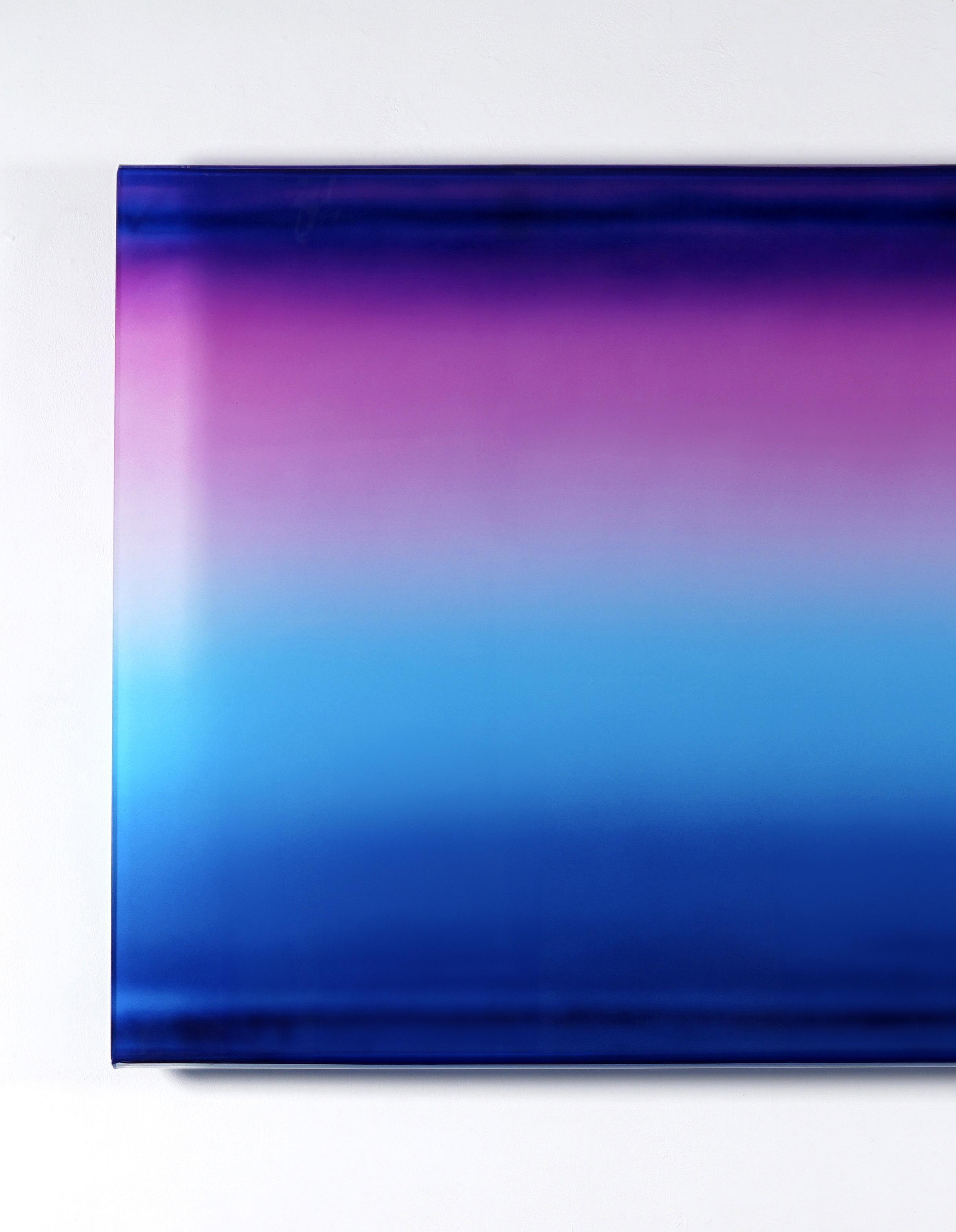
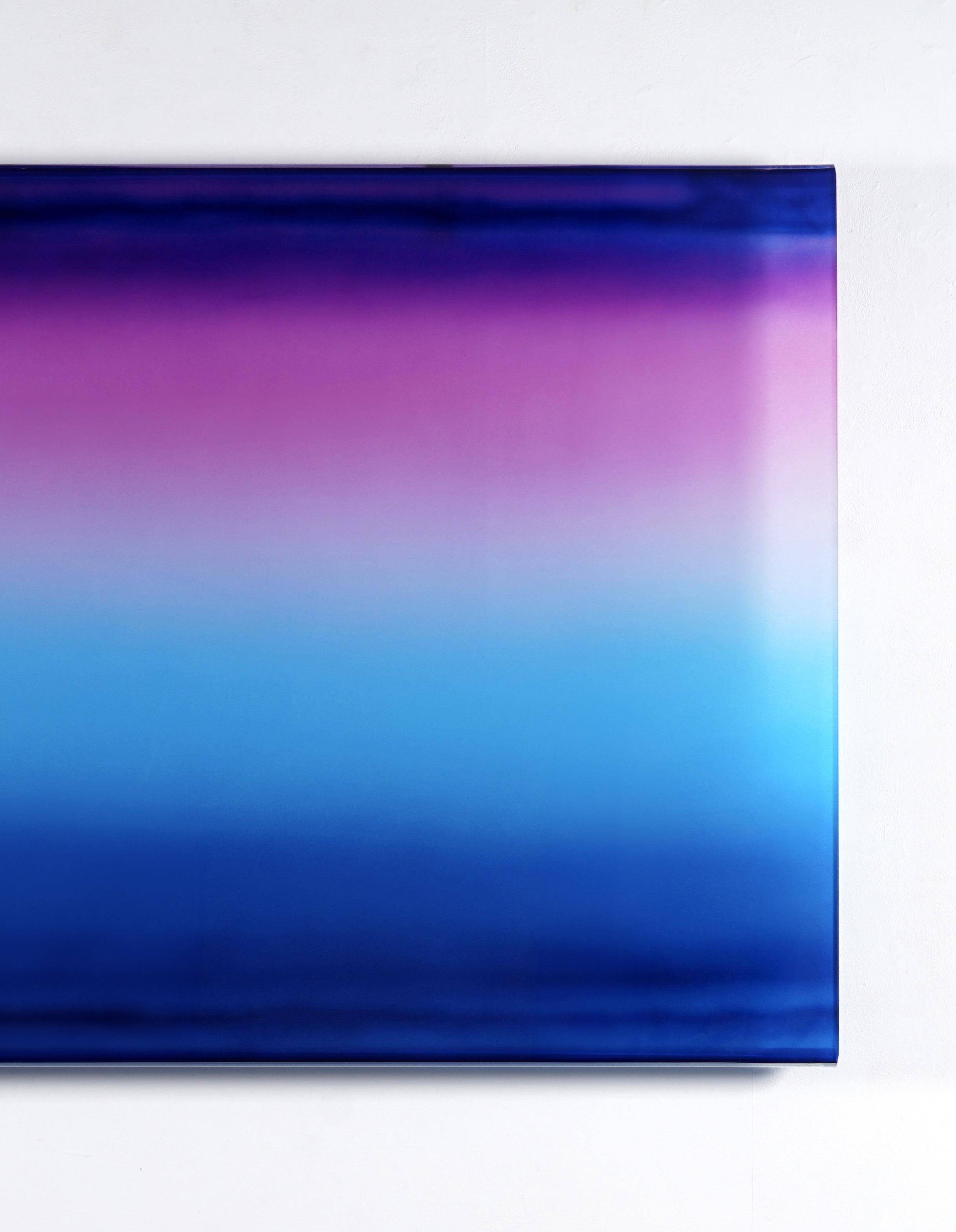

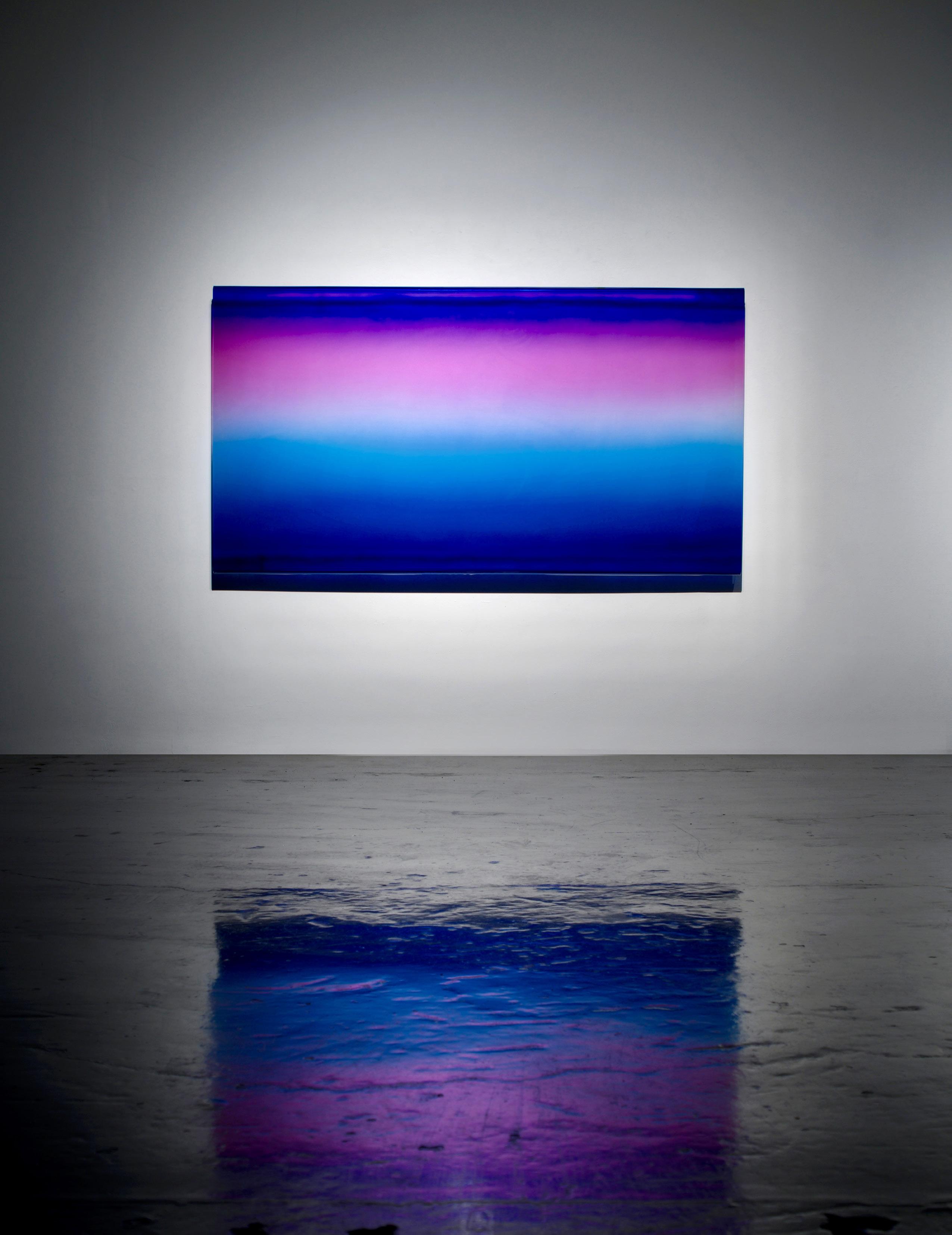
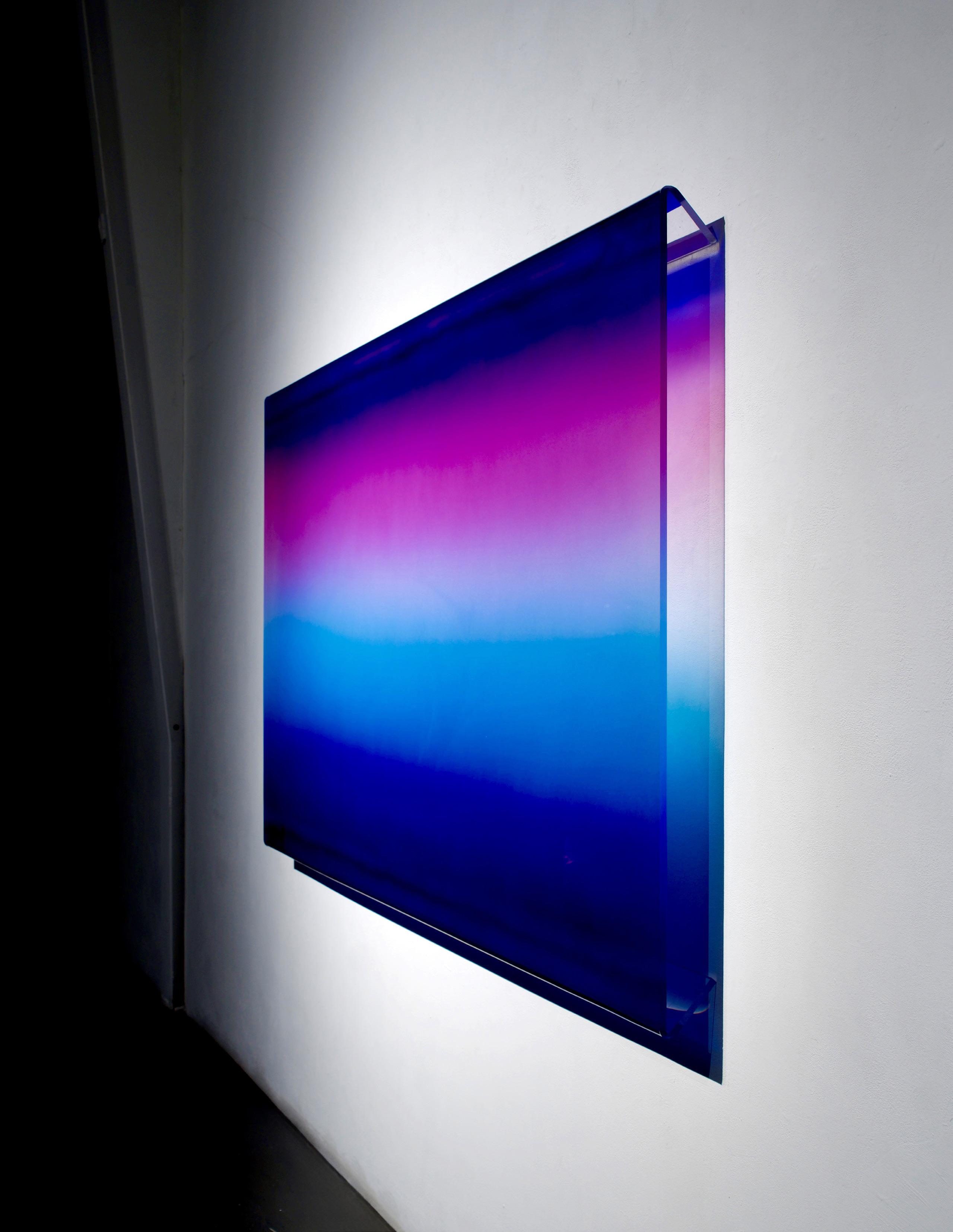

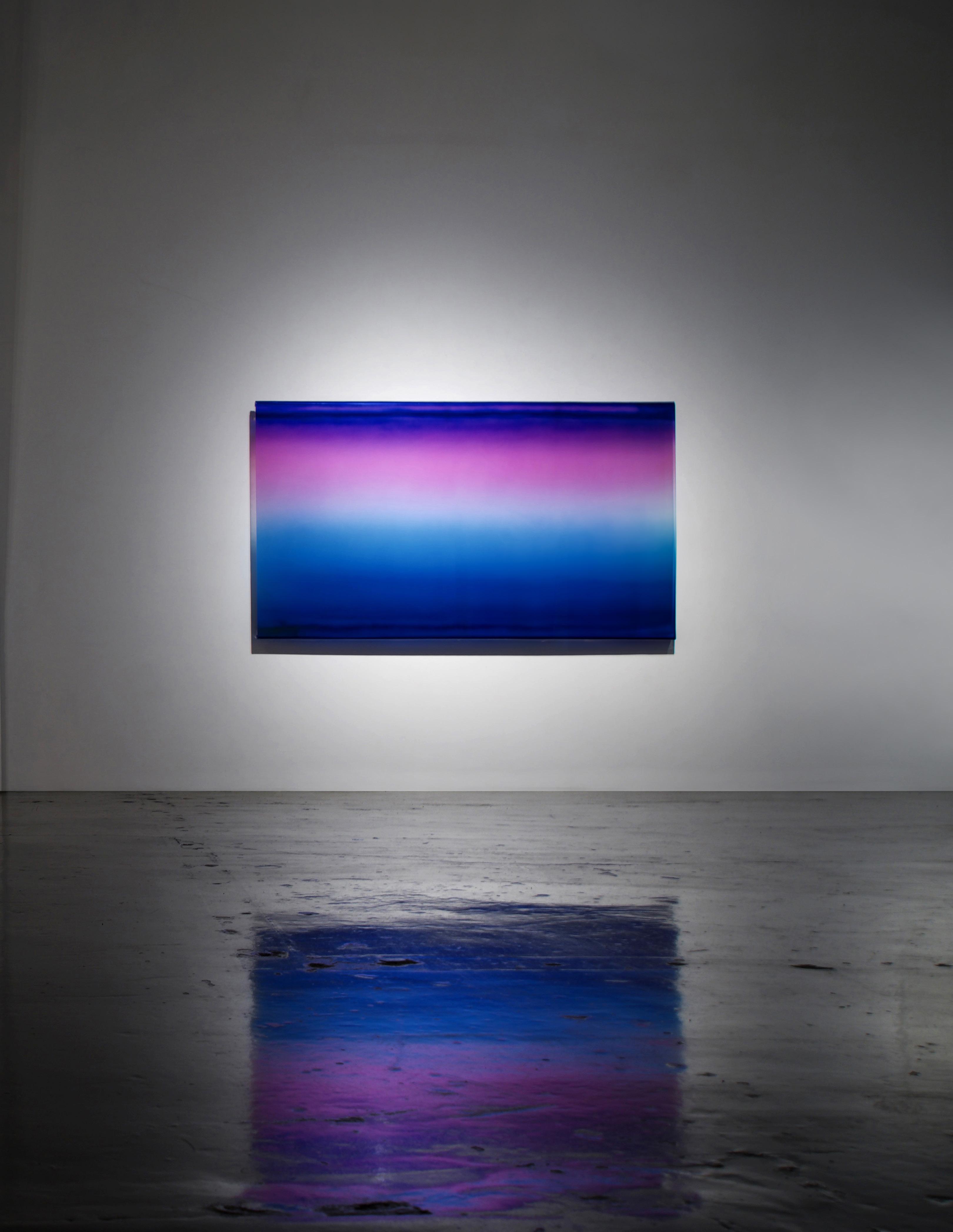
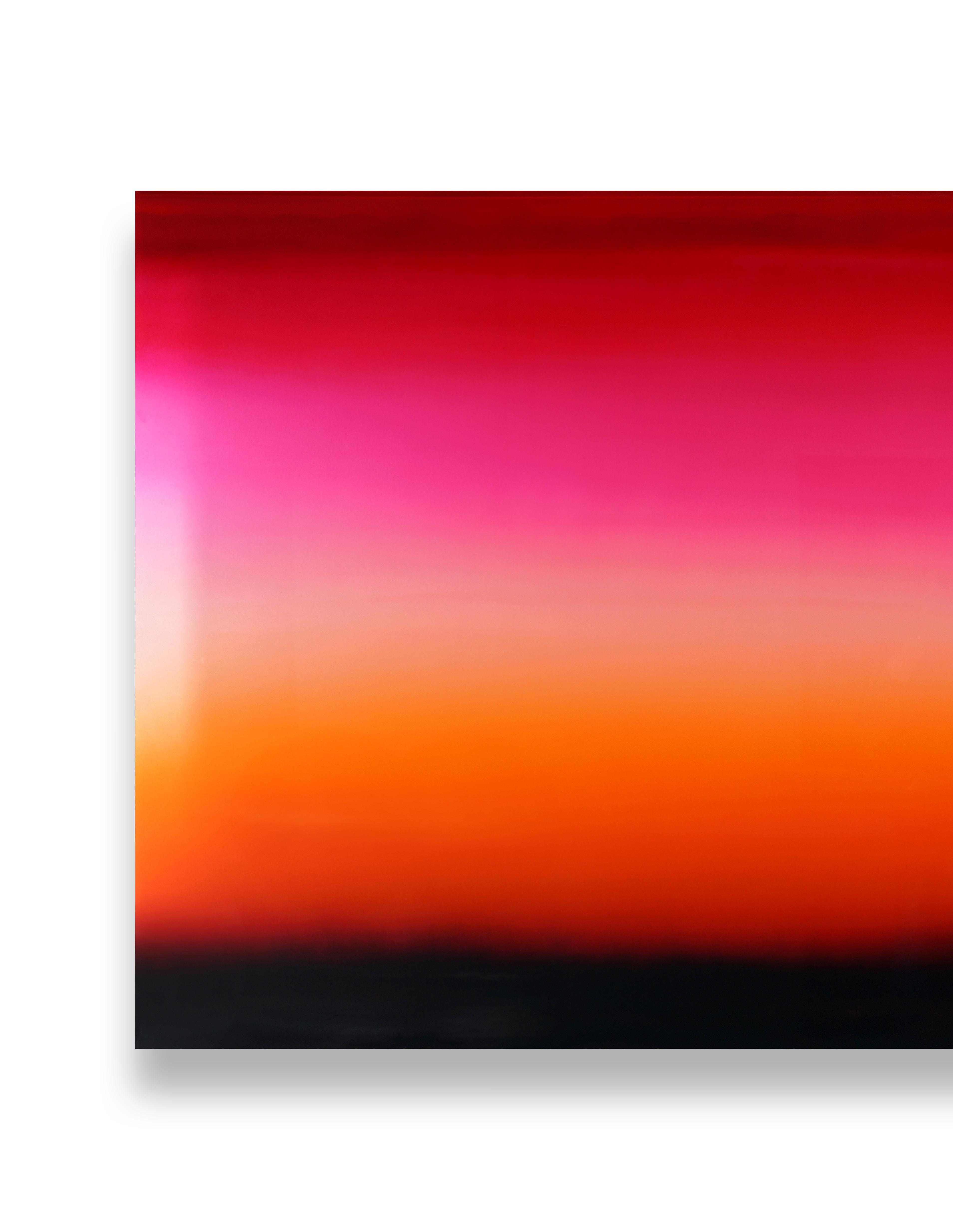
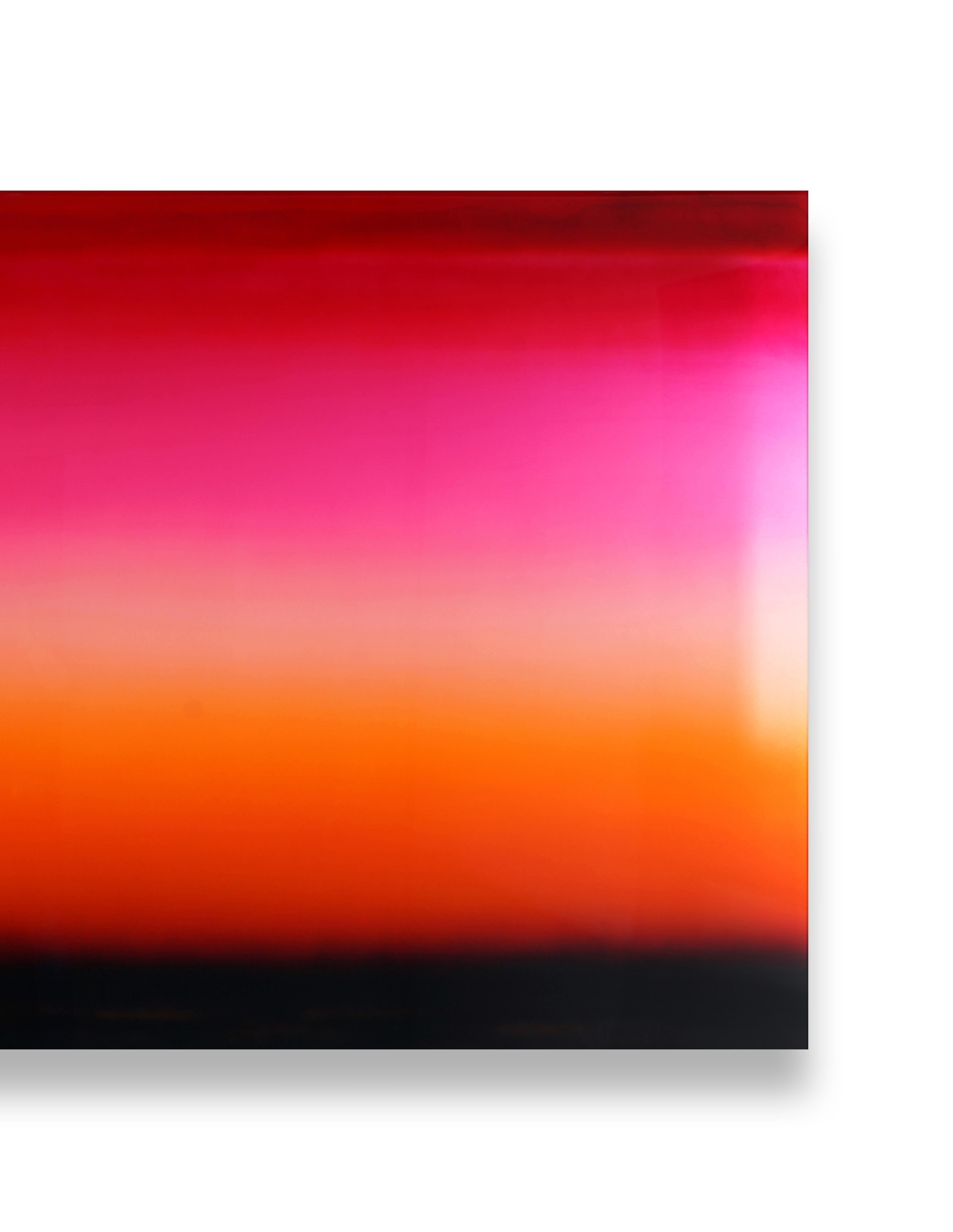


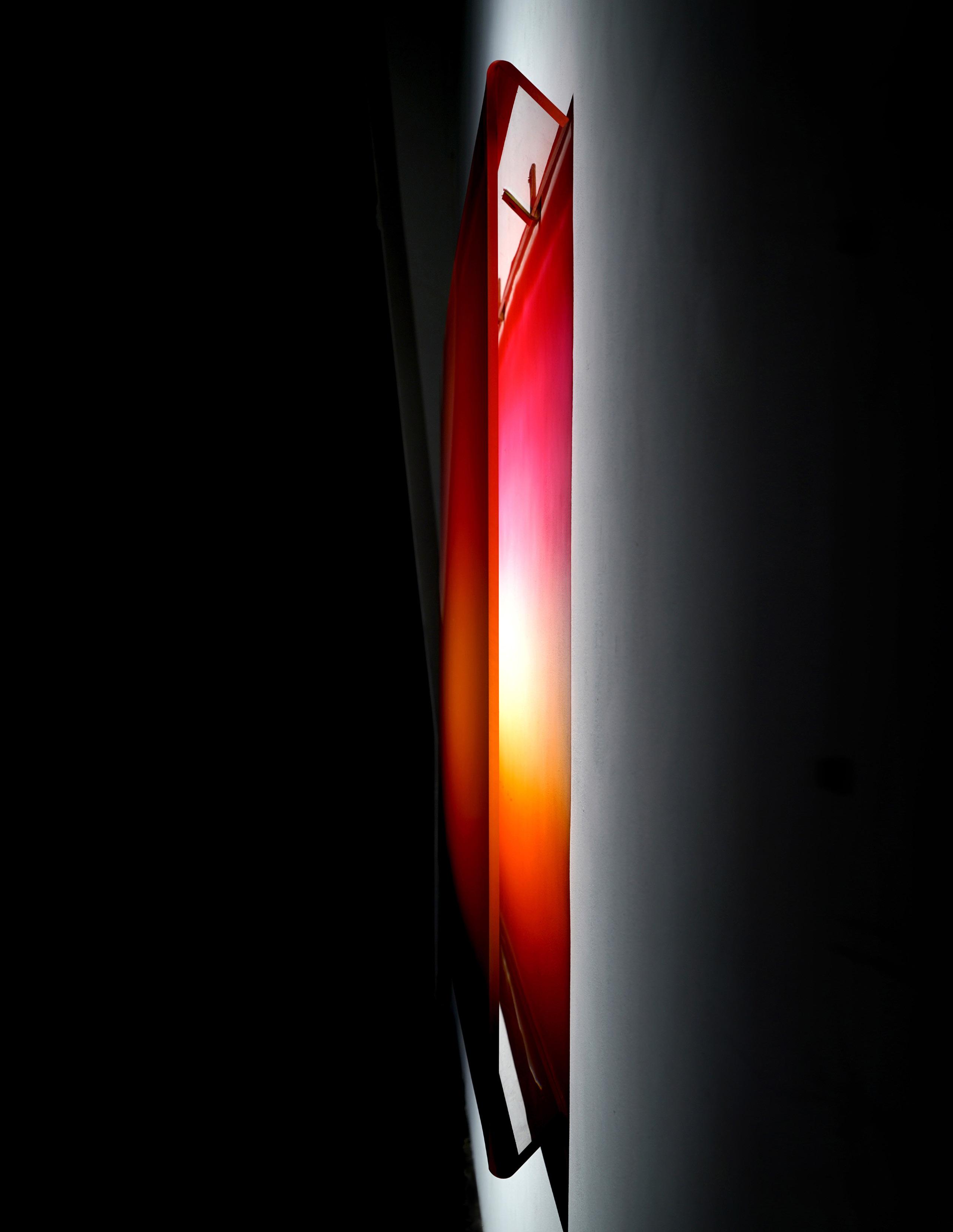
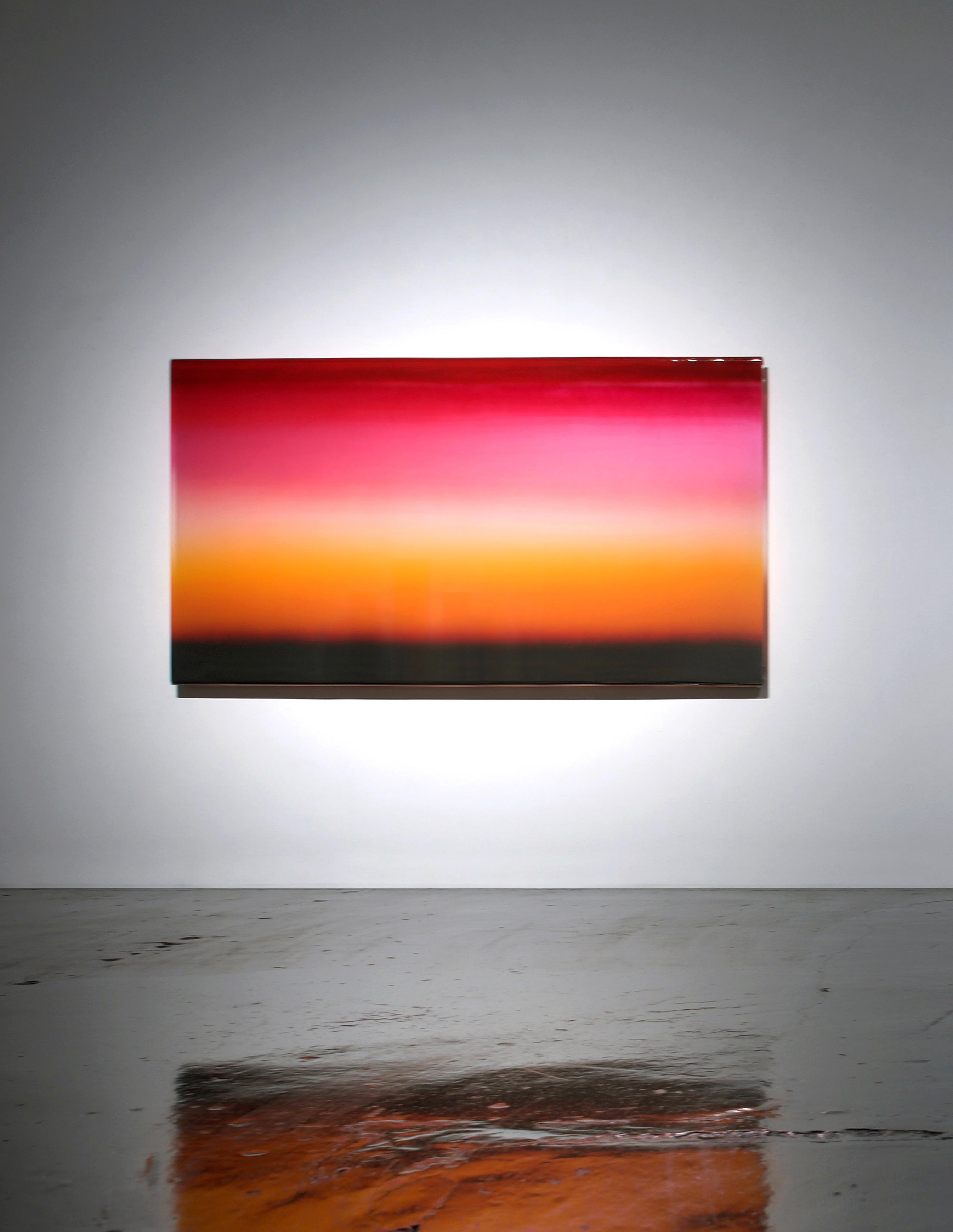


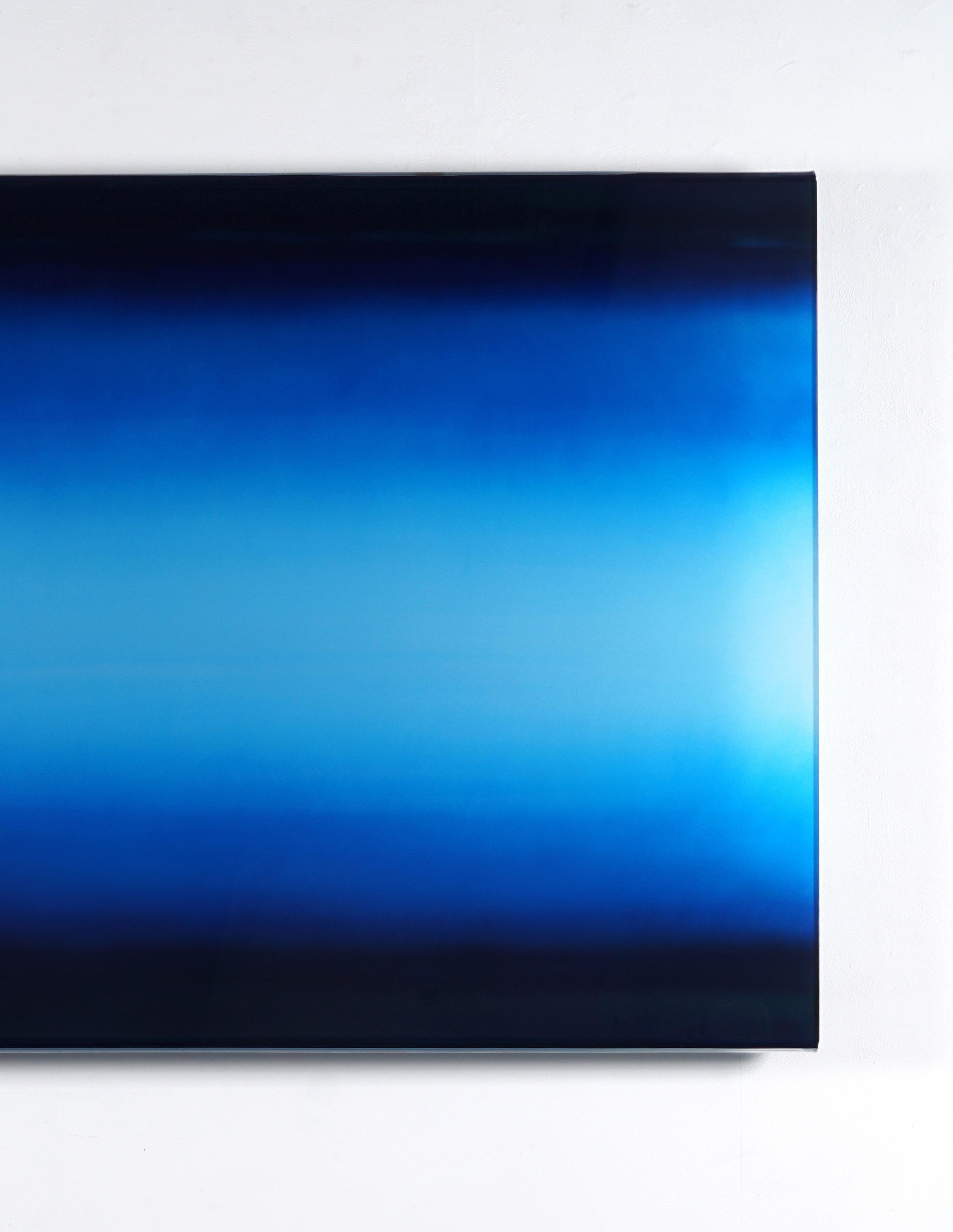

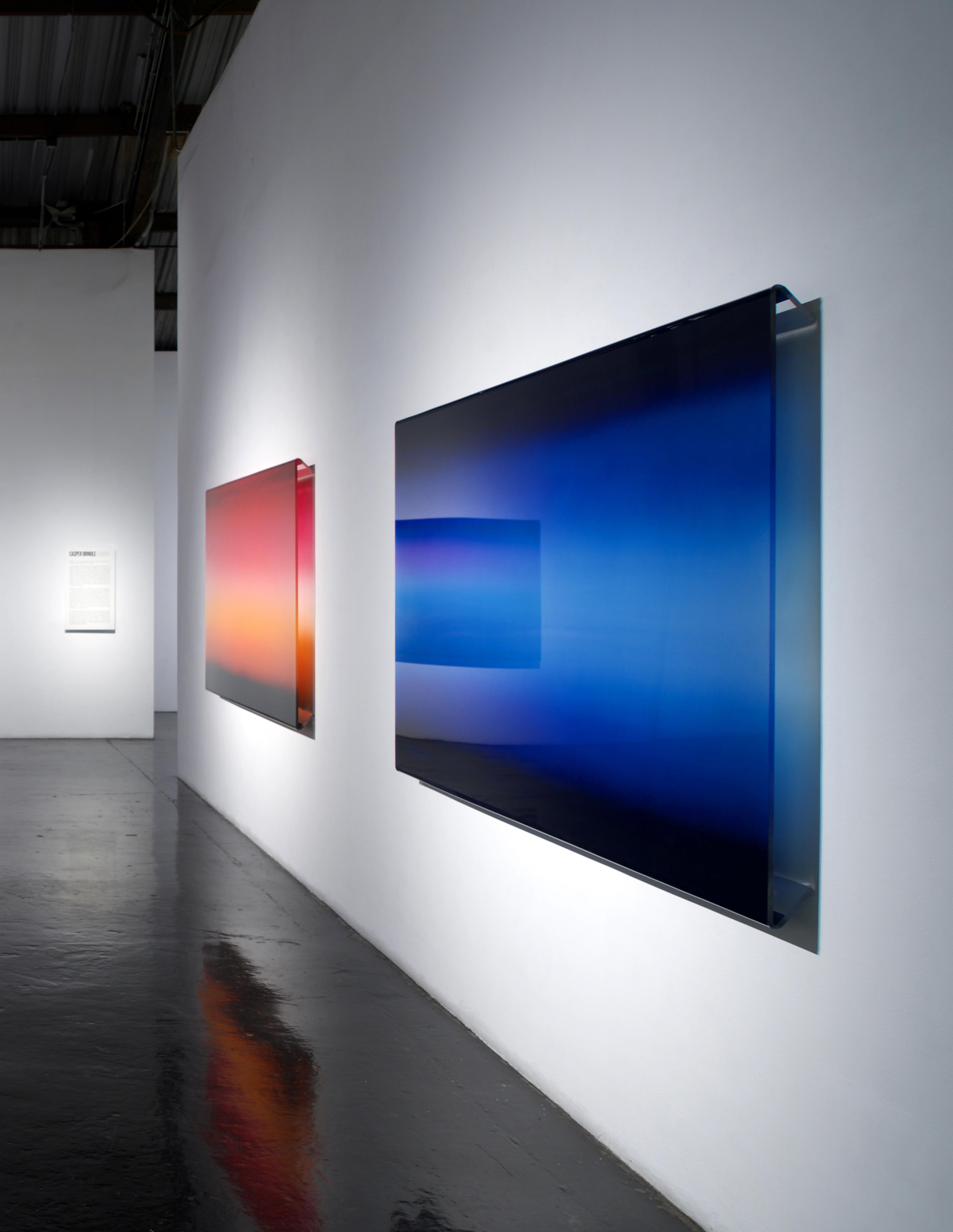
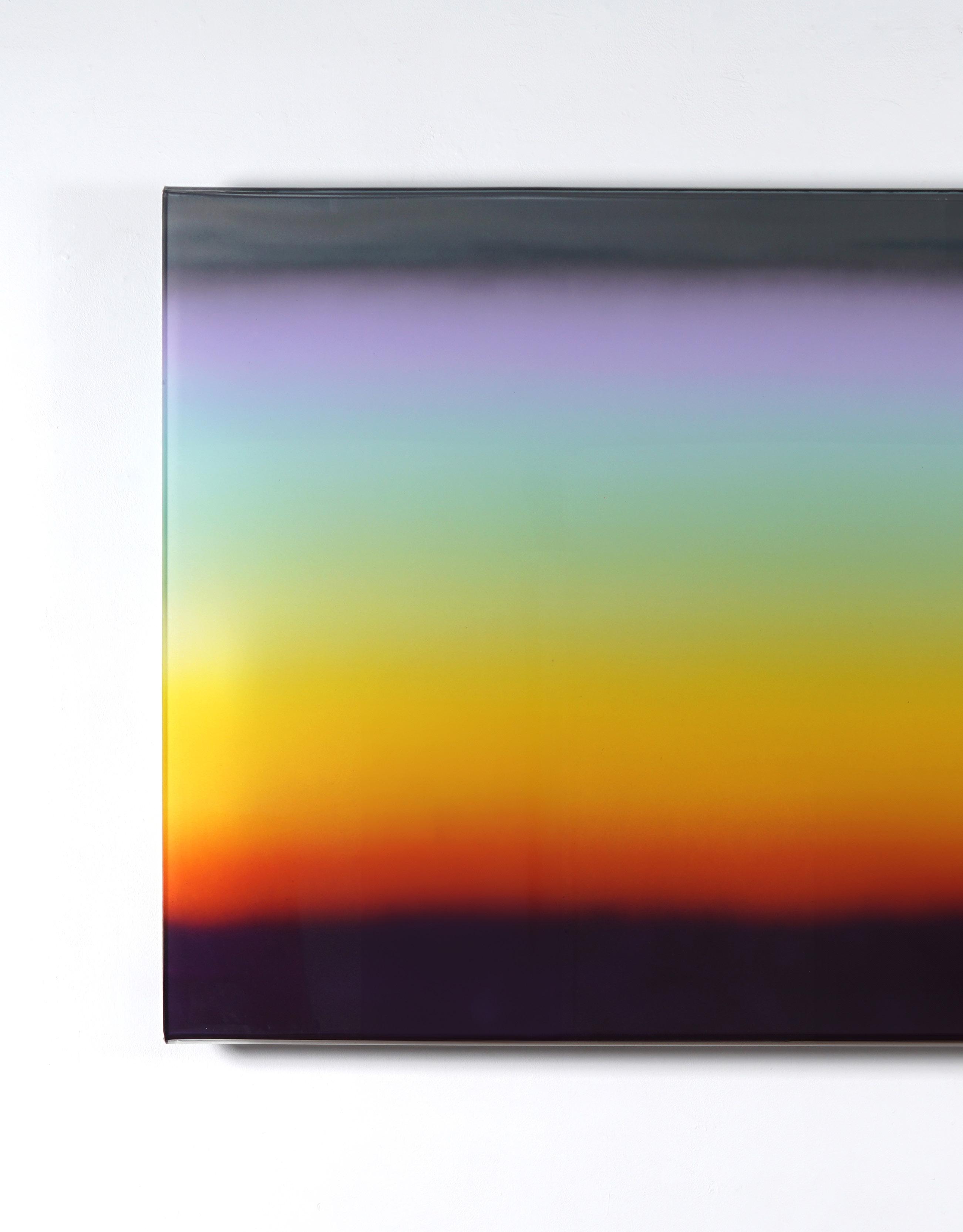

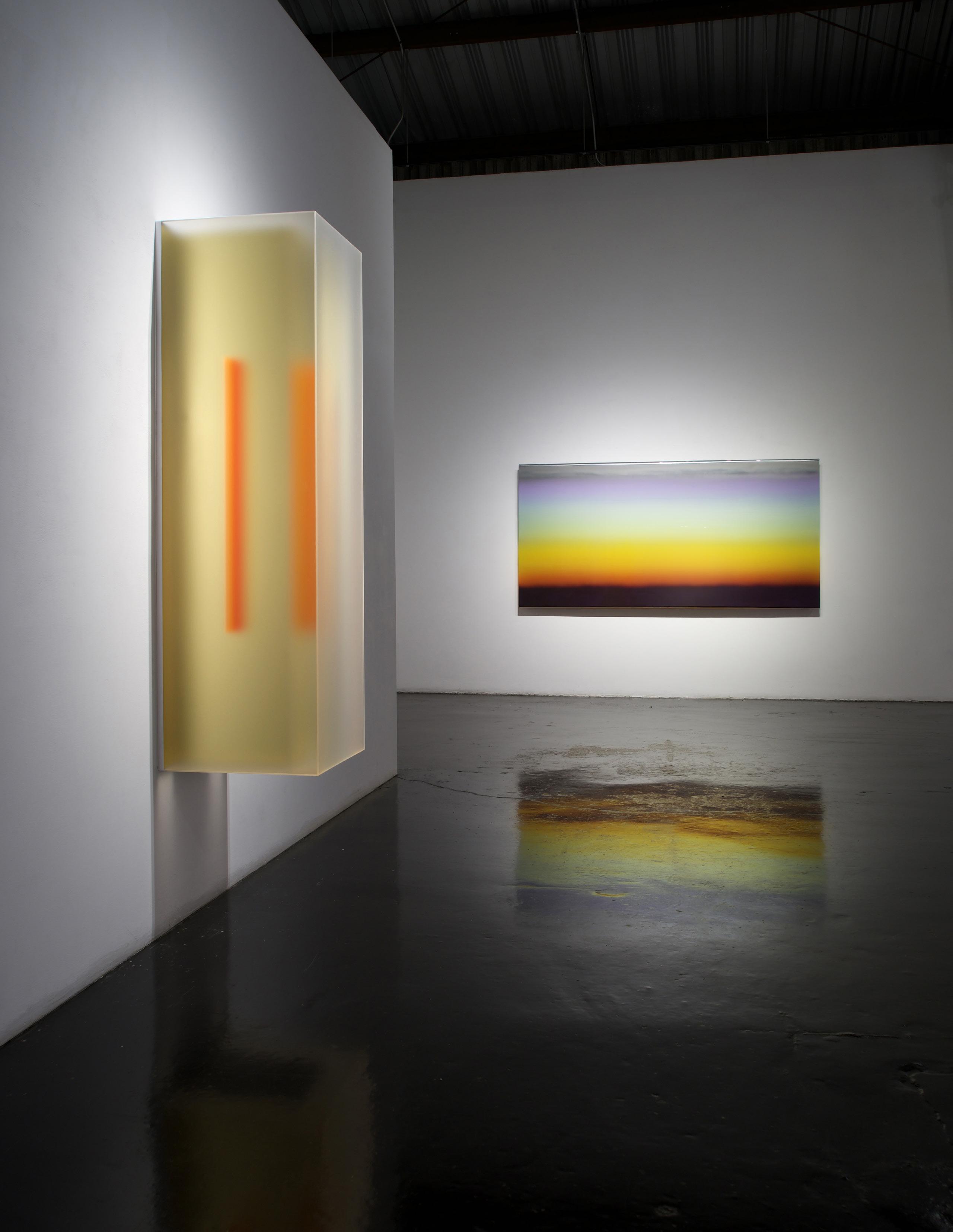


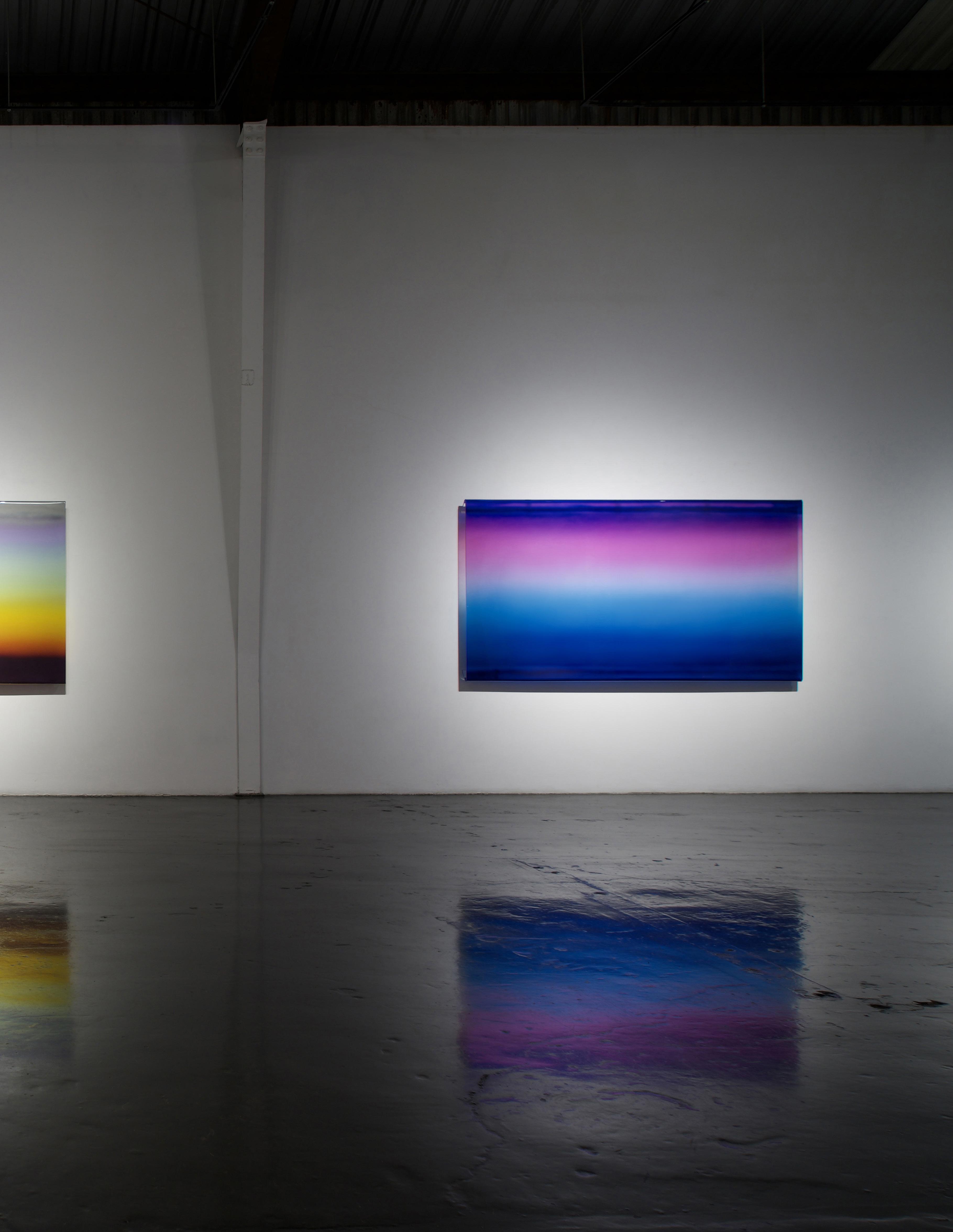
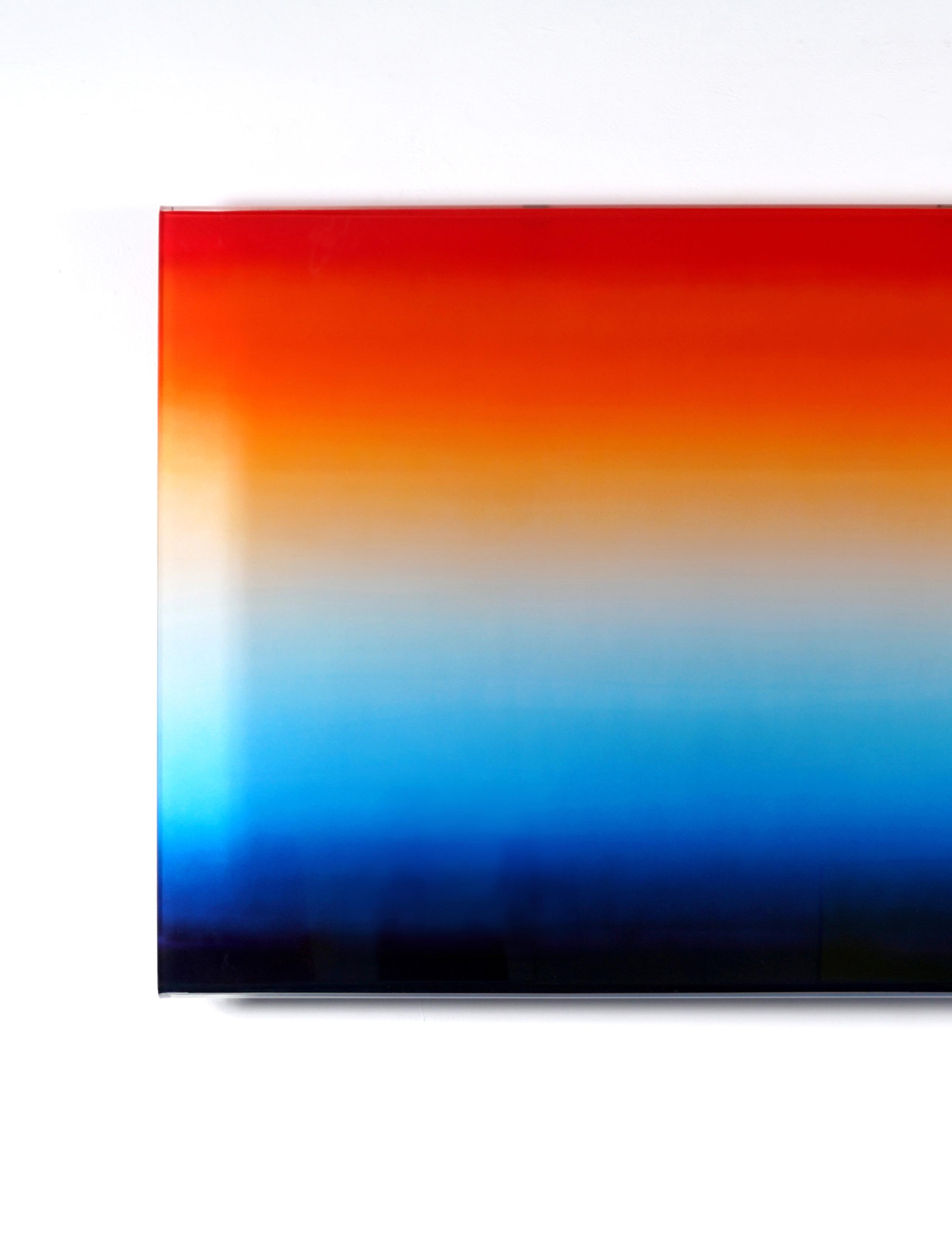
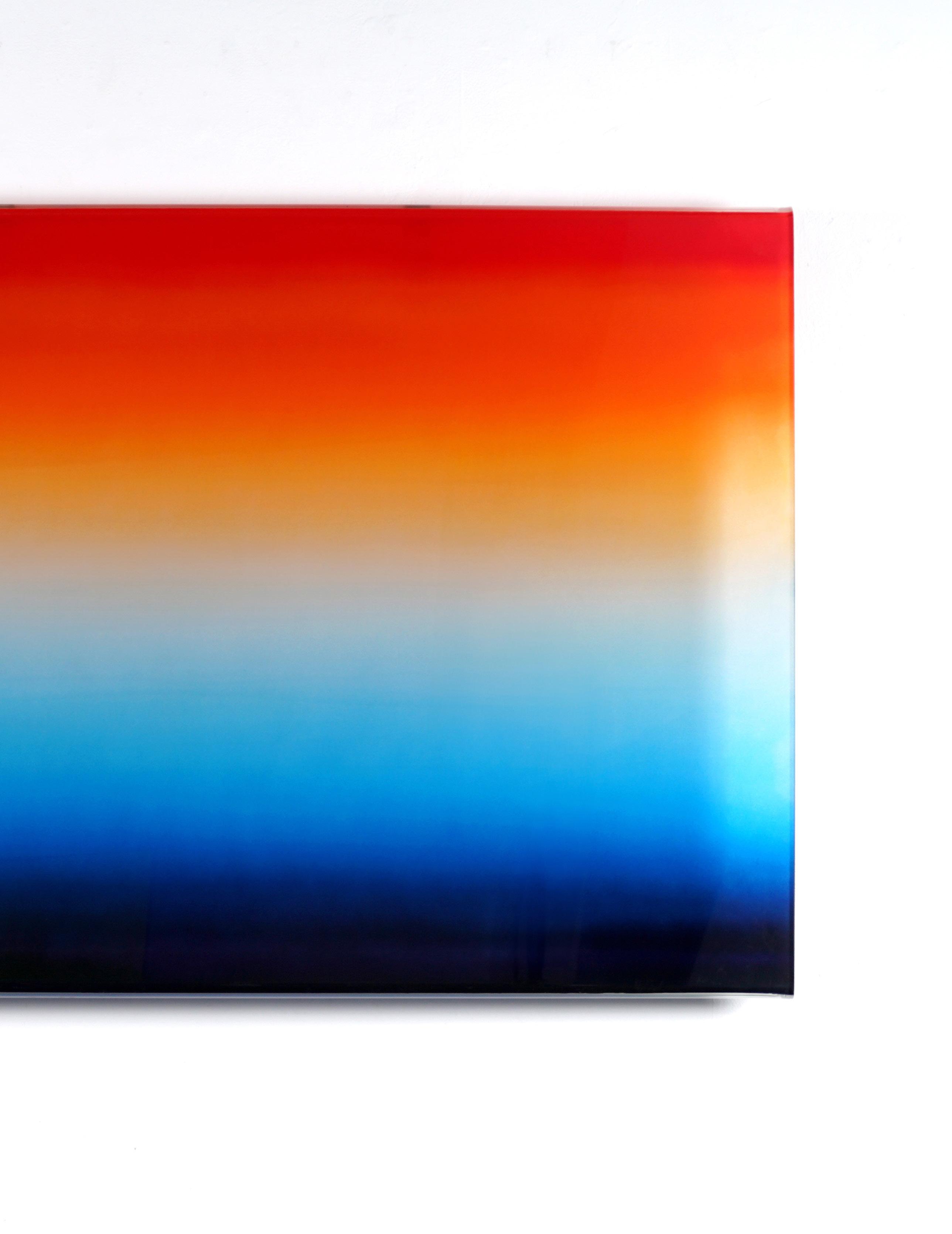


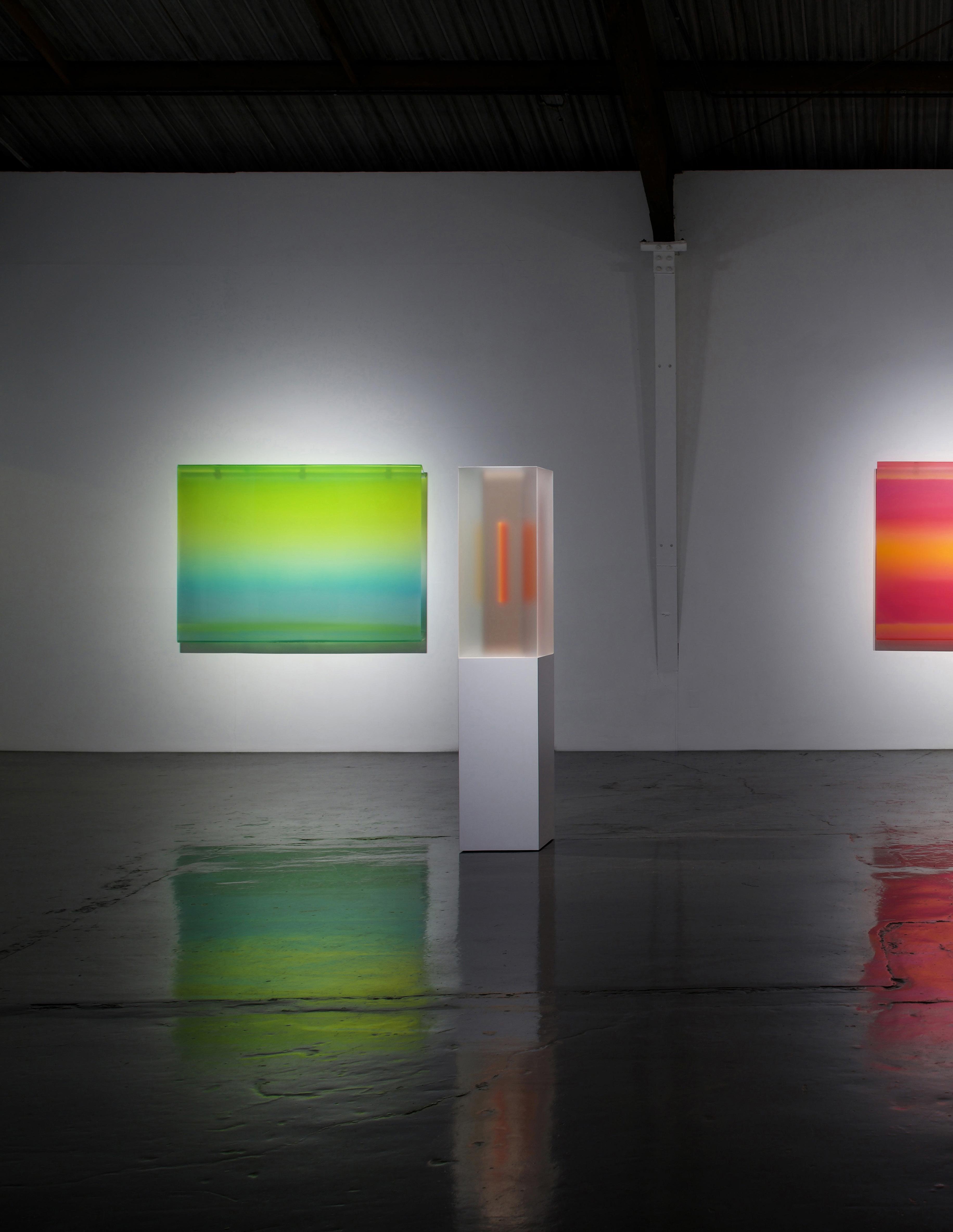

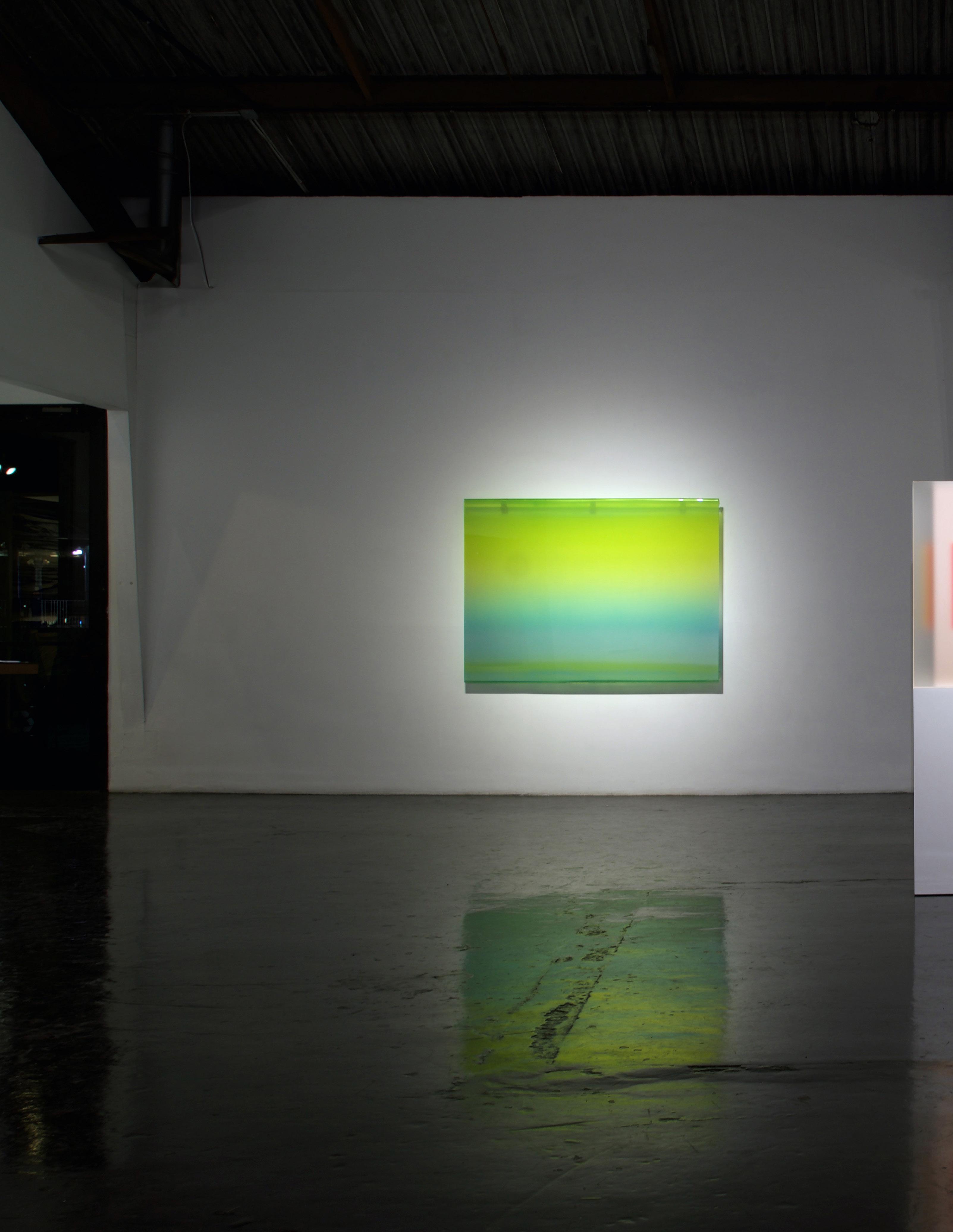
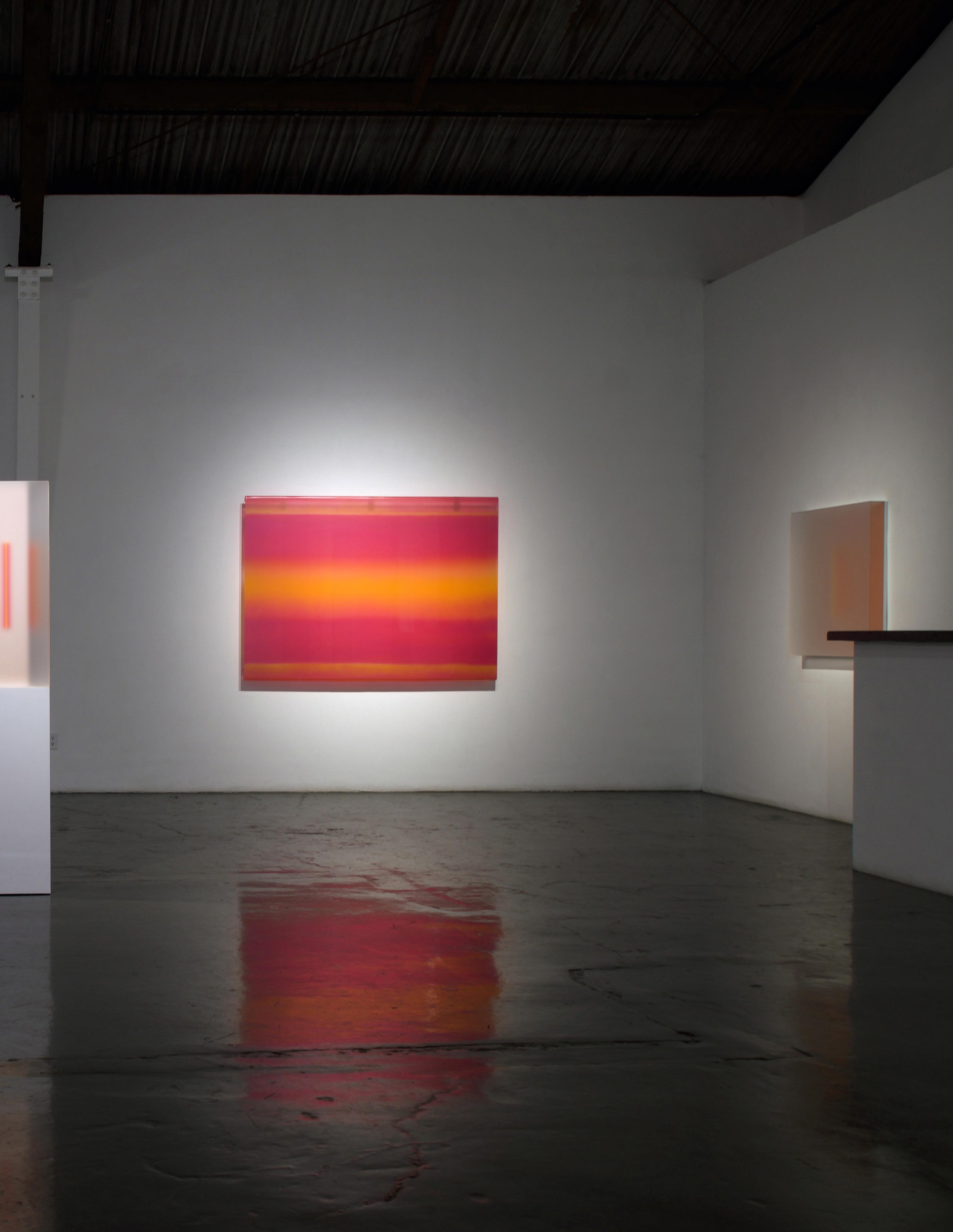
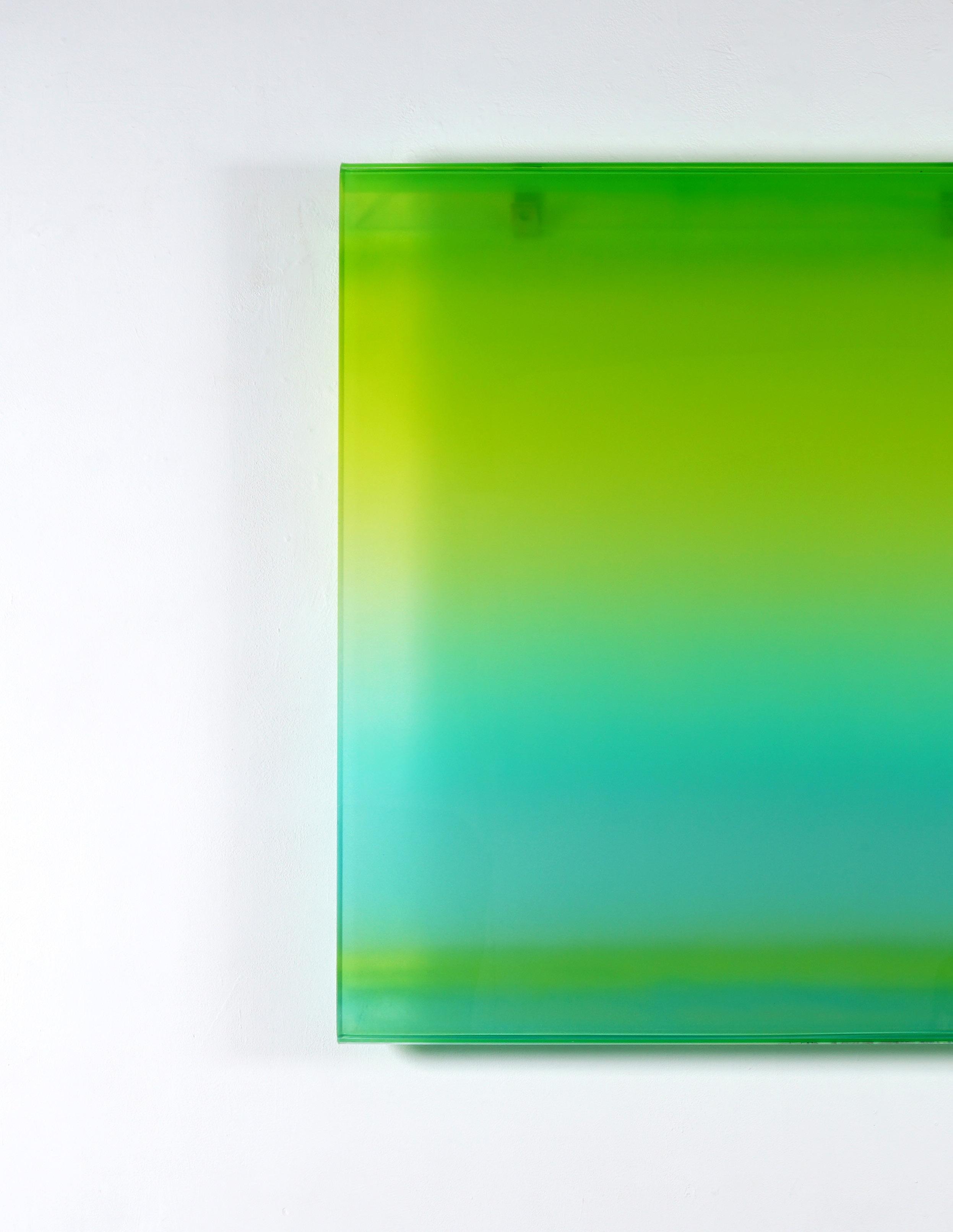
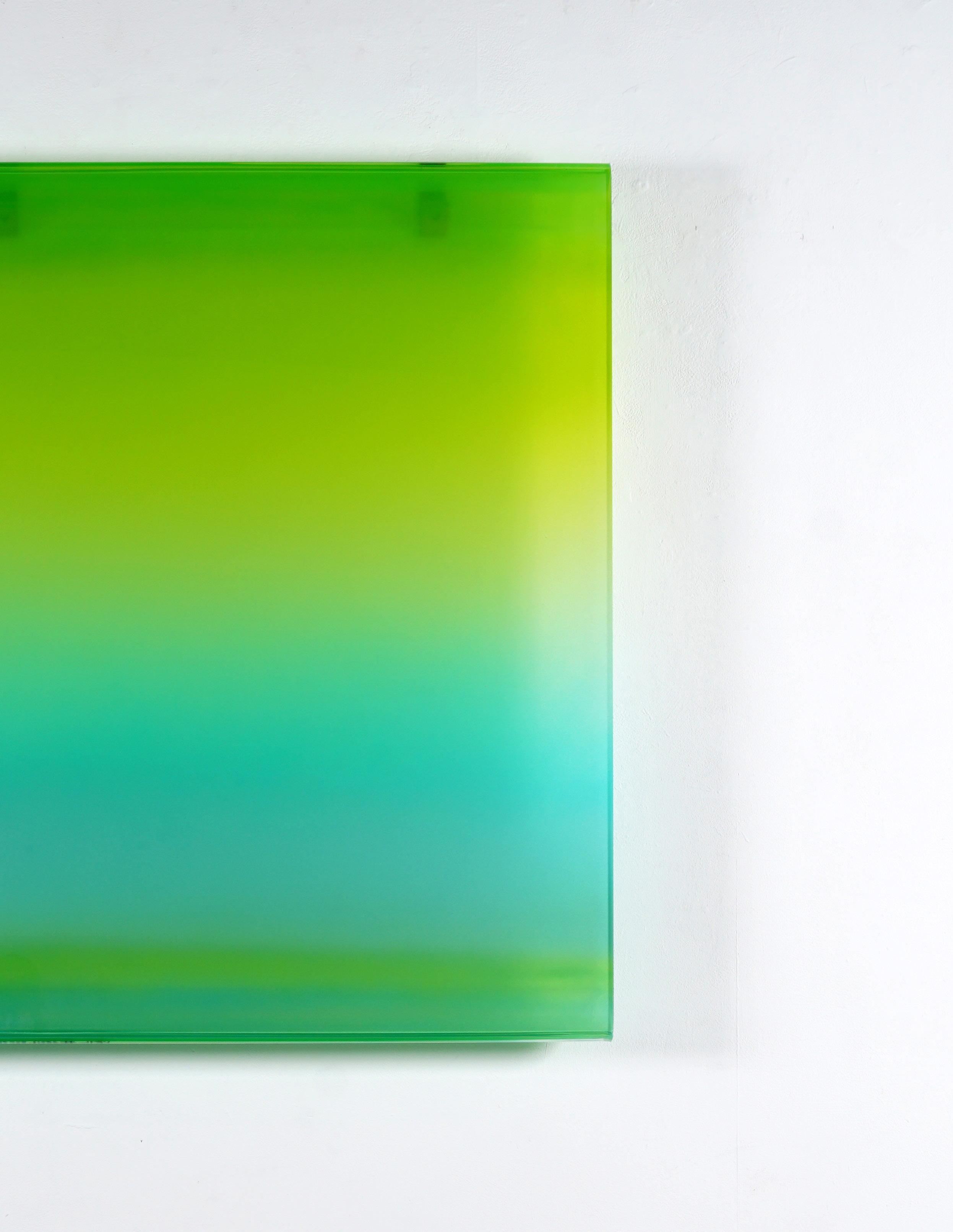

Veil II (Lime) , 2024, Acrylic & automotive paint on formed acrylic, 52” x 72” x 4”
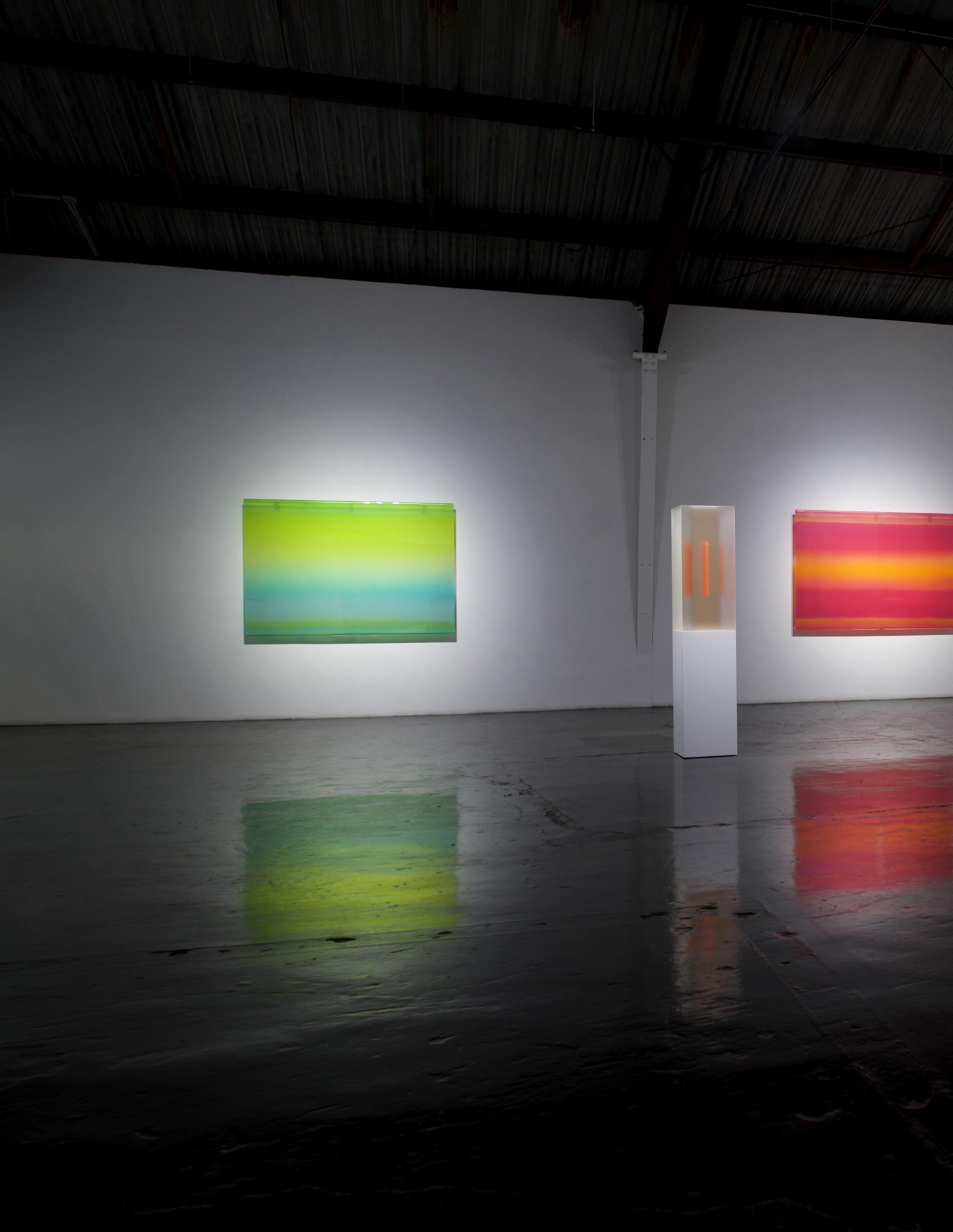


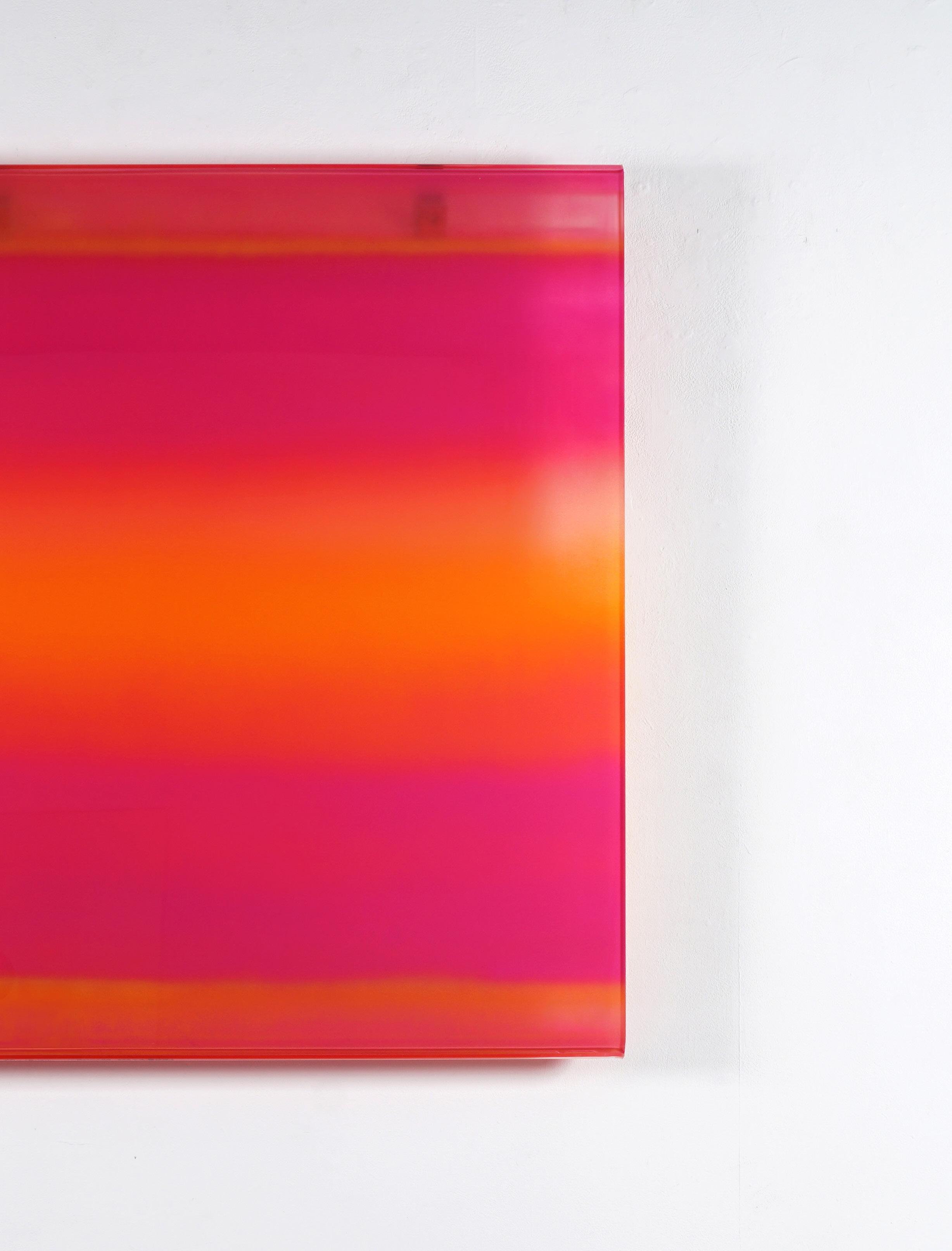


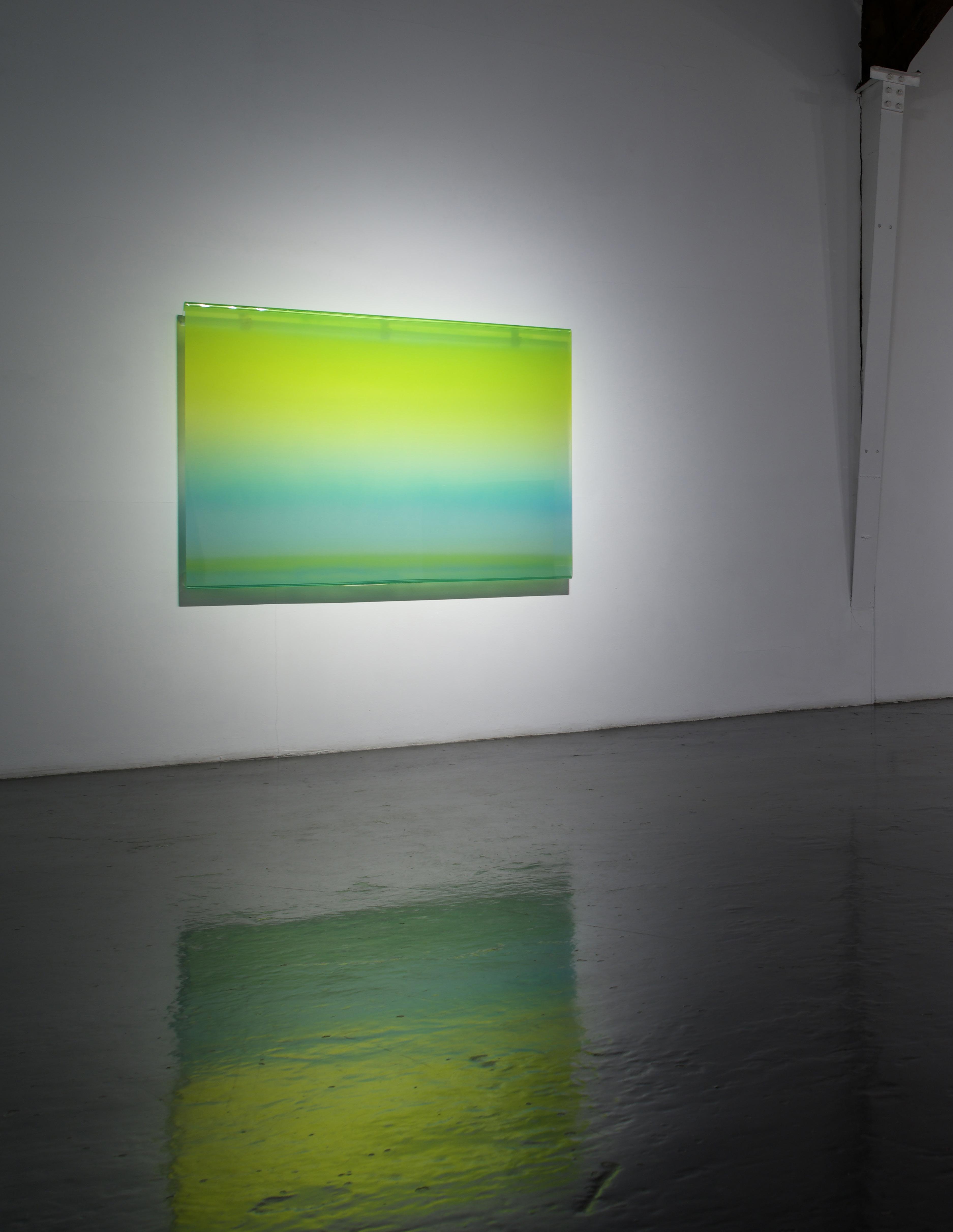

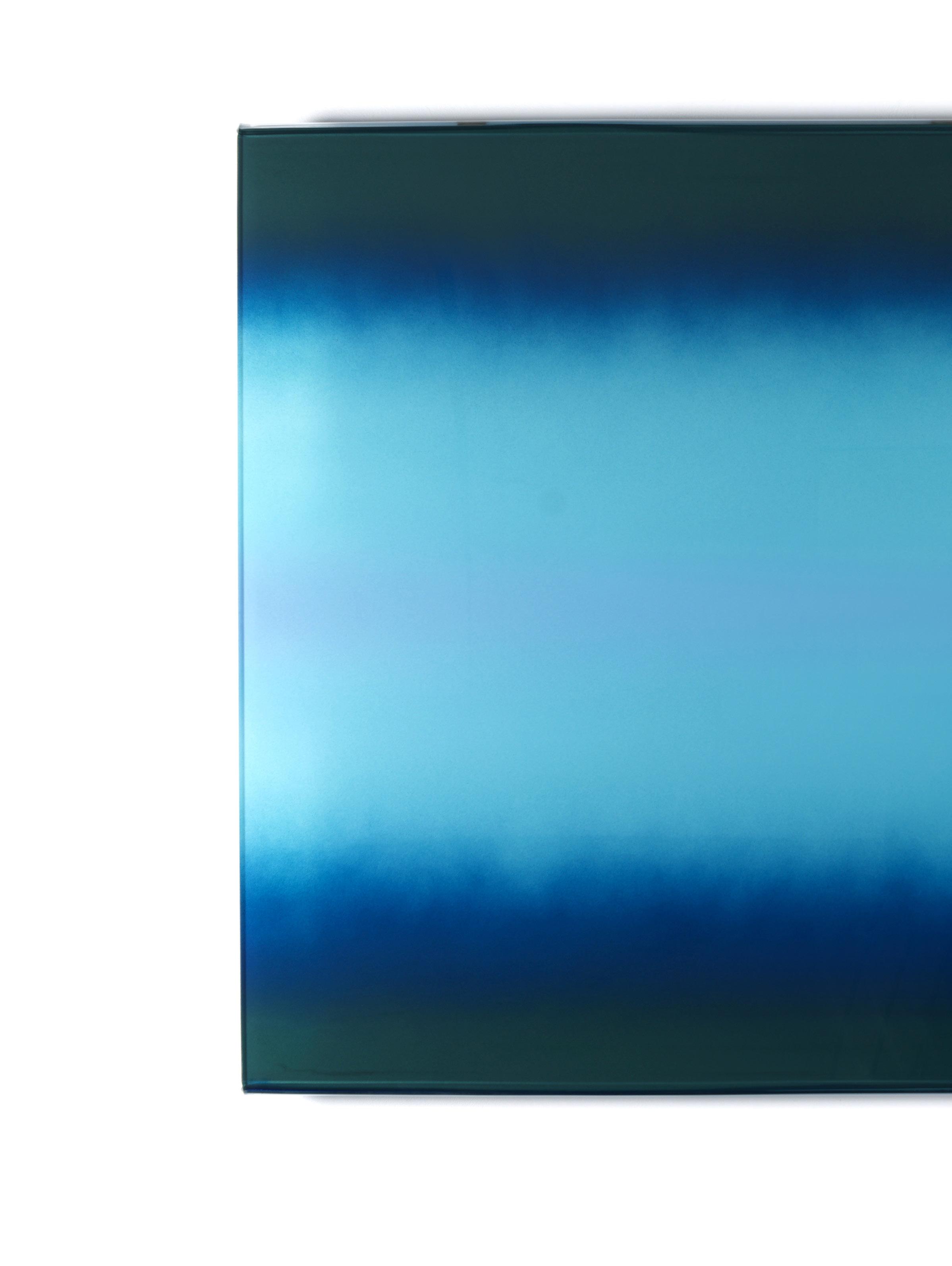



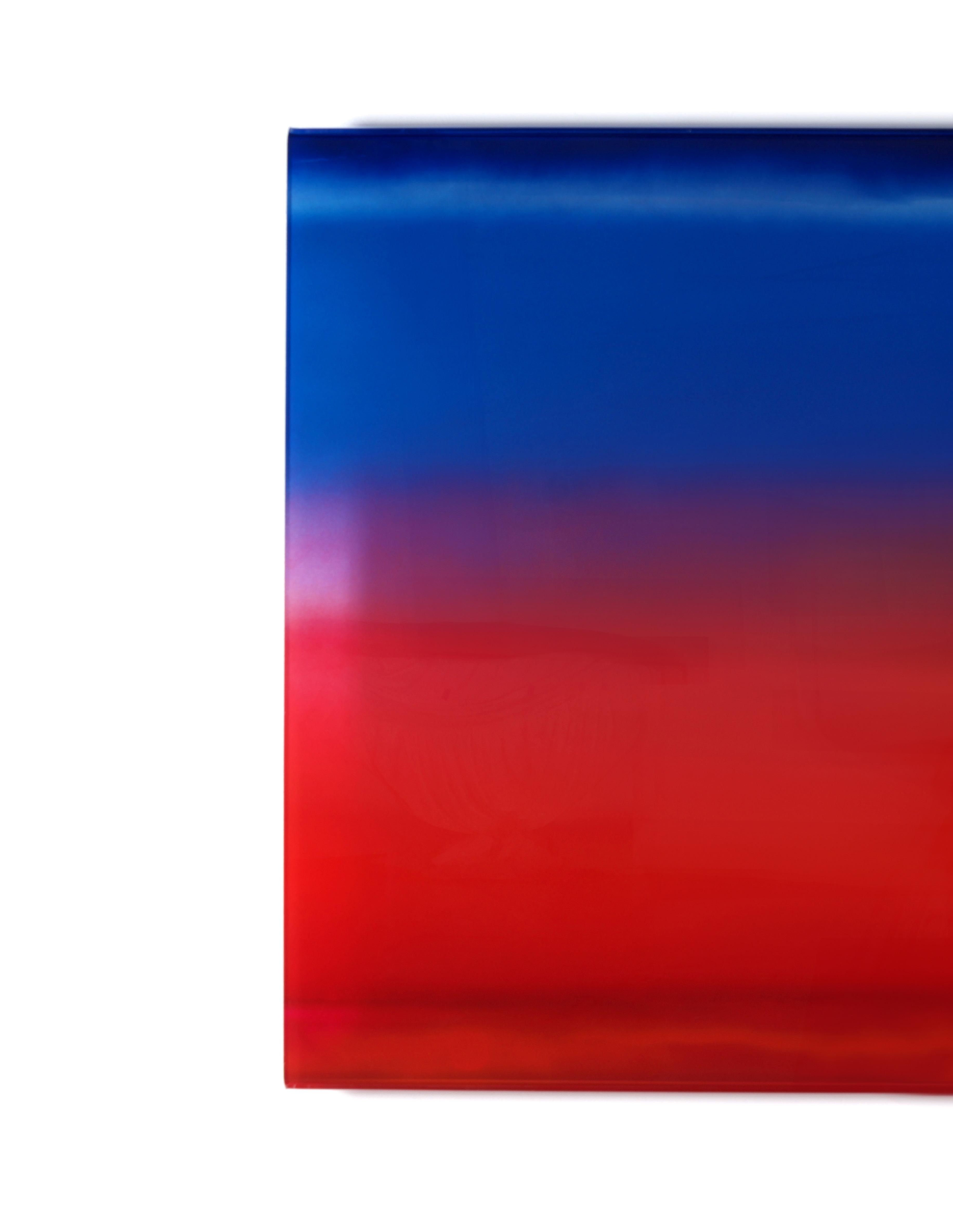


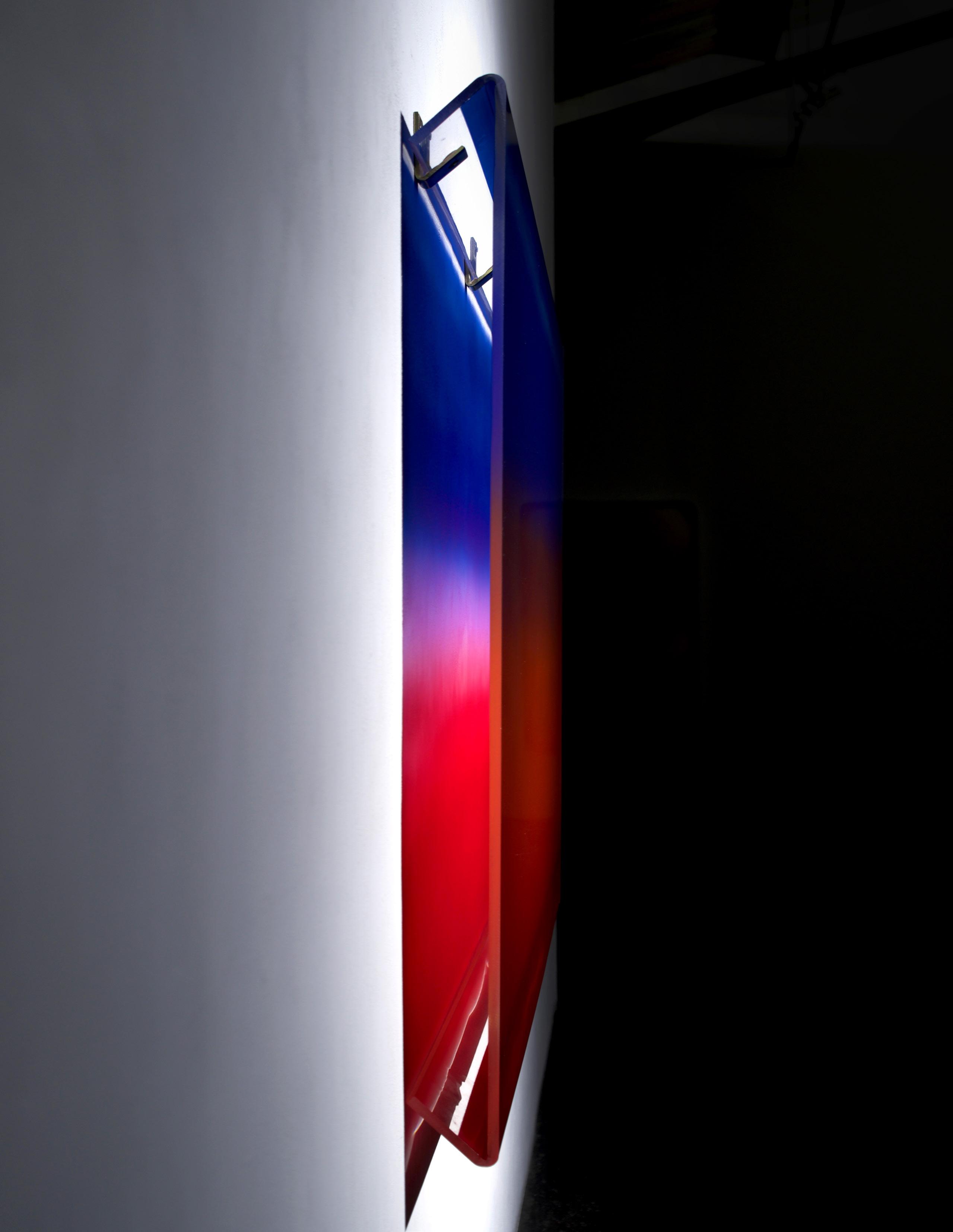


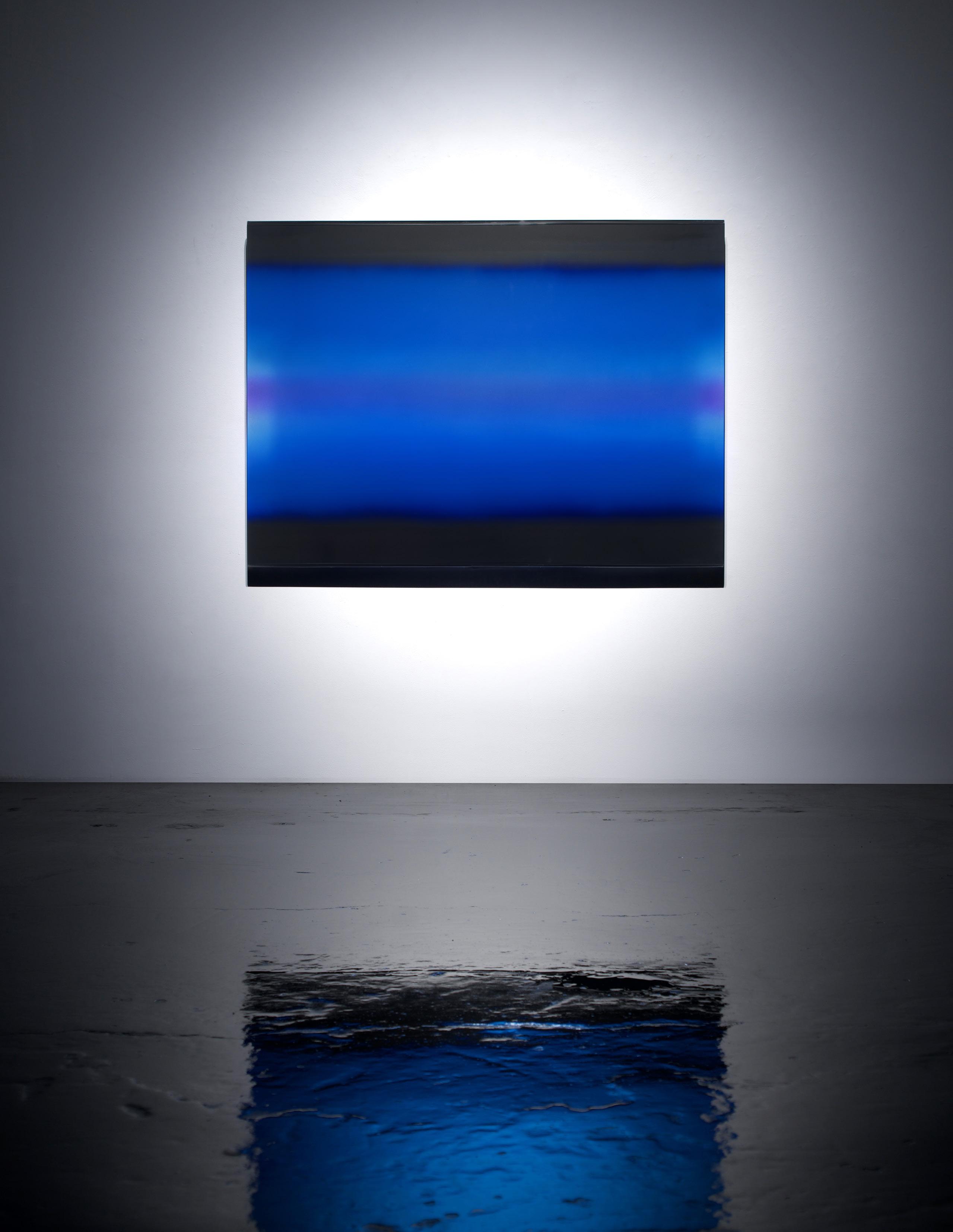
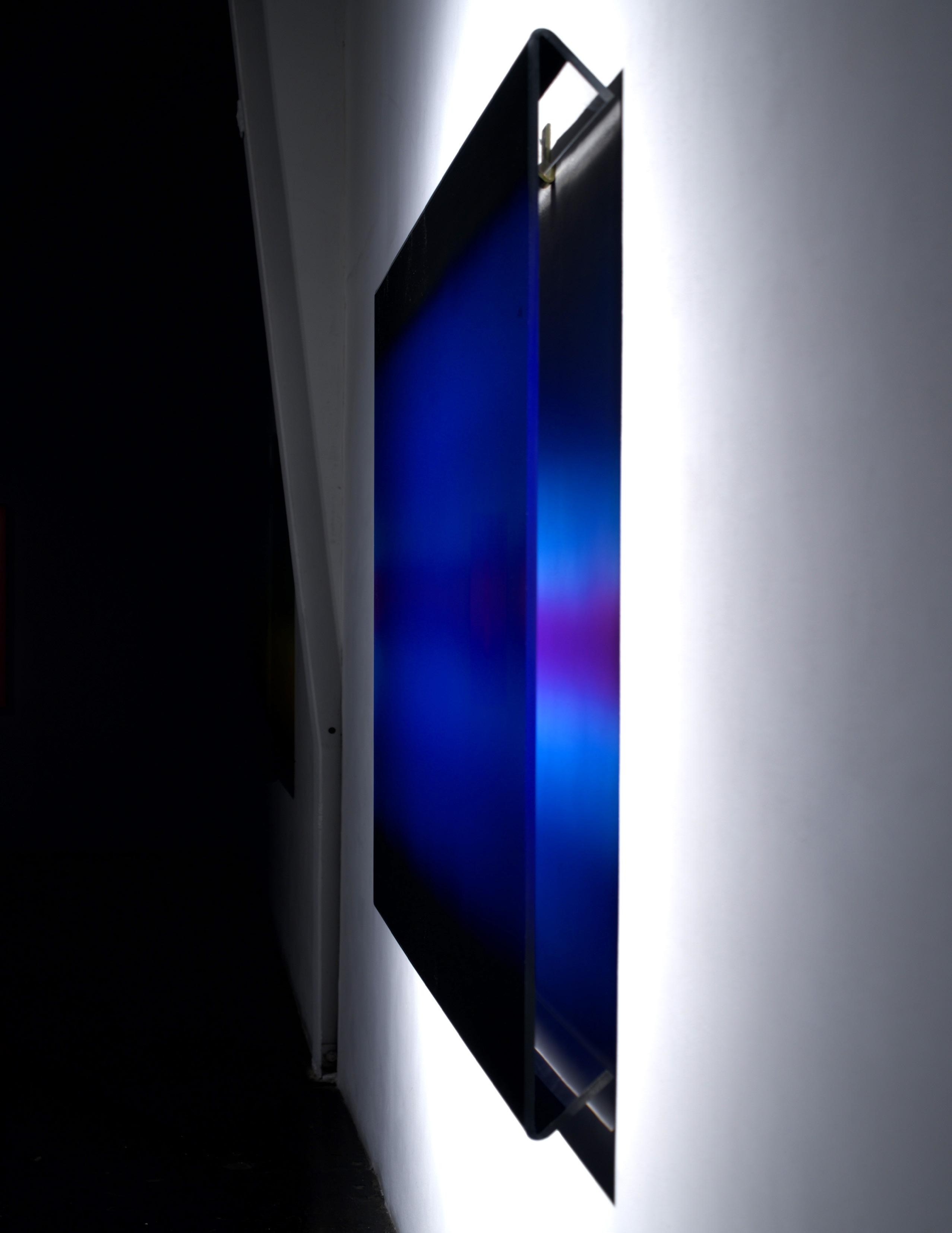
Glyphs are one of the oldest methods of human communication. They are a bridge between language and image, both record and revelation. These symbols are deeply embedded in human experience, embodying the fundamental impulse to communicate, to leave behind traces of thought and feeling for others to decode. Whether through writing or visual art, communication serves as a vessel for memory, capturing ephemeral moments and distilling them into tangible forms.
Casper Brindle’s Light Glyphs series taps into this innate human connection, employing the elegant simplicity of a vertical line as a recurring motif. Luminous and enigmatic, Brindle’s Light Glyphs radiate an energy that shifts depending on the viewer’s position and the surrounding light. This energy imbues them with an almost hypnotic presence. The reflective surfaces— an homage to Brindle’s lifelong relationship with the ocean—shimmer like water at different times of day, evoking a sense of perpetual transformation.
Despite their minimalism, Brindle’s Light Glyphs defy easy categorization. Somewhere between painting and sculpture, these artworks are undeniably experiential. The highly dynamic artworks demand interaction. Their appearance is mercurial, altering in response to shifts in light and perspective, ensuring that no two encounters are ever quite the same. In this way, Brindle’s Glyphs transcend mere visual appreciation, initiating an intimate and subjective dialogue between artwork and viewer—one that must be experienced in person to be fully understood.
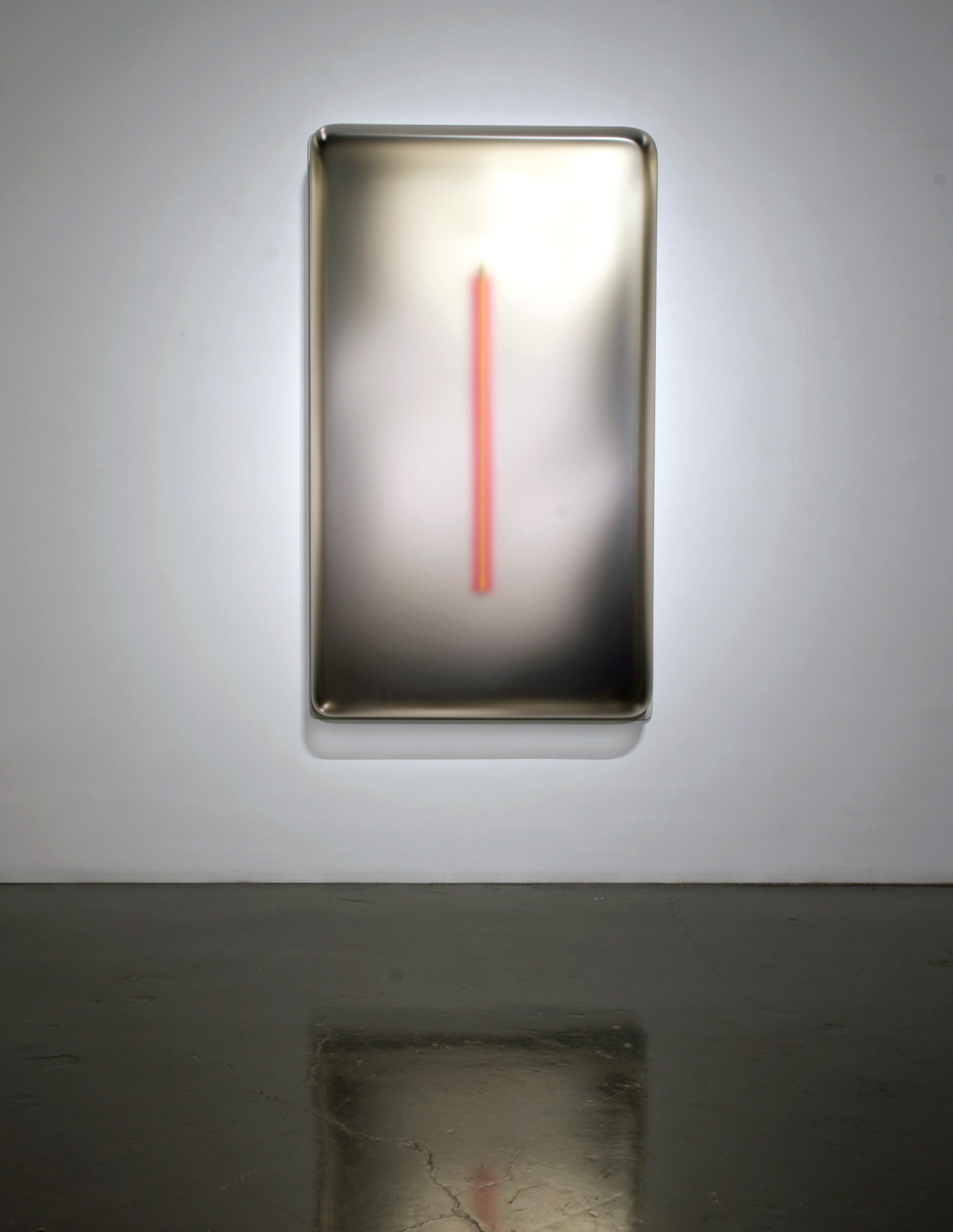

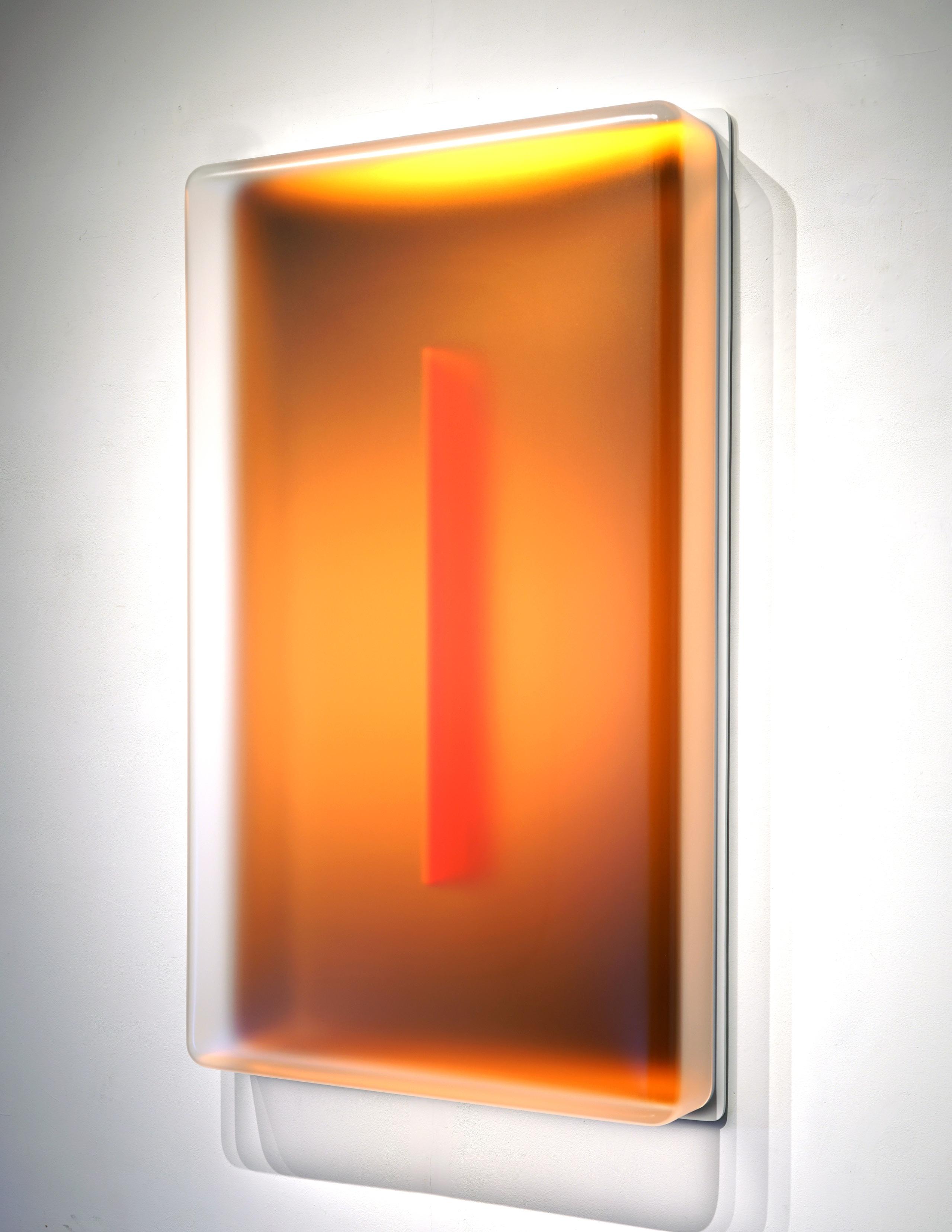
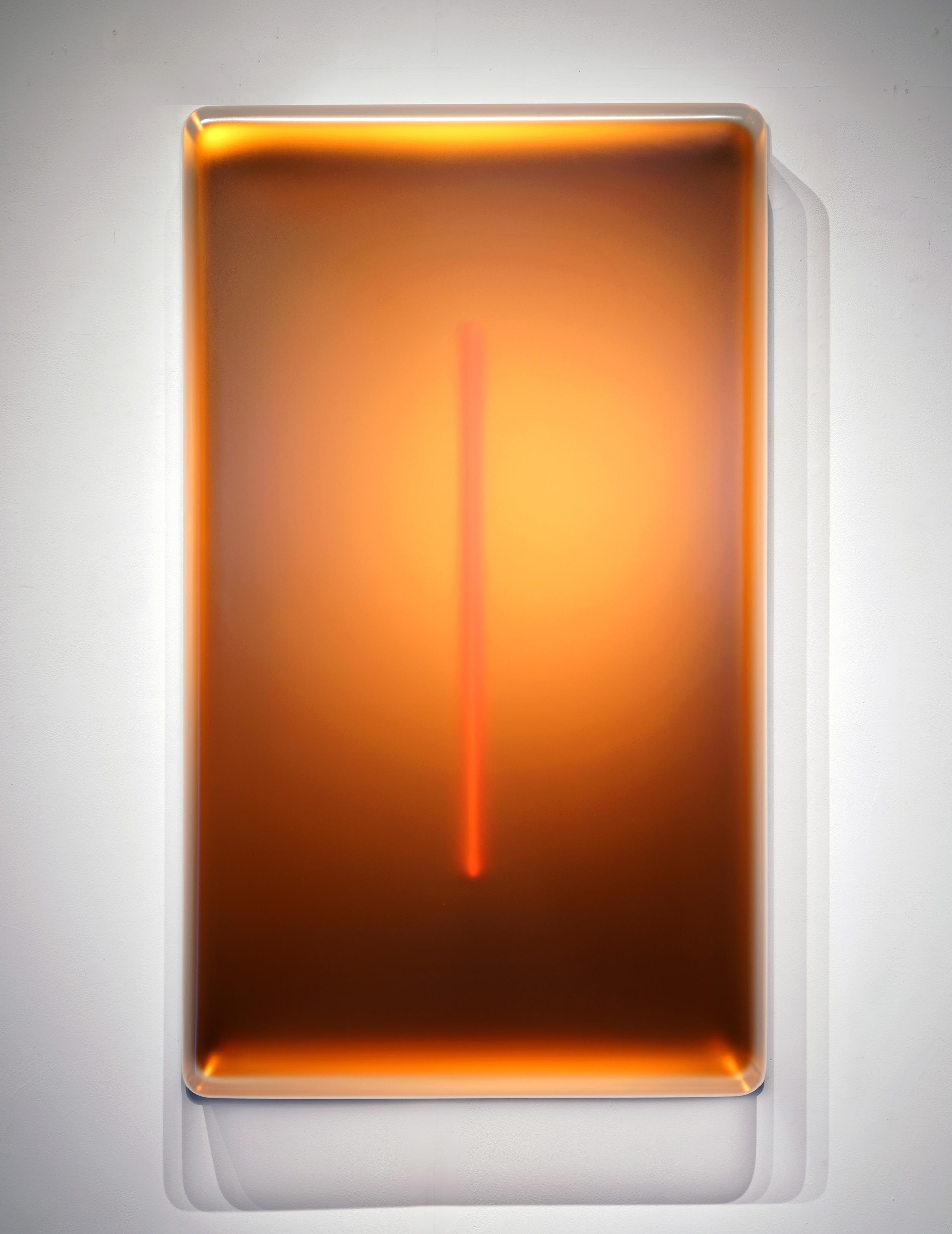

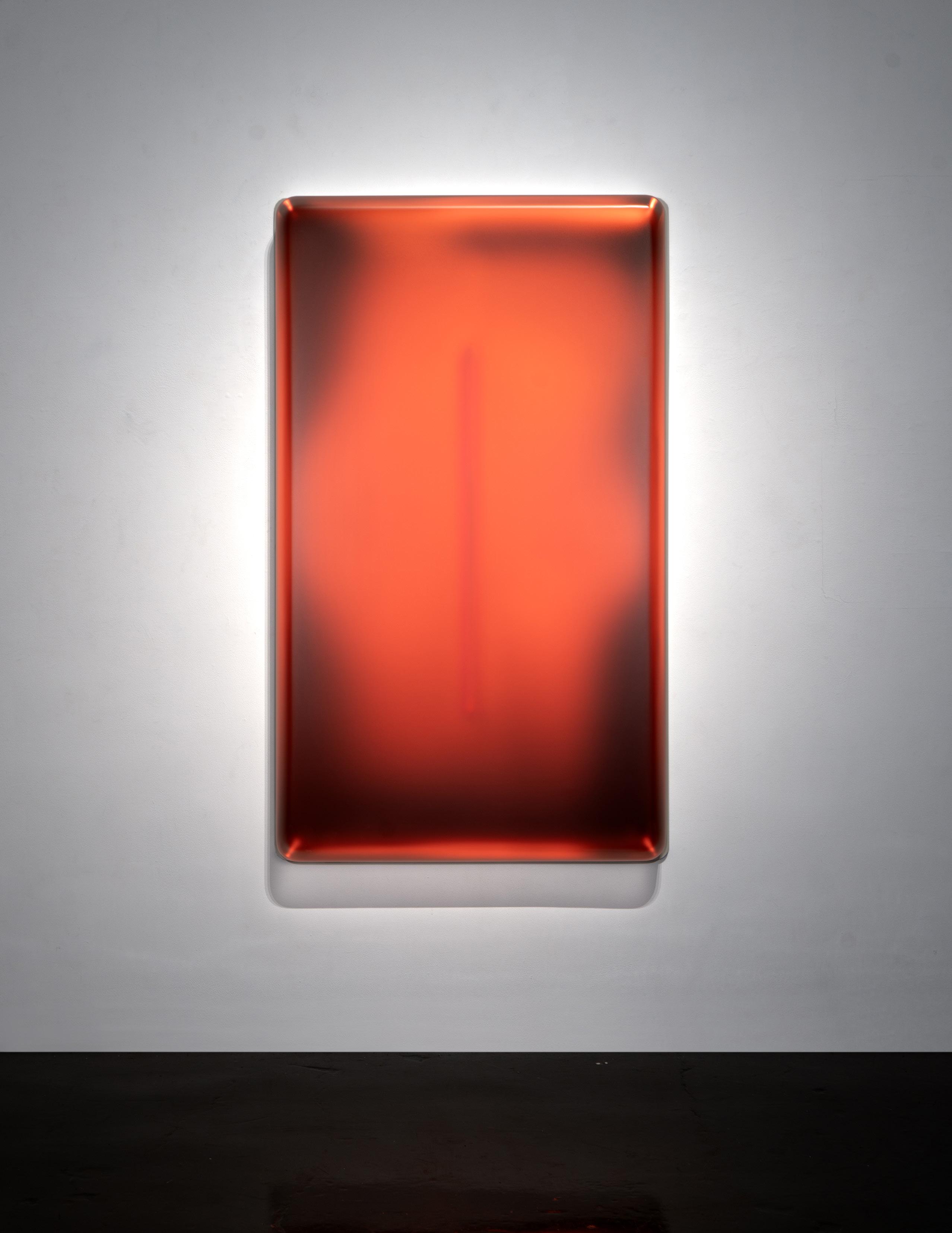

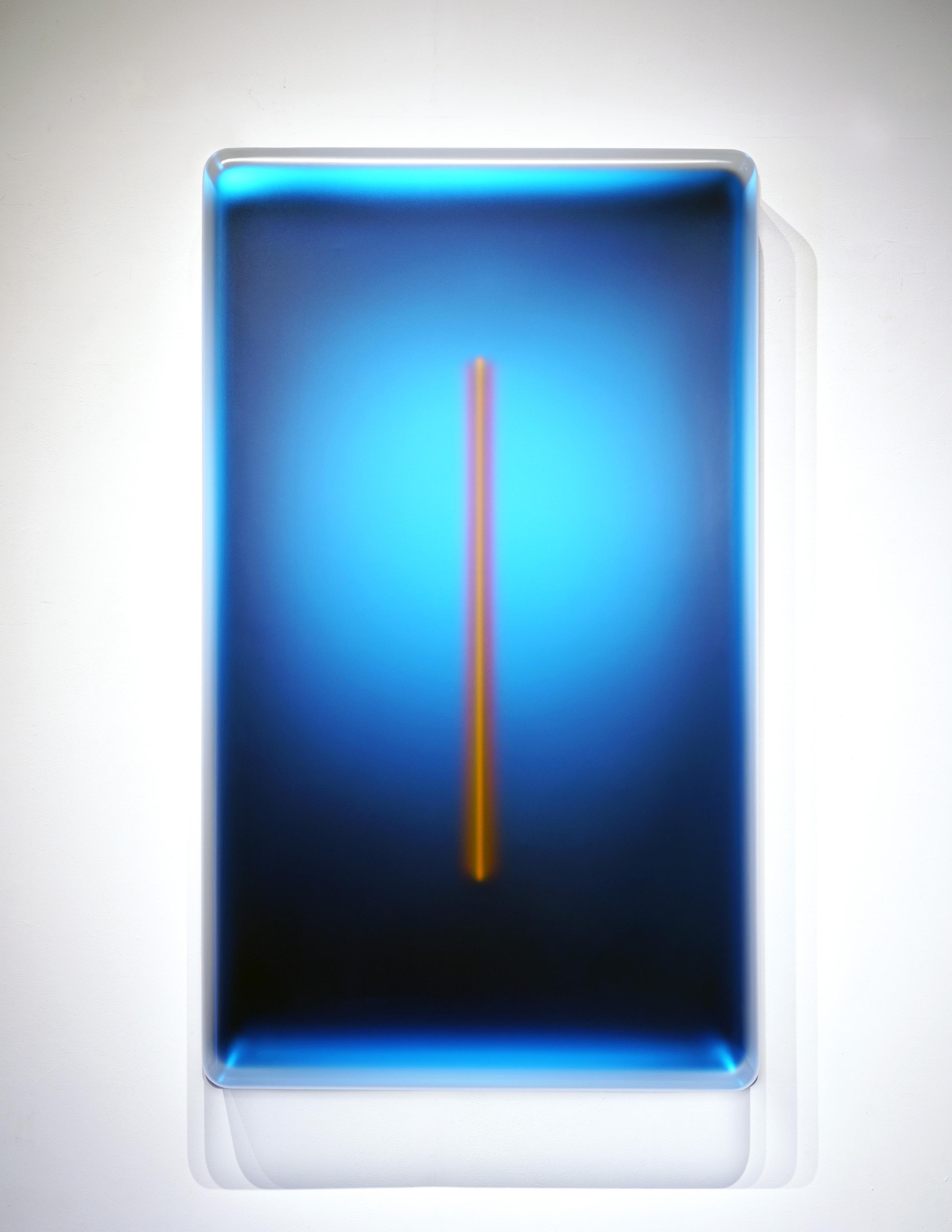
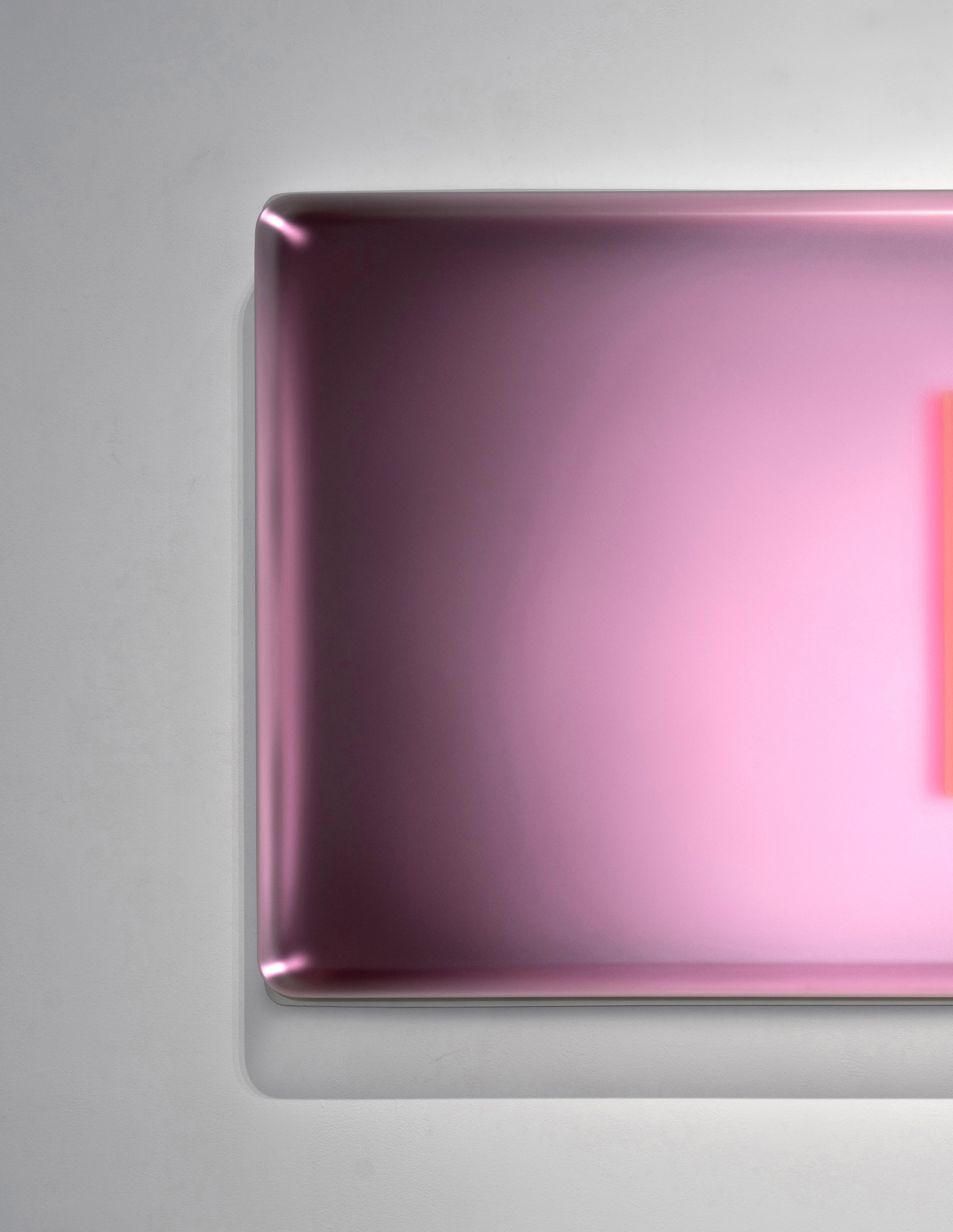


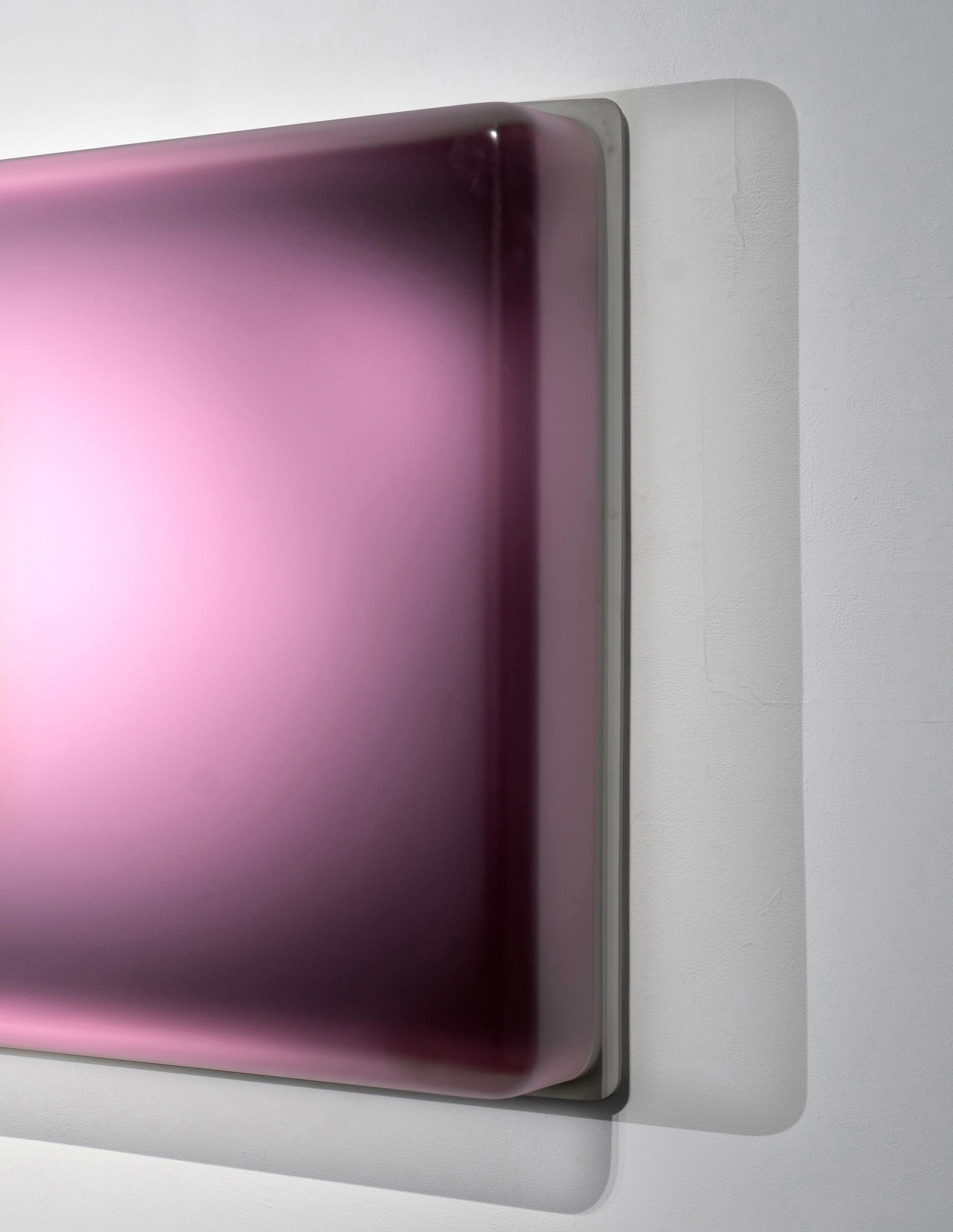
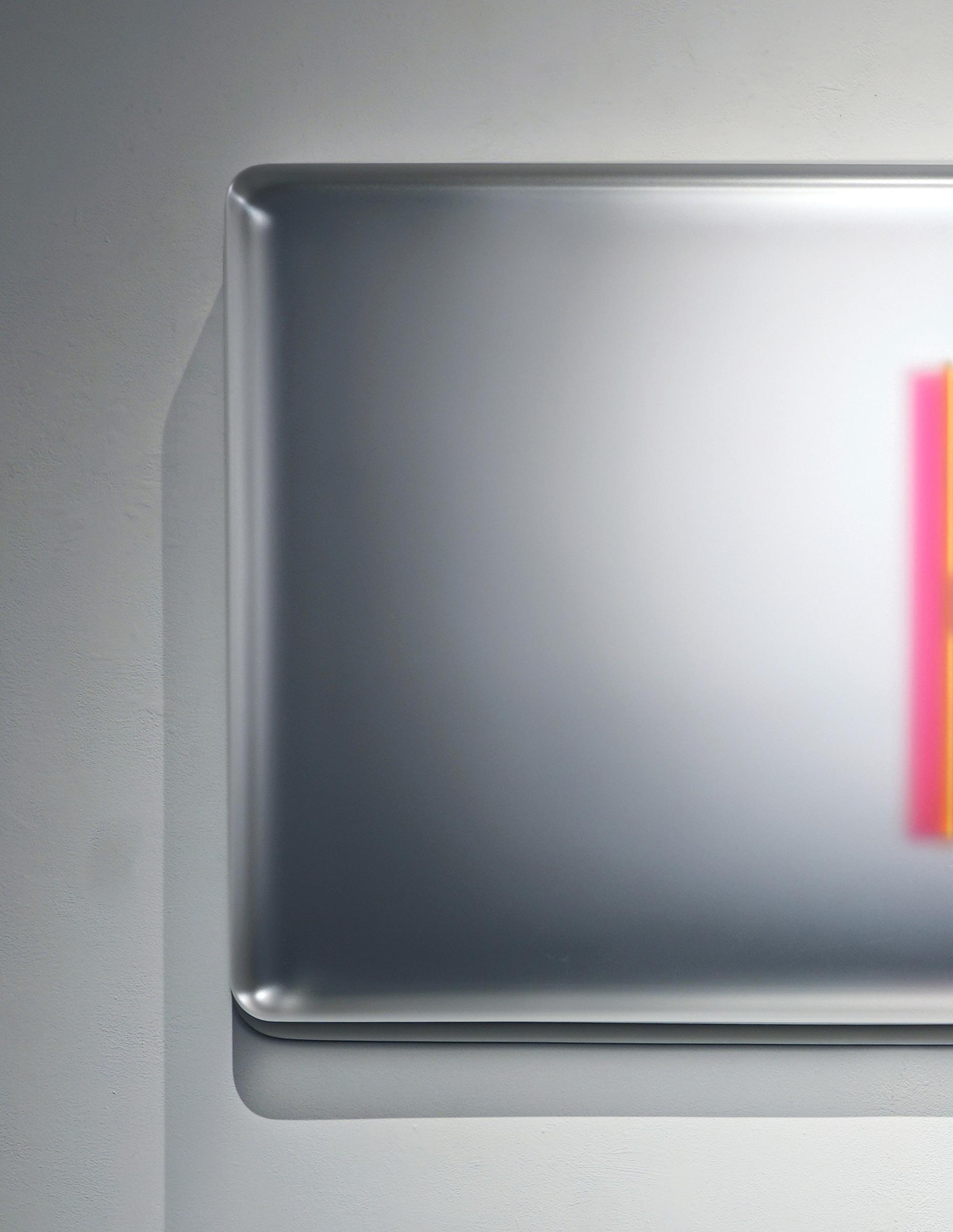
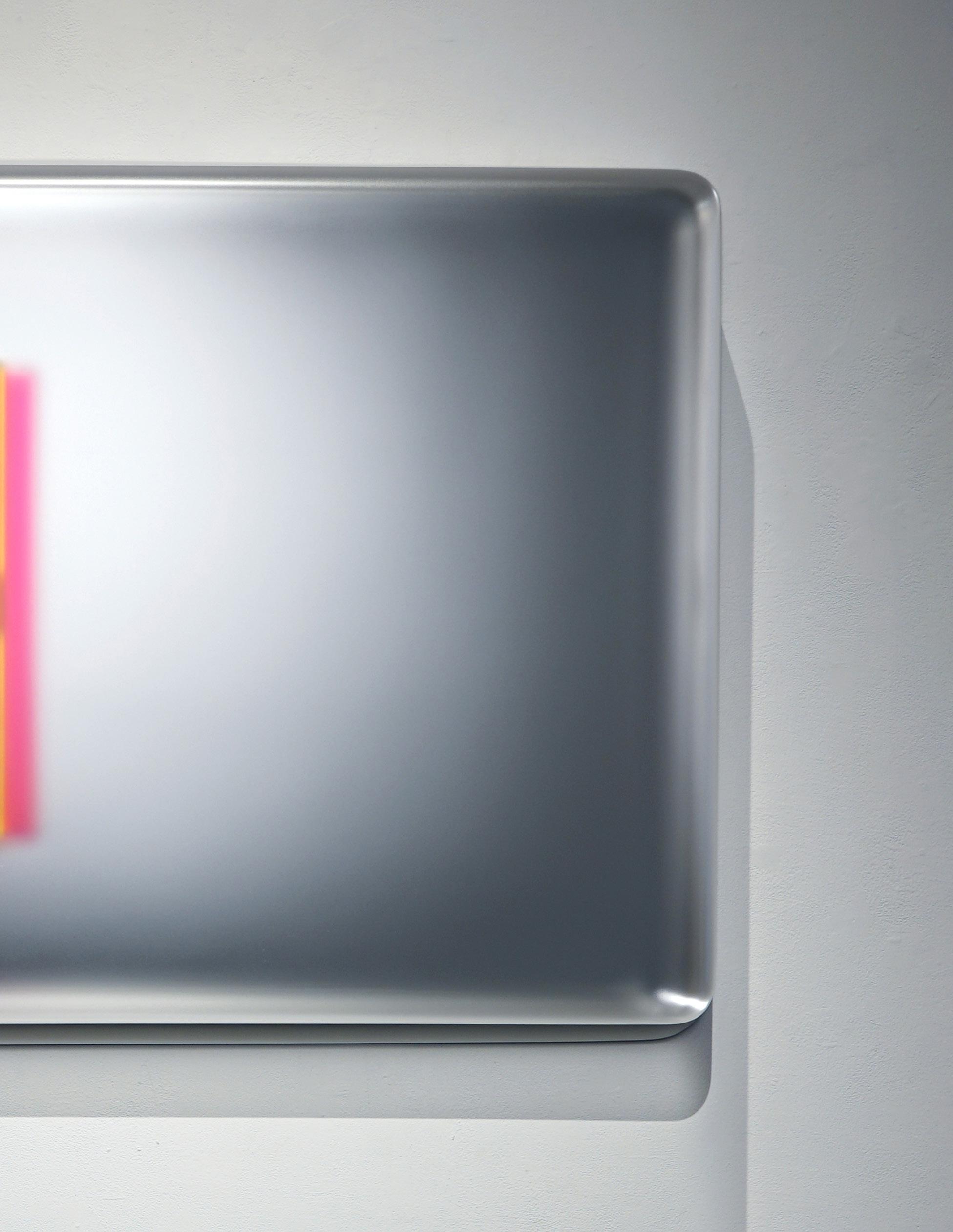
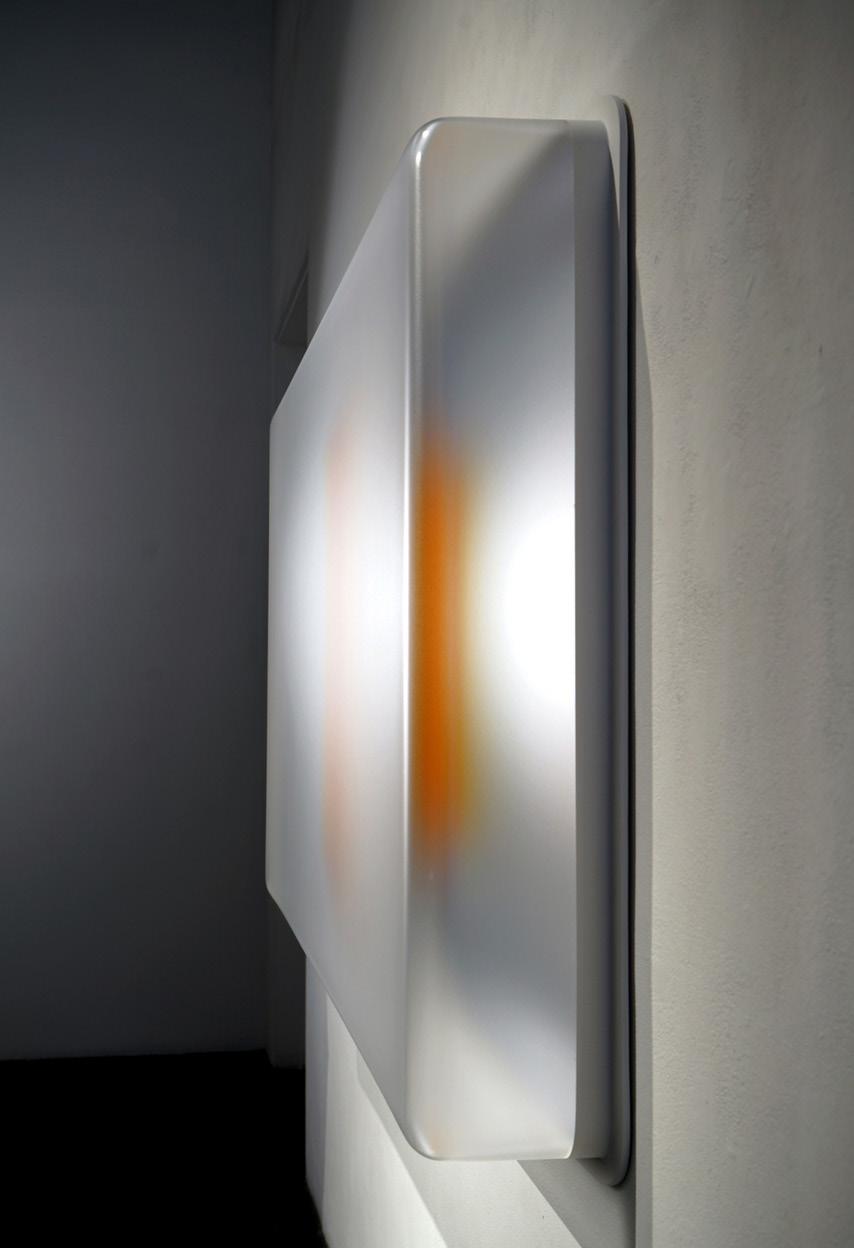


Light-Glyph (Pink)
2024
Vacuumed formed pigmented acrylic
41” x 41” x 5”


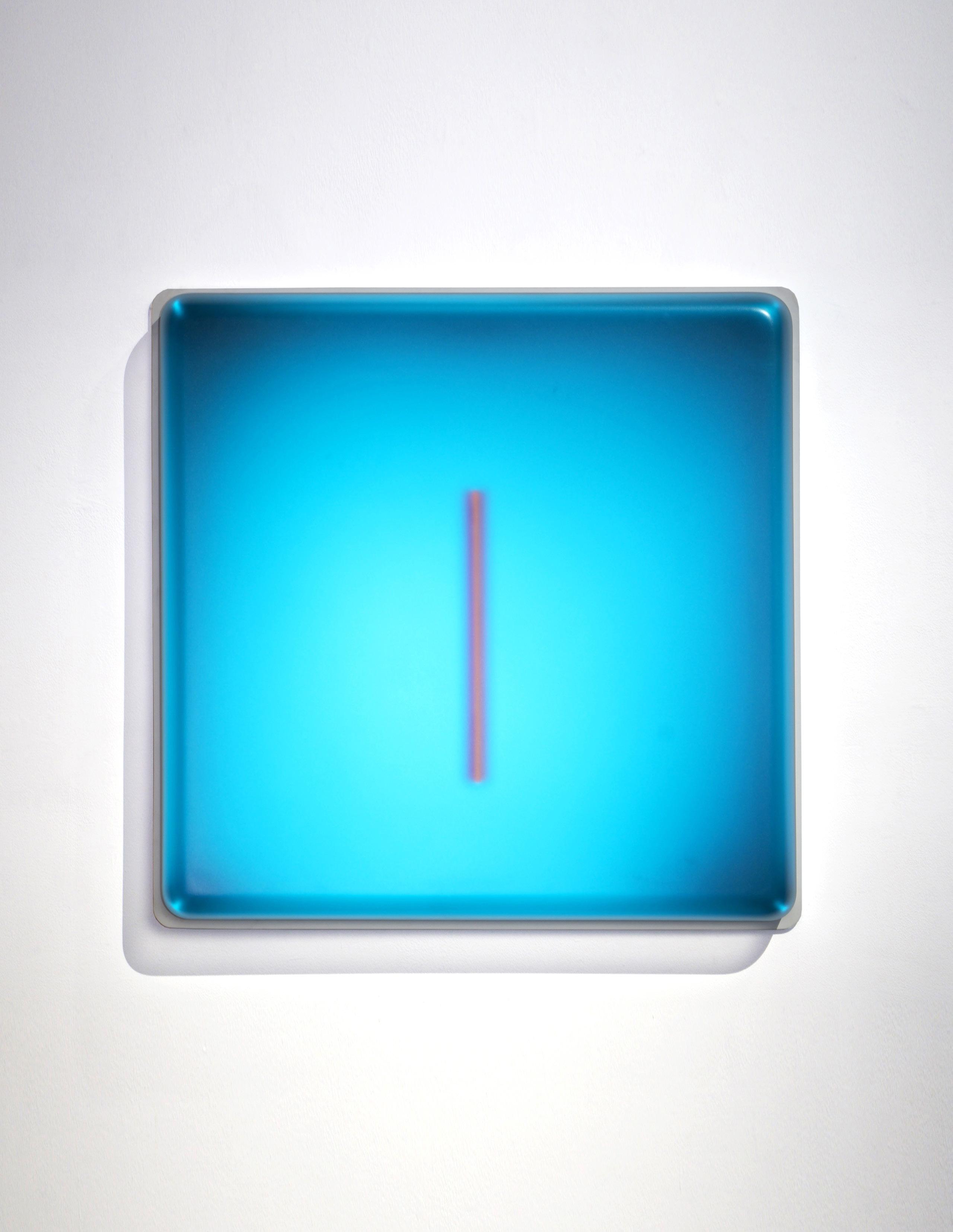

Light-Glyph (Teal)
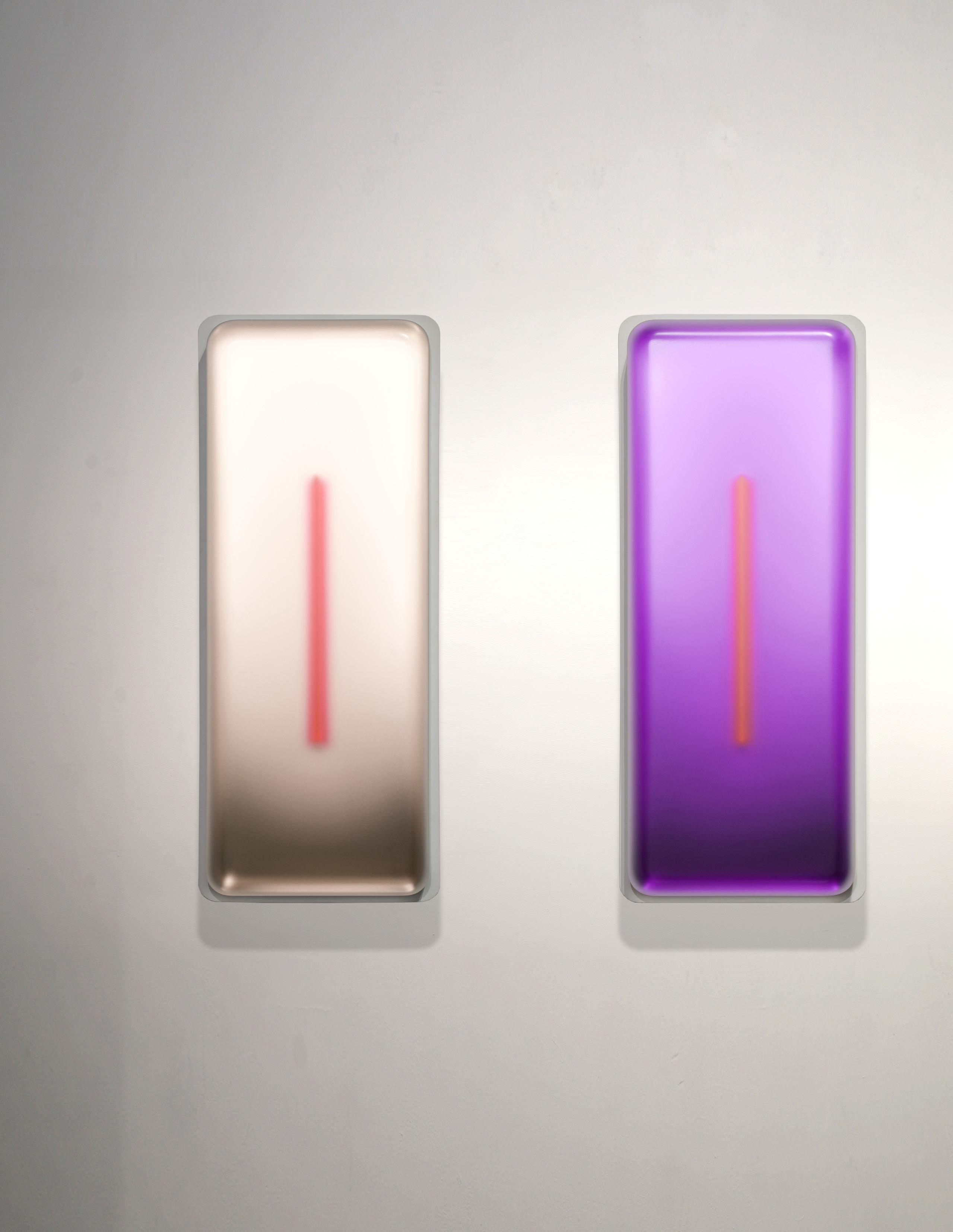
Light-Glyphs , 2024, Vacuumed formed pigmented acrylic, 41” x 17” x 5” each
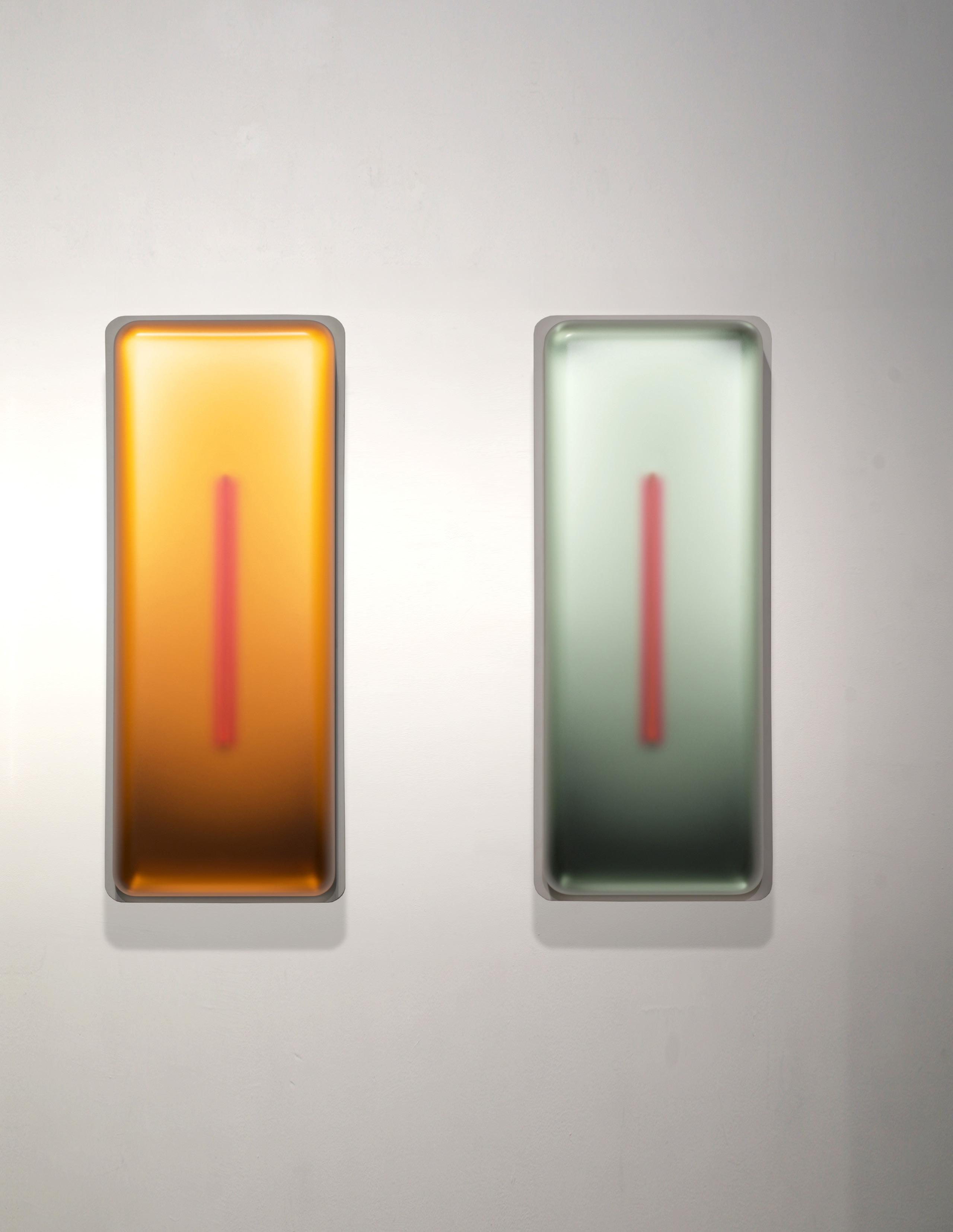
Light-Glyph (Rose Gold) , 2024, Vacuumed formed pigmented acrylic, 41” x 17” x 5”
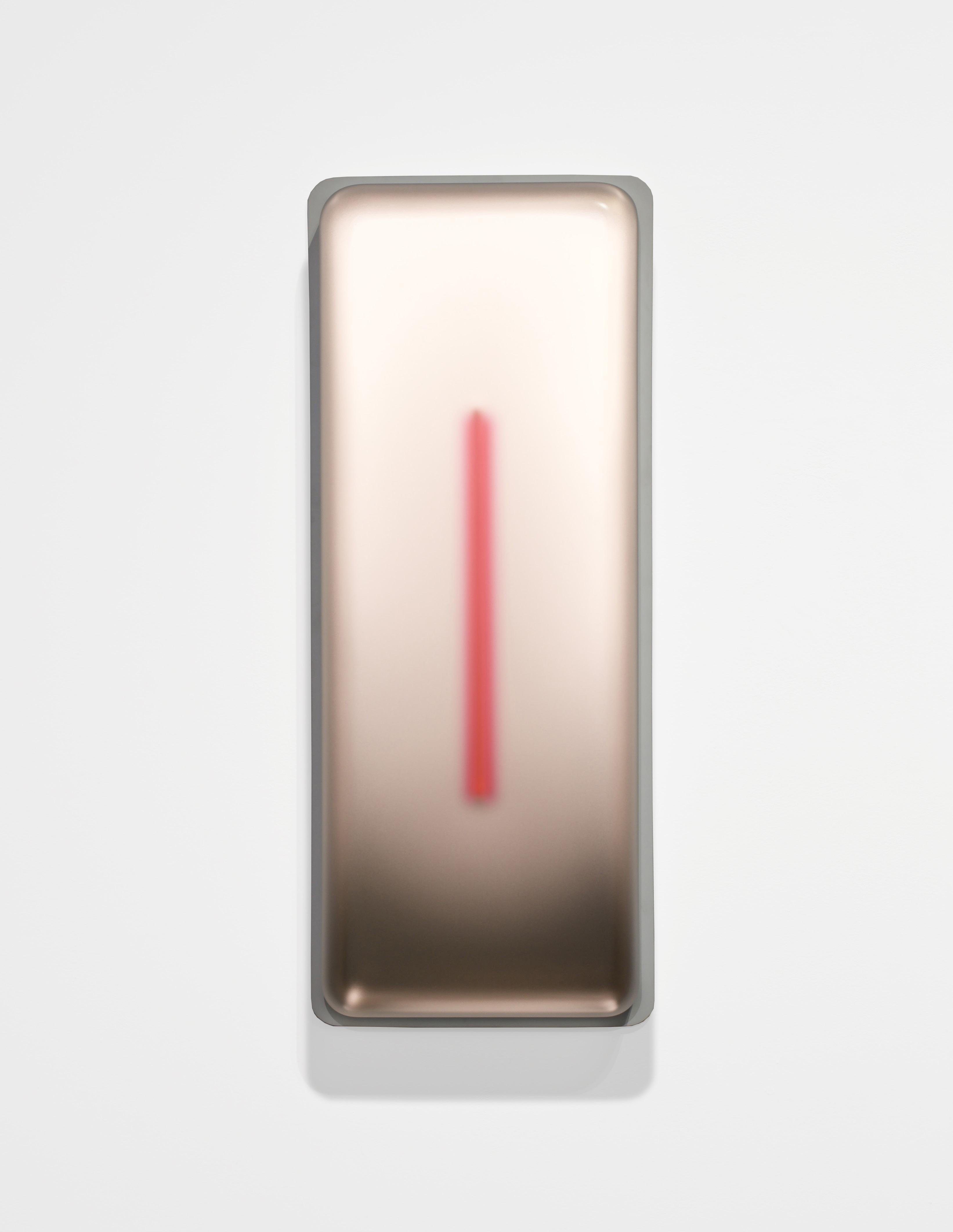
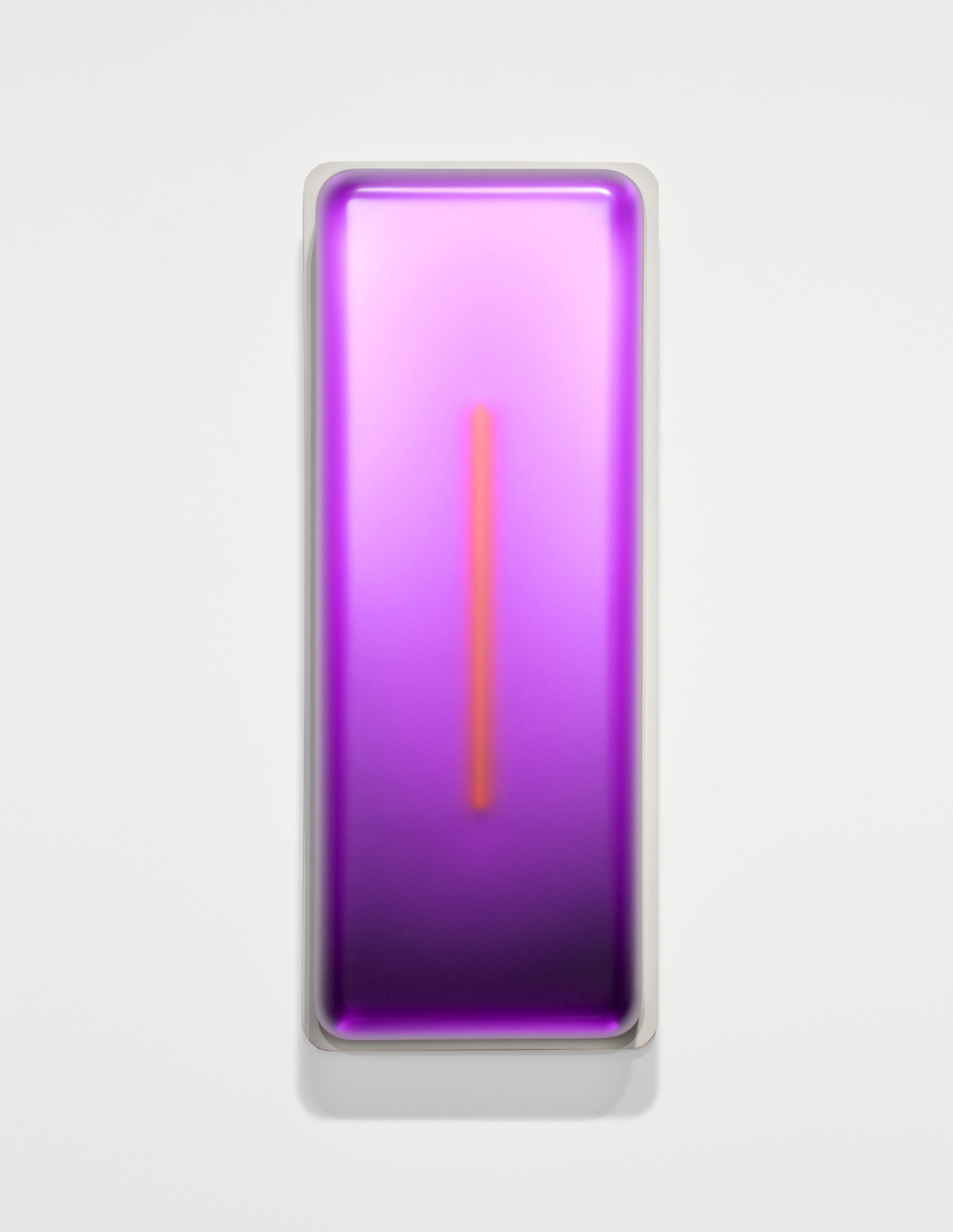
(Purple)
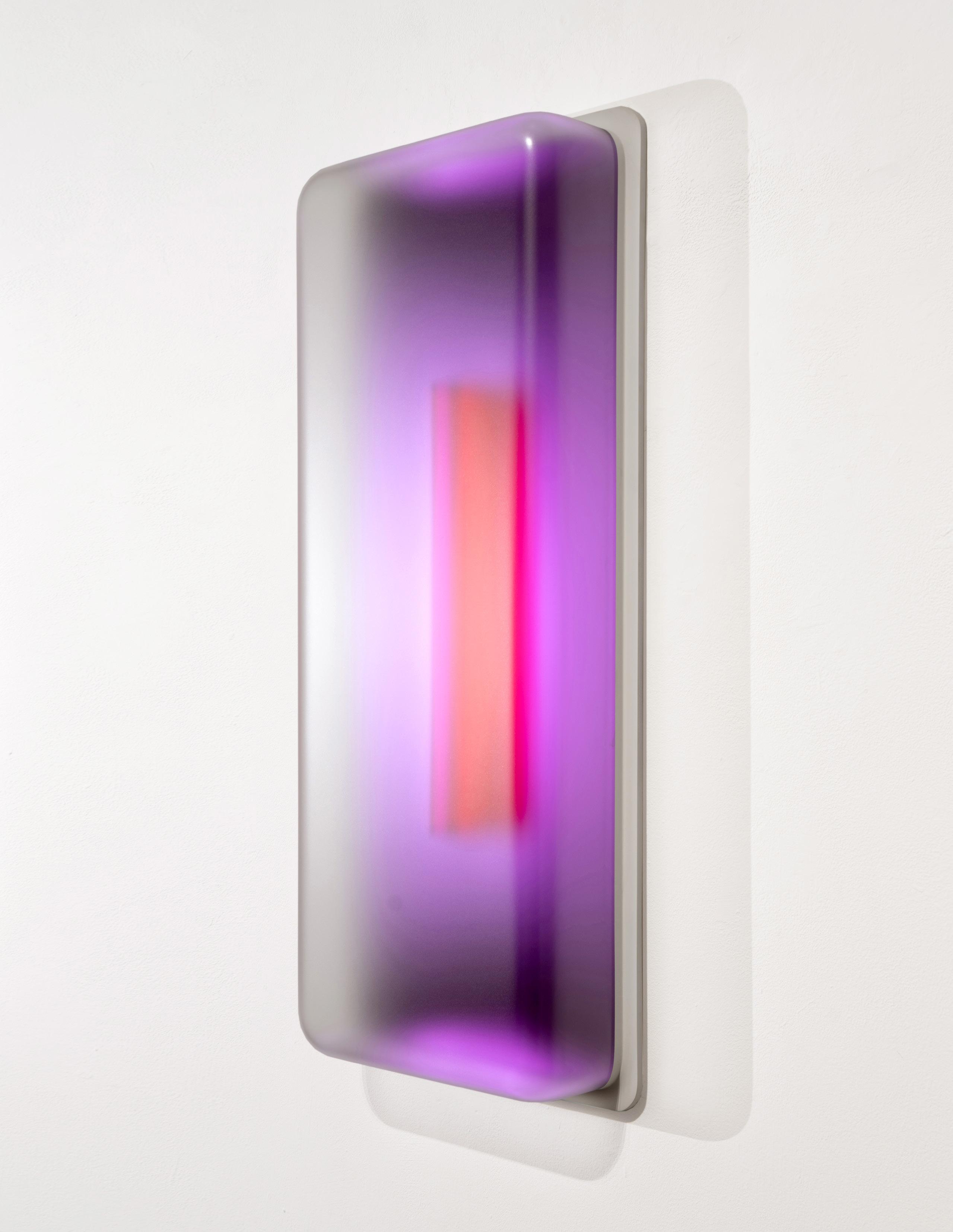
Light-Glyph (Orange) , 2024, Vacuumed formed pigmented acrylic, 41” x 17” x 5”
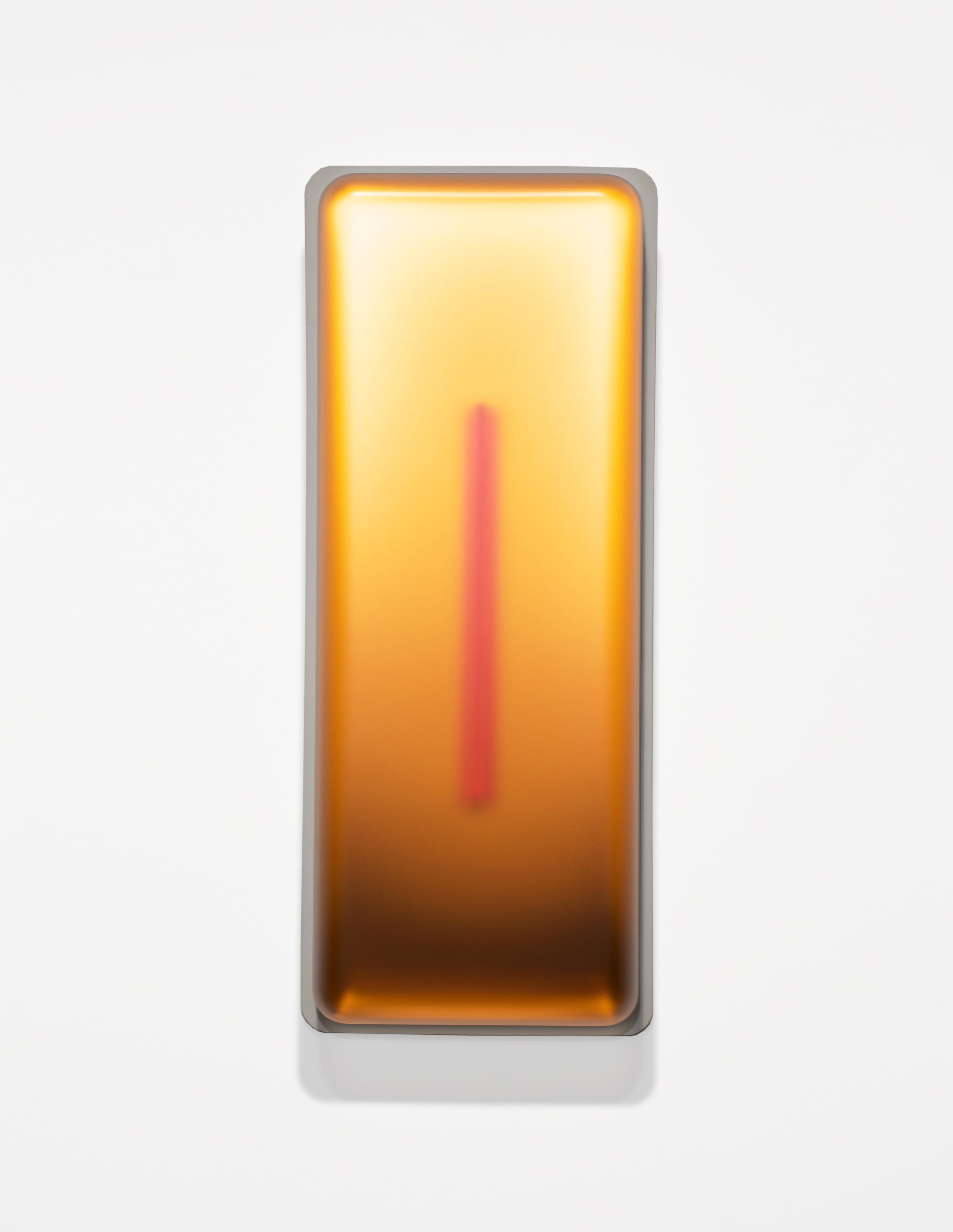
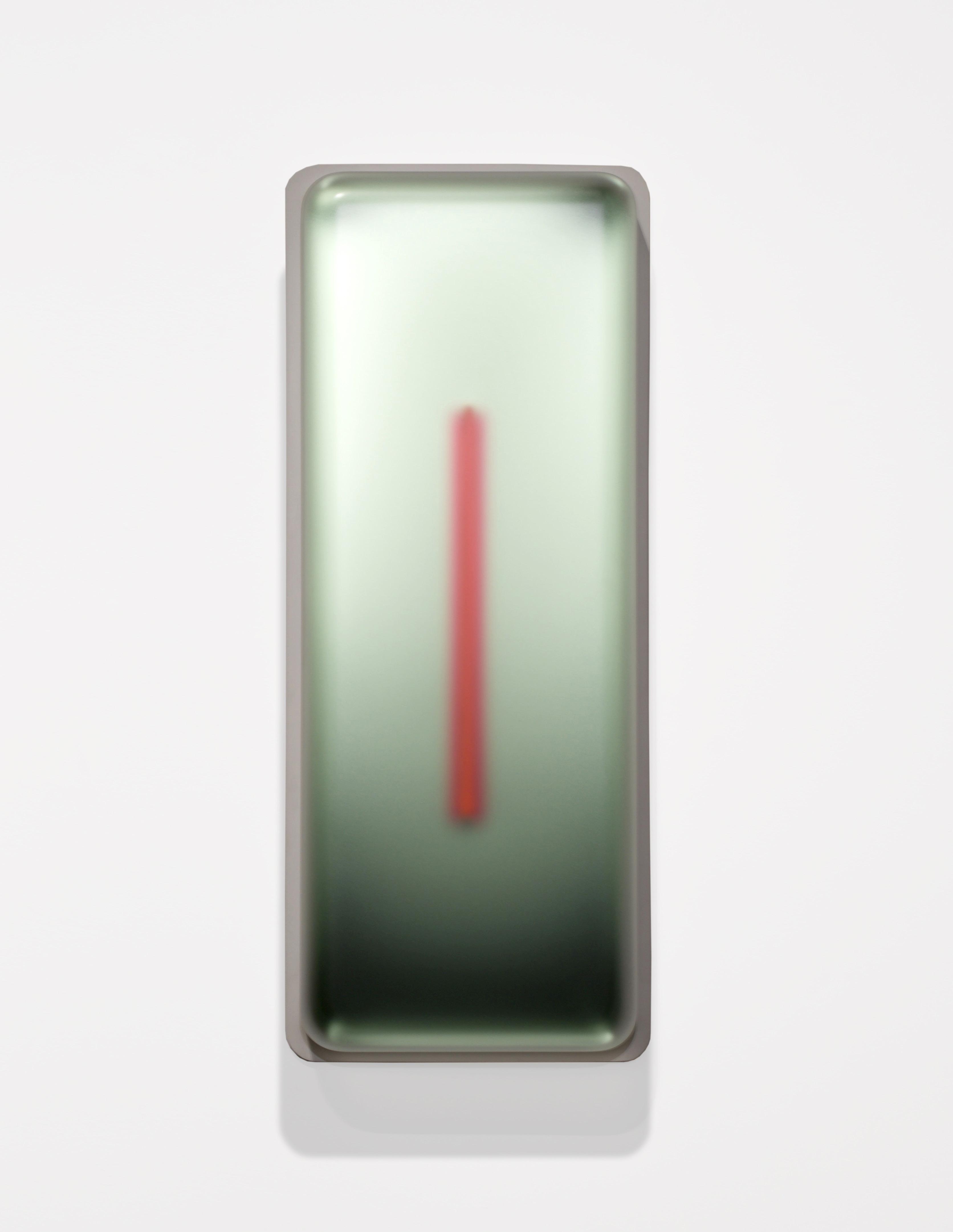


Light-Glyphs (Triptych)
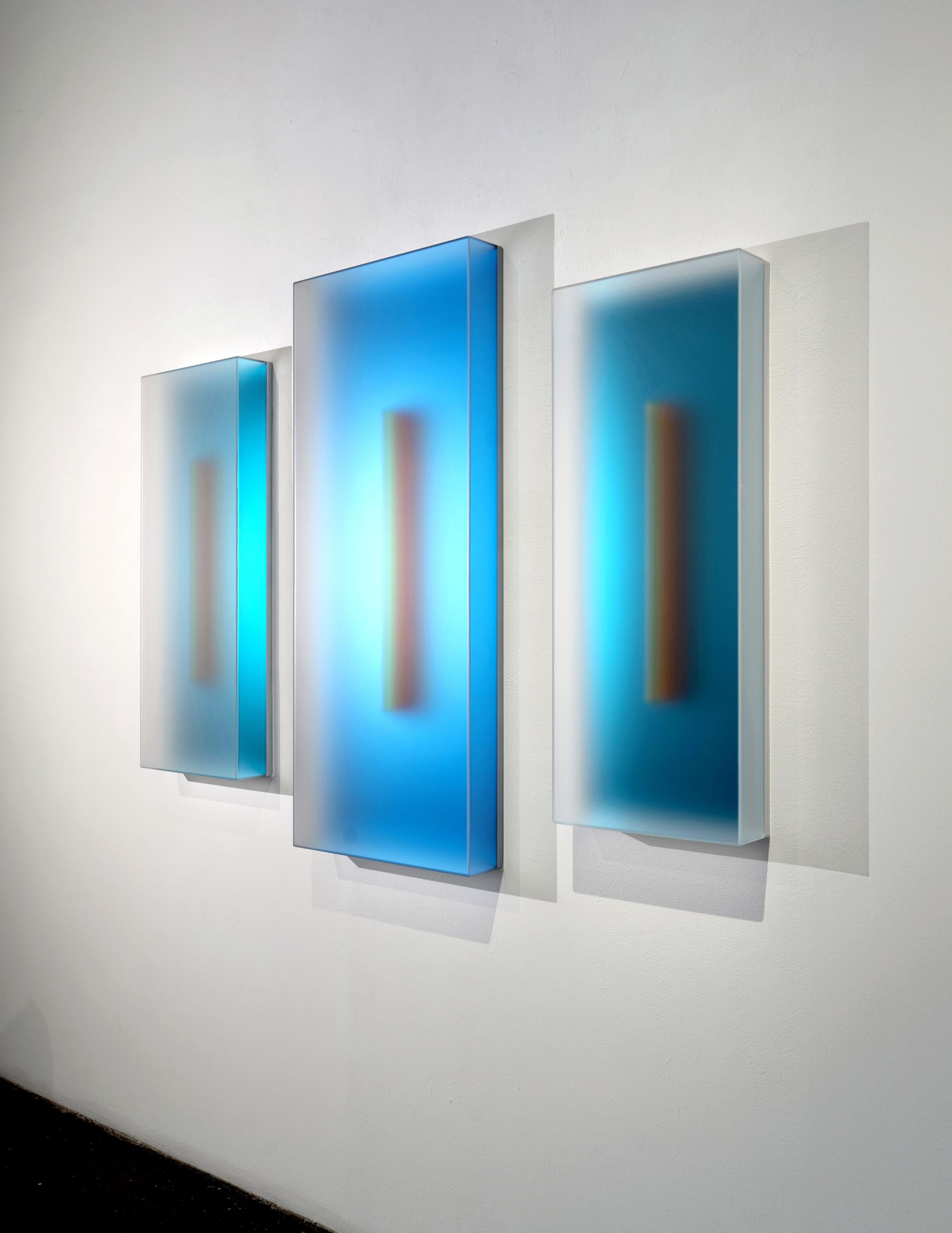
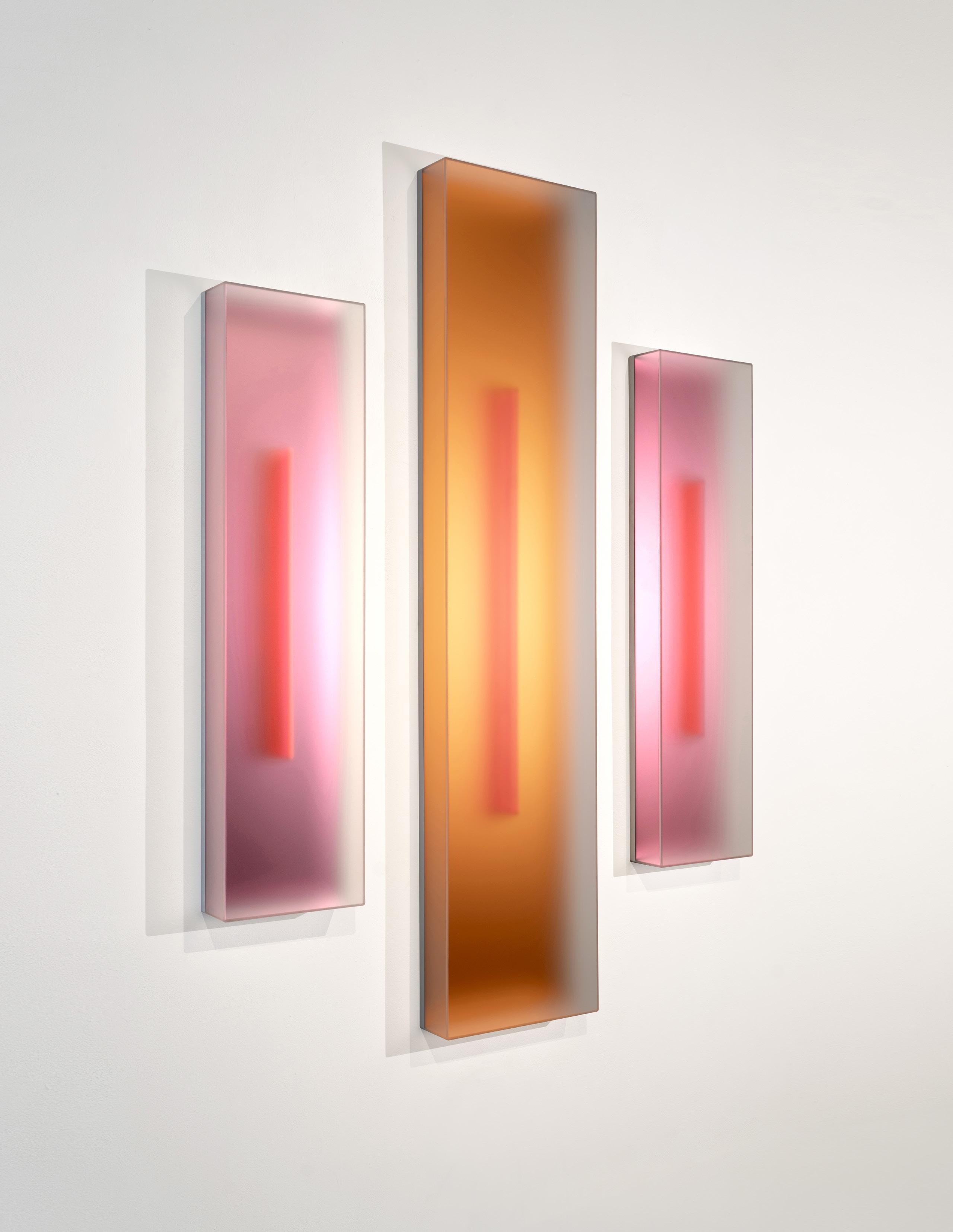
Light-Glyphs (Triptych) 2024


Light-Glyphs (Pentaptych)

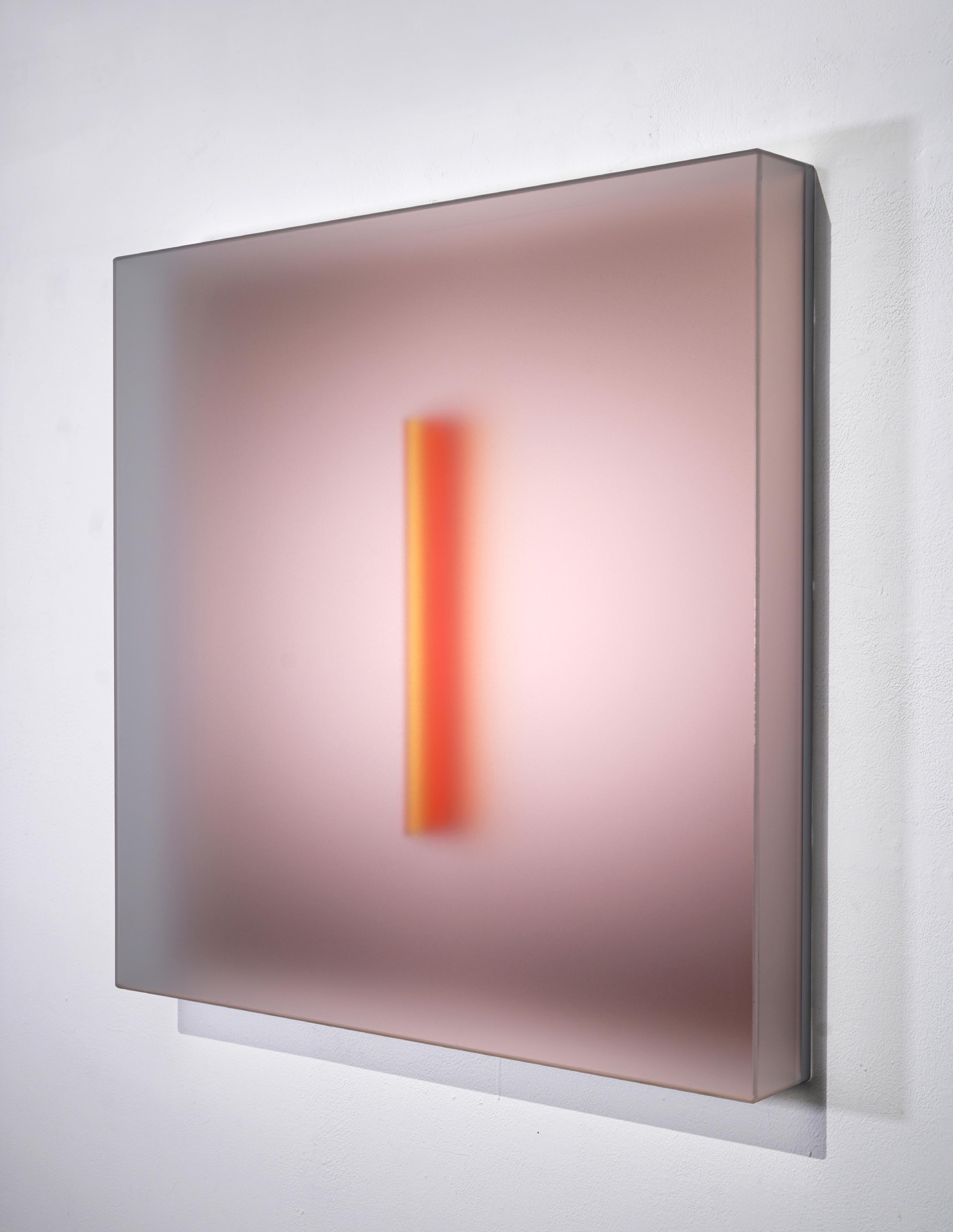


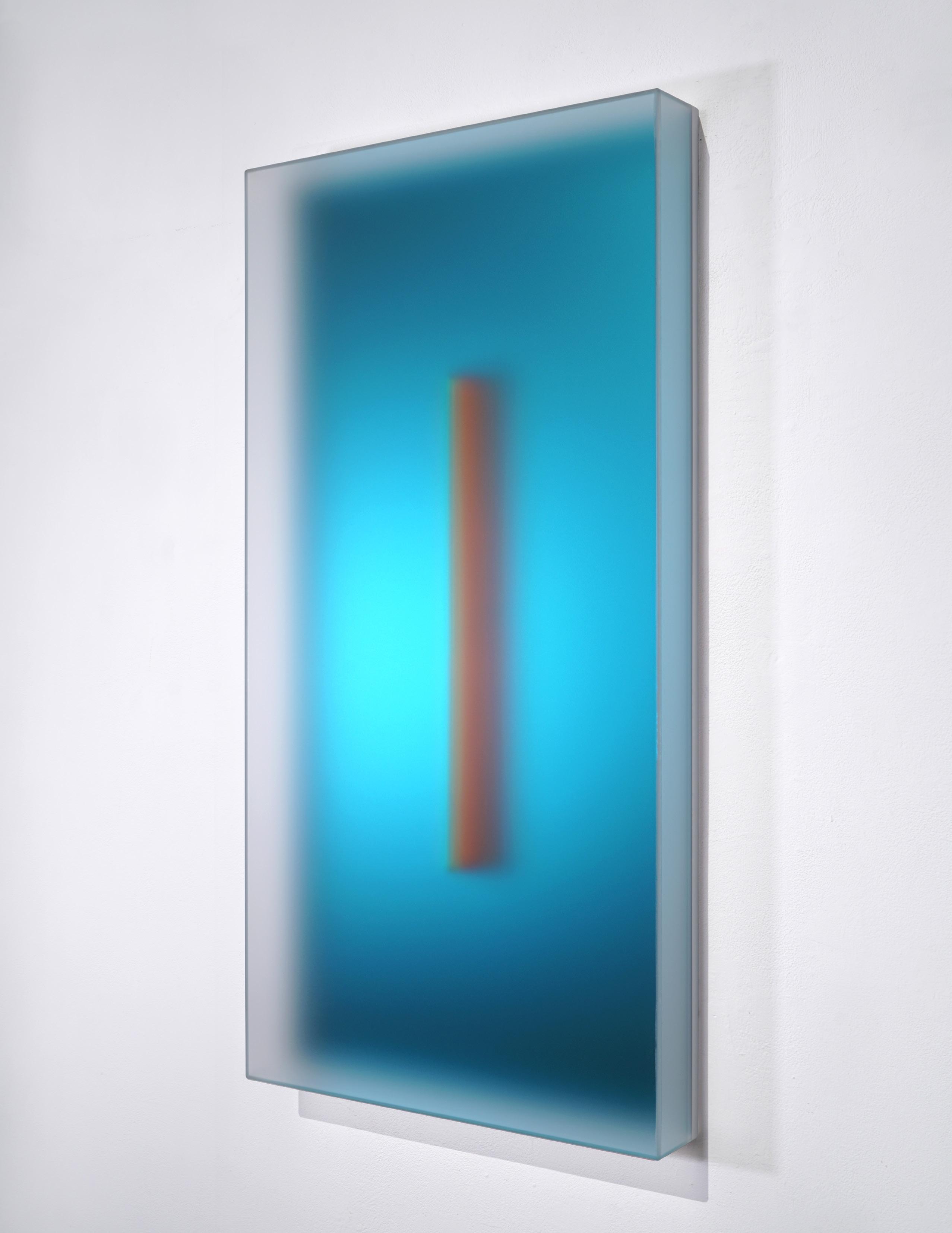
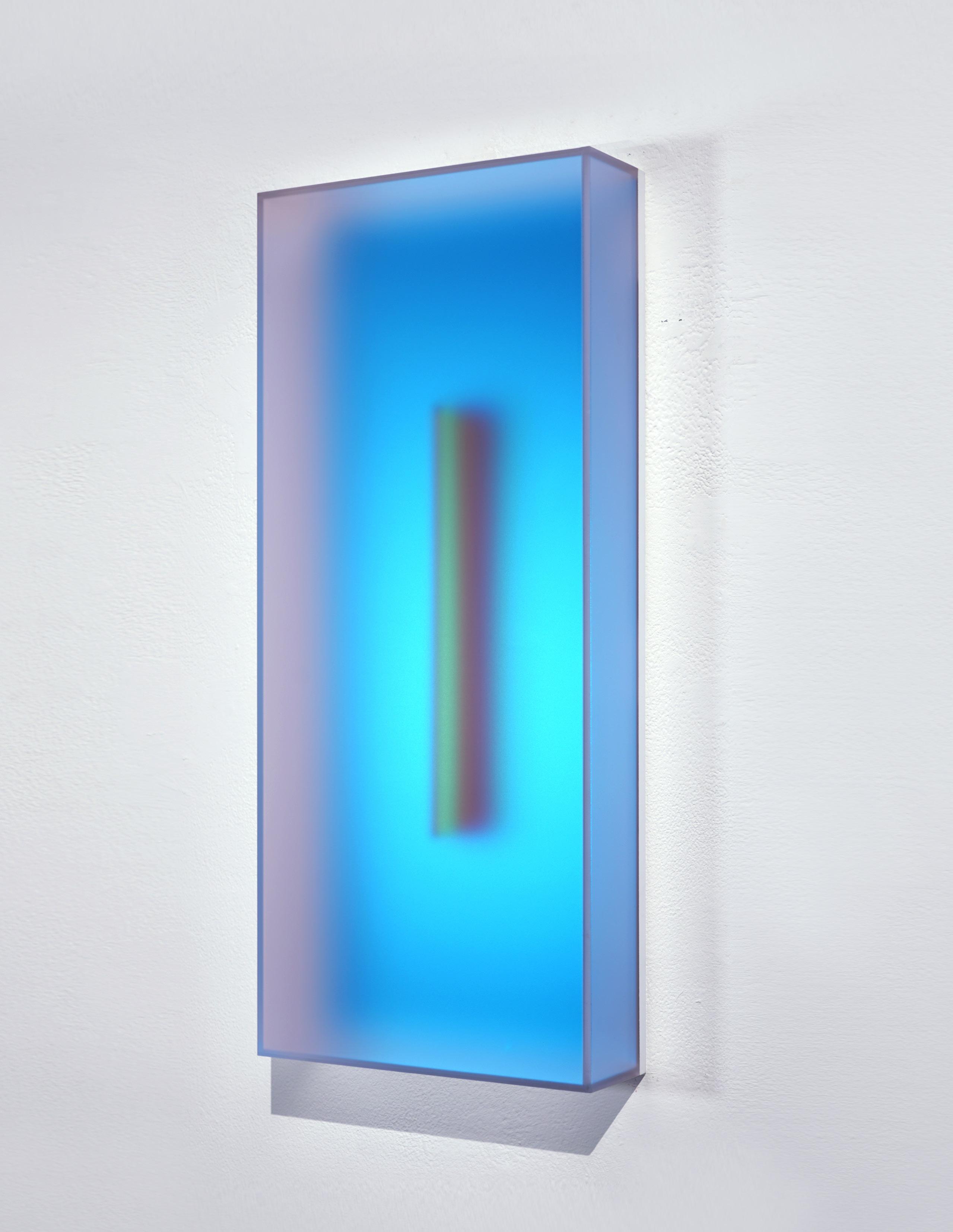
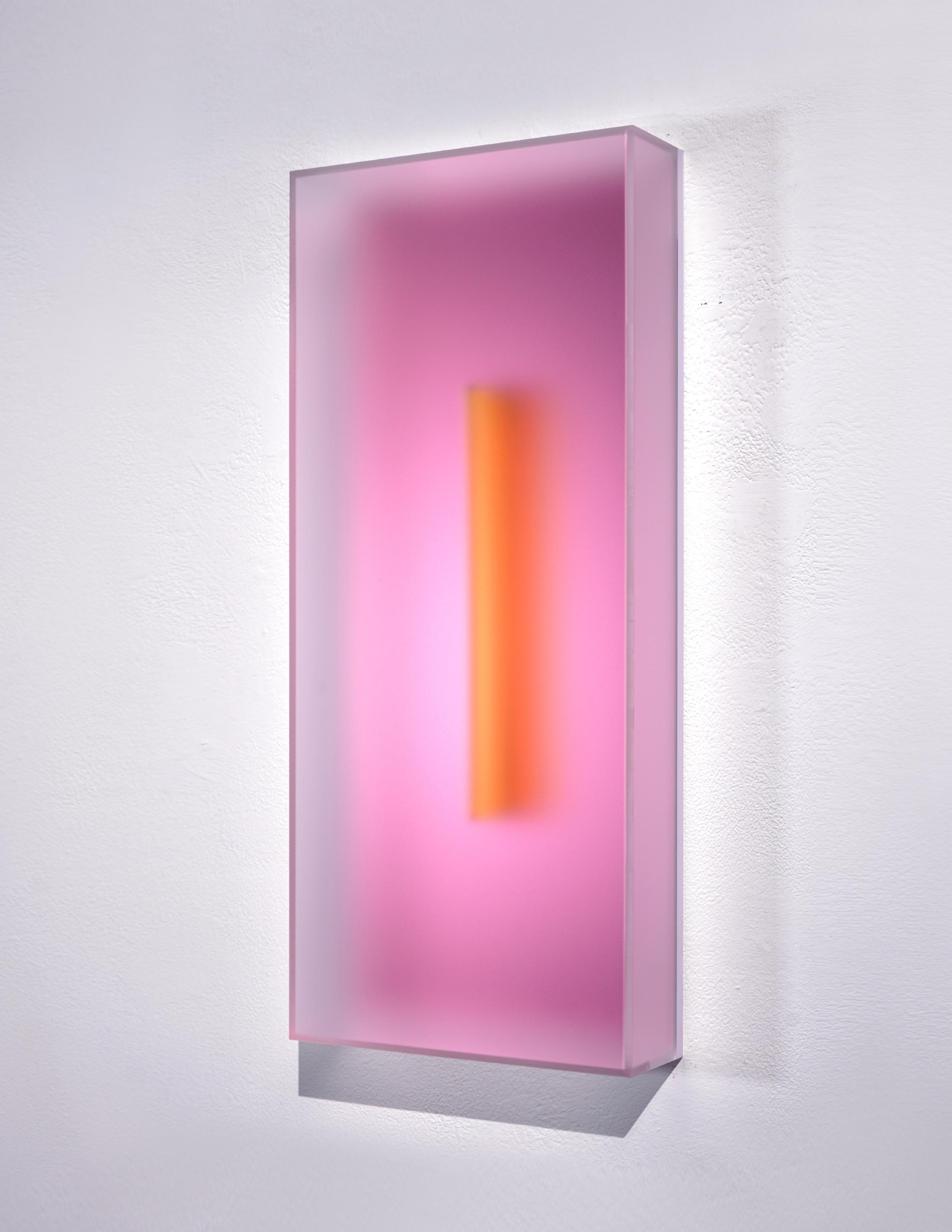
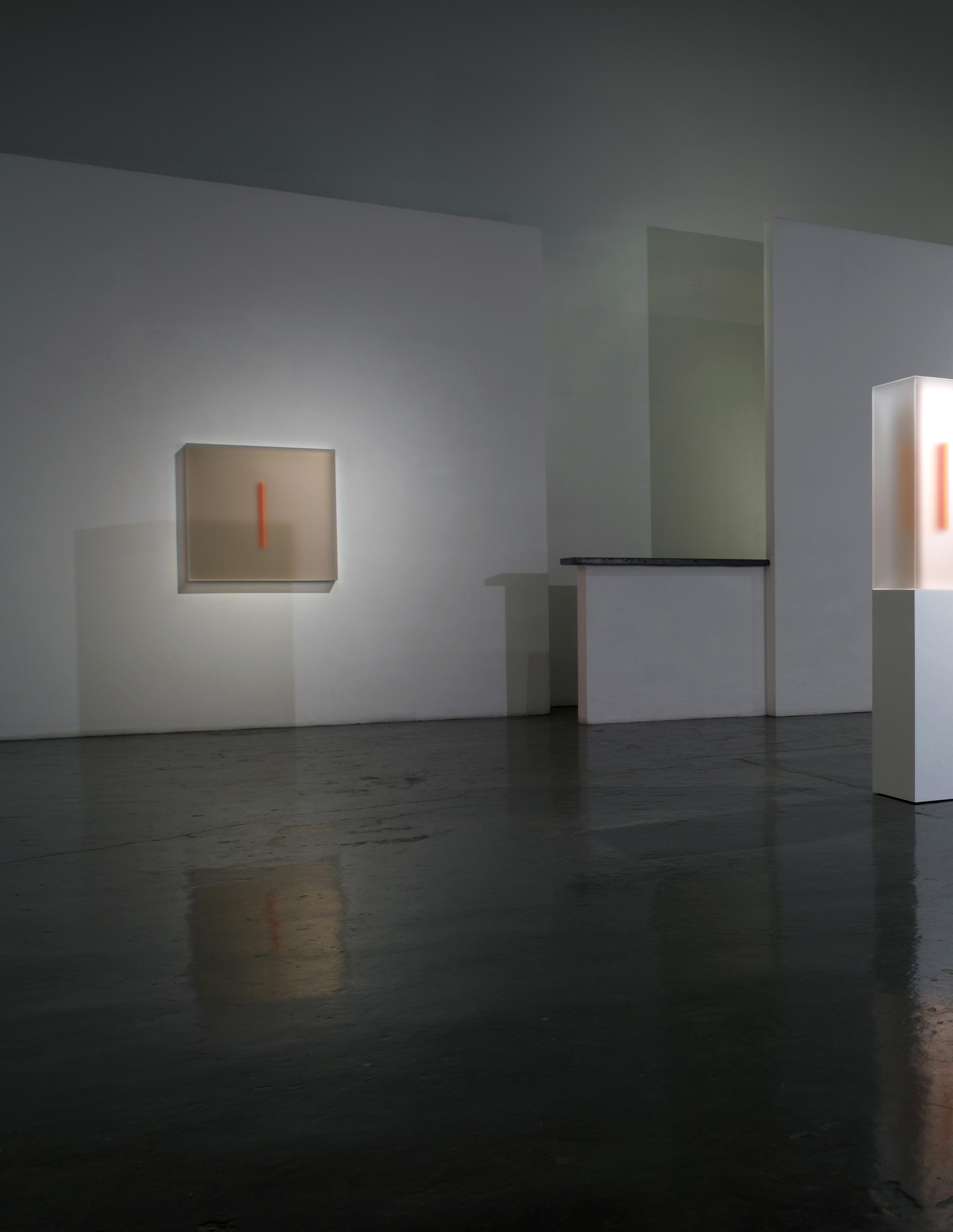


Casper Brindle is a Los Angeles based artist, renowned for his uniquely luminescent, ever evolving body of work. The work ranges from painting to sculpture, and exemplifies Brindle’s restless experimentation and evolving modes of expression. The works are poetic, sensual and spatially dynamic. Utilizing automotive paints and pigmented acrylic, Brindle has created works that reflect and diffuse light in ways that are nuanced and engaging.
Casper Brindle is at the dynamic leading edge of a dialogue, between artwork and viewer, that began in Southern California in the late 60s and early 70s and became known as Light & Space. The shift that began it all was as subtle as it was profound. The idea and purpose of the artwork shifted; from object to catalyst; from looking “at” the artwork to our experience of “perceiving” the artwork. Artists like Robert Irwin, James Turrell, Helen Pashgian, Fred Eversley, and many others, began to explore this notion of how their work could heighten one’s experience and perception. For Casper Brindle, that initial sensibility has been embraced with an adventurous spirit, leading in
boldly new and exciting directions.
Born in Toronto in 1968, Brindle’s family relocated to Los Angeles in 1974 from the United Kingdom. By Brindle’s early twenties, he moved to Venice and became enthralled with the burgeoning art scene there, where many of LA’s cutting-edge artists had studios. It was there that Brindle became immersed in the ideas of Light & Space, with which he has worked ever since.
Through subtle manipulations of materials to alternately absorb and refract light, Brindle has become a key figure in contemporary art. His work has been reviewed by noted art critics and curators, has been exhibited internationally, and was recently the subject of an extensive solo exhibition at the Luckman Gallery Museum at Cal State LA. Casper Brindle’s work is included in many prominent public and private collections, and is in the permanent collections of the Frederick R. Weisman Museum, Laguna Art Museum, the Morningside College Collection in Sioux City, IA, and the Lancaster Museum of Art and History.

